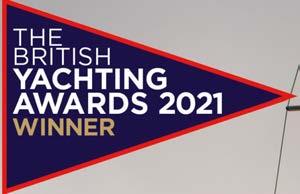ISLAND







































































































It’s time to find the perfect spot for your pride and joy. With 18 stunning locations, MDL has the best cruising grounds and expert teams to take care of your boat. Plus, with inclusive storage ashore and unlimited WiFi, you’ll find the right berth for you.




boat at Chatham.








Corlett-Pitt

















EDITORIAL EDITOR
Sam Jefferson 020 3943 9261 sam.je erson@chelseamagazines.com
GROUP EDITOR Rob Peake
ART & PRODUCTION EDITOR Gareth Lloyd Jones WRITER AND SUB EDITOR Sue Pelling
PUBLISHING CONSULTANT Martin Nott
PUBLISHER Simon Temlett simon.temlett@chelseamagazines.com
ADVERTISING
ADVERTISEMENT MANAGER Mark Harrington 020 7349 3734 mark.harrington@chelseamagazines.com
SENIOR SALES EXECUTIVE


Charlene Homewood 020 7349 3779 charlene.homewood@chelseamagazines.com
GROUP SALES DIRECTOR
Catherine Chapman
HEAD OF SALES OPERATIONS
Jodie Green
ADVERTISEMENT PRODUCTION
Allpoints Media Ltd allpointsmedia.co.uk
CHAIRMAN Paul Dobson
CHIEF FINANCIAL OFFICER Vicki Gavin
MANAGING DIRECTOR James Dobson
Published by:
The Chelsea Magazine Company Ltd Jubilee House, 2 Jubilee Place, London, SW3 3TQ Tel: 020 7349 3700
© The Chelsea Magazine Company Ltd 2020. All Rights Reserved. ISSN 1367-5869 (print) ISSN 2059-9285 (digital)
THEY SAY THAT YOU know you're geting old when policemen start looking young. That might be true but to me a still more accurate gauge is when technology starts to completely ba e you. This has already happened to me sadly and I am regularly left scratching my head as I'm guided through the latest piece of navigation software by some enthusiastic marketing representative. My general tactic is to emit a series of enthusiastic yet noncommittal 'hmmm's', and do all I can to stifle any yawns. It is perhaps for this reason that my own boat remains stubbornly technology free, boasting nothing more than a depth sounder. In general this is su cient but I am well aware that others might find this Luddite approach both annoying and perhaps even a touch risky, given the amount of technological help there is out there to ensure we sail from A to B in comfort and safety.
Yes, whatever your feelings are on tech and yachts, there is one thing that I know I am right about. All of these navigational aids beep WAY too much. From the moment you switch on any of these bits of kit, they emit a reassuring beep to let you know they are working. Fair enough I suppose but from here on they develop a mind of their own. Many is the time that I have been lining up to moor a boat on test when two or three alarms decide to start beeping simultaneously. Often it's to tell you that the depth is low (because you are coming in to moor) or the bow thrusters are activated or have stopped working, or are thinking about restarting. Whatever the reason, it's precisely the sort of distraction you do not need as you are backing in to moor your boat. Similarly, I recently helped deliver a very smart brand-new yacht across the Med. Night watches were balmy and magical; the boat forging ahead across silvery waves gilded by the sea of stars overhead. In the magical silence you became entranced by the stars, the infinite beauty... then...BEEEP! You were regularly jolted from your reverie by some pointless alarm . I asked the skipper what it was for and he just shrugged and showed me how to mute it. I am therefore o cially launching a campaign to silence the beeps.
Online: Did
know
can
Oversee your
and digital subscriptions online today simply by signing up at https://www. subscription.co.uk/chelsea/Solo/. Stay up to date with the latest issues, update your personal details, and even renew your subscription with just a click of a button.
Post: Sailing Today, Subscriptions Department, Chelsea Magazines, Tower House, Sovereign Park, Lathkill Street Market Harborough LE16 9EF
The
Magazine Company Ltd makes every
Chelsea Magazine Company Ltd full set of terms and conditions please go to chelseamagazines.com/terms-and-conditions
JESS LLOYD MOSTYN is a writer and blue water cruiser who is currently moored in Singapore

twitter.com/ SailingTodayMag editor@ sailingtoday.co.uk

TOM CUNLIFFE is an author, journalist and TV presenter, and one of Britain's best-known cruising sailors


ANDY RICE is a journalist and veteran dinghy racer who has won championships at both ends of a ski


Dinan Marina is on the beautiful Canal d’Ille-et-Rance – the inland waterway that connects the Atlantic Ocean and English Channel. Located in town of Dinan, and home to a 14th-century castle, this is a real beauty spot to explore when transiting the Canal.
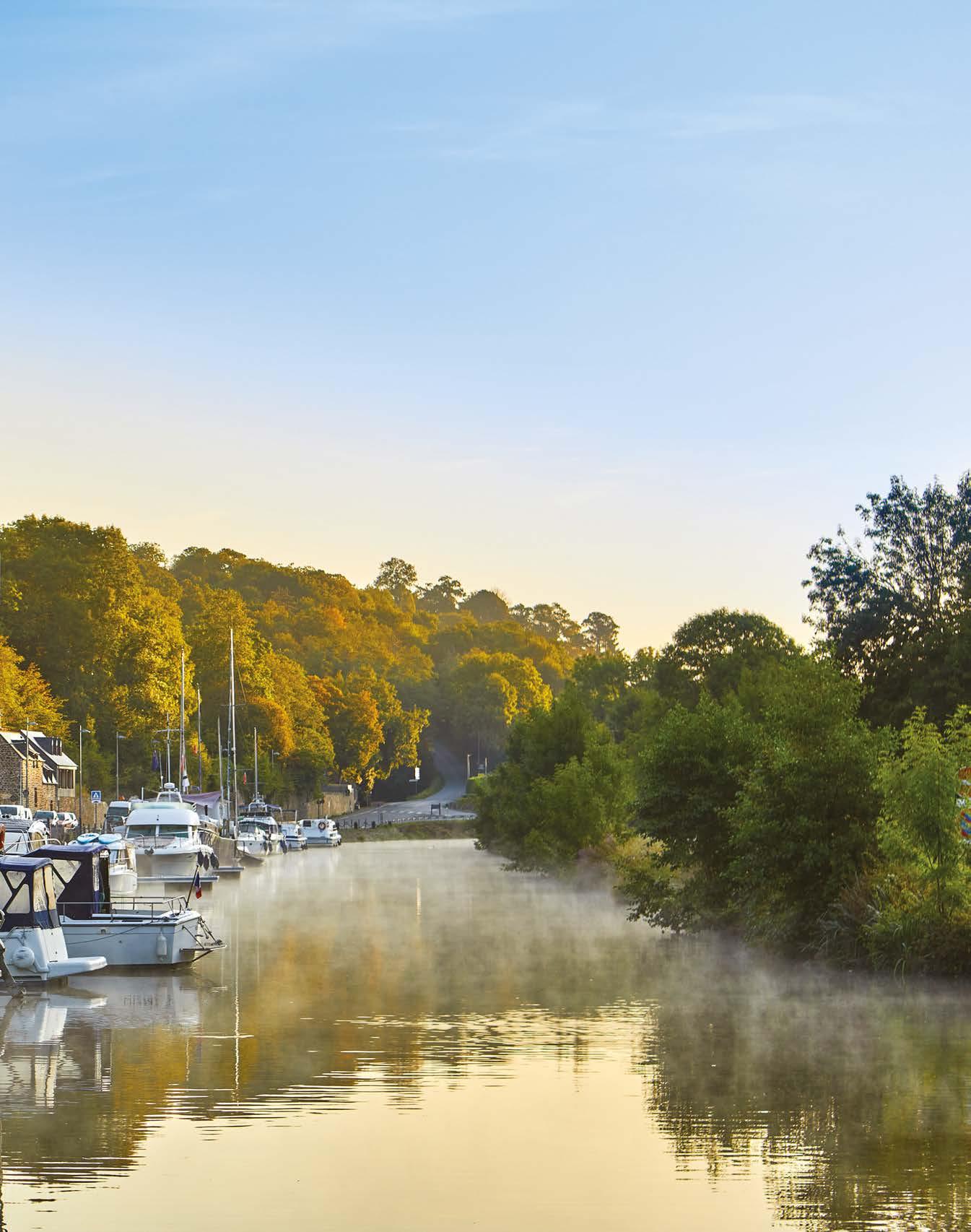 Photo: Gary le Feuvre/iStock
Photo: Gary le Feuvre/iStock




Dramatic styling combined with a dramatic turn of speed make for a photo that captures the power of a fast boat, hard driven. In this case it’s the ClubSwan 80 My Song being pushed hard on her sea trials. The boat is owned by Italian businessman Pier Luigi Loro Piana.
 Photo: NautorCommunication
Photo: NautorCommunication
Voting is still open for our British Yachting Awards until midnight on Sunday 6 November – and Sailing Today with Y&Y readers can book limited tickets to the event via a link below.
We organise the awards annually with our parent company Chelsea Magazines to celebrate the best of the racing and cruising worlds.
It’s up to you to decide the winners – you can cast your votes after persusing the nominations, listed online at britishyachtingawards.com.
There are categories for the best new boats launched in the last 12 months, the best pieces of new sailing kit and clothing, the best marinas, as well as categories that recognise personal sailing achievements.
The winners are announced and trophies presented on 28 November, at an exclusive ceremony at the Royal Thames Yacht Club in Knightsbridge. Limited tickets for this event will be released for sale nearer the time – watch this News section and online. The winners are also revealed in our February issue, published on 30 December in the UK.
Among the nominees are 16-year-old Cal Currier who sailed solo across the Atlantic, the 22-year-old White triplet brothers who won
Marine insurance specialist Pantaenius is sponsoring the Sailor of the Year category in the British Yachting Awards.
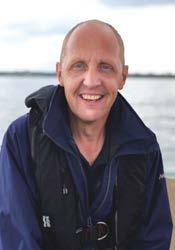

Pantaenius supported the category last year, when octogenarian Murdoch McGregor won the vote after having sailed solo around Britain.
Simon Hedley, Pantaeniuis’ Head of Commercial Partnerships (pictured left), said: “The Pantaenius Group has been at the heart of sailing for over 50 years, and we are proud to sponsor theSailor of the Year award. The dedication and commitment of the nominees must be collectively celebrated and promoted to inspire others.”
Nominees in the 2022 Sailor of the Year category are: 83-year-old Kenichi Horie who sailed solo across the Pacific; 20-year-old Ellie Driver who completed the Round Britain & Ireland Race, with her father Jim; the crew of Ziggy, for their Cowes Week performances on a budget; the crew of Dark n Stormy, for their summer of racing success at Cowes Week, the Round the Island Race and elsewhere; Richard Palmer and Rupert Holmes on Jangada for winning the Sevenstar Round Britain & Ireland Race.
silverware at Cowes Week, and the school-age crew of Embley, who won the Round the Island Race’s ISC category, beating more than 500 entries – as well as the best boats, events, marinas and sailing kit of the last year.
Group editor Rob Peake said: “There are always some great stories among the British Yachting Awards nominations and 2022 has come up trumps with a series of heart-warming and impressive personal and crew achievements on the water. The industry, meanwhile, never ceases to innovate and evolve and our shortlist reflects that.
“We are proud to have seen the British Yachting Awards become a highlight of the marine industry calendar. It’s a moment when we can pause and take stock of the greatest achievements in the sailing world. The category shortlists are put together by our editorial team and expert panel of contributors.
“Now it’s up to you, our readers, to decide who wins.”
Vote at britishyachtingawards.com and book your ticket, including a champagne and canapés reception, for £90, via sailingtoday.co.uk
The Centennial Celebration of the Cruising Club of America was held at Newport, Rhode Island, in September.

The esteemed yacht club invited all its Blue Water Medal recipients to attend, including our correspondent Bob Shepton, who was given the medal for a circumnavigation he completed with a crew of young people some years ago.
Others included Jean-Luc Van Den Heede who has sailed six circumnavigations, and Randal Reeves and Steve Brown, who completed figure of eight voyages round the Americas via the NorthWest Passage and Cape Horn. Sir Robin Knox-Johnston gave an entertaining talk on his life at sea. There was also a talk called Heavy Hitters on Heavy Weather, by Sail Magazine, combining the wisdom of Randall Reeves, Rich Wilson, Jean-Luc, Steve Brown, and chaired by Frank Bohlen, Emeritus Professor of Marine Sciences, on ways of combatting heavy weather.
Bob Shepton presented a talk about the late Bill Tilman, also a Blue Water Medal recipient, called Tilman’s Legacy in the Modern Age. Bob said of his own exploits, sailing in high latitudes: “It was Tilman’s innovative vision to sail to remote regions and climb mountains from the boat. Maybe we were taking his vision to extremes.”
Co-organised by our columnist Andy Rice (see page 20), the 14th edition of the Seldén SailJuice Winter Series kicks o with the Fernhurst Books Draycote Dash on 19-20 November.

Seldén is back for the fourth year as title sponsor of the series, which since 2009 has aimed to provide “the fairest possible handicap racing for small boats in the UK”.
Founder Andy said: “Seldén has stayed with us through a very tough couple of seasons and we’re hoping that this will be the first season since the pandemic to be completed without any hitches or setbacks.”
As ever, the series aims to appeal to as many classes as possible, with typically almost 100 di erent types of boat represented across the season, from fleets as diverse as the traditional Norfolk Punt and National 18, to niche classes like the Hadron H2 singlehander.
Some fleets choose to use some of the events as their class championship, such as the RS Aero, which typically brings up to 50 boats for the concluding event of the season, the Oxford Blue. Contact Simon Lovesey if you’re interested in choosing one, some, or all the events in the series to form your own class championship, at simon.lovesey@sailracer.co.uk.

There have never been so many IMOCA entries in the famous two-week transatlantic race, now called La Route du Rhum-Destination Guadeloupe, which sets o from Saint-Malo on 6 November. With 37 boats set to take the start line, there are more podium contenders than in any previous edition. The British sailors include Pip Hare on Medallia, Sam Davies on a new Initiatives Coeur 4, and the young James Harayda on Gentoo (pictured).
The 2018 edition saw a dramatic finish with Paul Meilhat taking the IMOCA title. He returns with a new boat in the colours of his new sponsors Biotherm. His is just one of seven new IMOCAs which have been launched over the last four months. There are four pairs of sisterships now, creating some fascinating races within the race. Vendée Globe winner Yannick Bestaven’s new Maitre Coq V is a Verdierdesigned sistership of 11th Hour Racing-Mâlama, while Sam Davies’ new Initiatives Coeur 4 is sistership to the Sam Manuard-designed L’Occitane en Provence Three boats come from completely new moulds. There is the Verdier Holcim – PRB by Kevin Esco er, Manuard’s Charal2 by Jérémie Beyou and the VPLP designed new Malizia – Sea Explorer of Boris Herrmann.
Kévin Esco er (Holcim - PRB) believes that the “new boats will not be favourites, it is will be the boats of the 2020 generation that are more reliable that will have the advantage”. The dominant Charlie Dalin (APIVIA) and Thomas Ruyant (LinkedOut) both have new IMOCAs in build and this will be their last race with their current monohulls. Dalin, second in the Vendée Globe, is the recent winner of the Guyader Bermudes 1000 Race and June’s Vendée Arctic race and remains undefeated this season. But he has never competed in the Route du RhumDestination Guadeloupe, while Thomas Ruyant, who won the Transat Jacques Vabre last year is also a contender for the win.
There are also 13 rookies, including Swiss sailors Justine Mettraux (Teamwork. net) and Oliver Heer (Oliver Heer Ocean Racing), the Chinese Jingkun Xu (China Dream-Haikou), and James Harayda.
Juliet Costanzo of Australia and the crew of Easy Tiger Racing take a cooling leap overboard as they prepare for the Corfu round of the Women’s
Match-Racing Tour – the 2022 EUROSAF Women’s European Championship. Twelve of the world’s top women’s match racing teams were in Corfu for the event in October. The Tour claims to be the “world’s first and only professional sailing series for women”. Also competing was British skipper Sophie Otter with her Otter Racing Team of Scarlett Anderson, Amy Sparks, Hatty Ward and Hebe Hemming. womenswmrt.com

Wendy Schmidt and the crew of Deep Blue won the 54th edition of the Barcolana presented by Generali, which was held in Trieste in sunny conditions and 25kt gusts, with a fleet of 1,614 boats taking part. It means the Barcolana Cup is heading to the New York Yacht Club for the first time. Deep Blue crossed the finish line in just under an hour, after completing the course in the bay of Trieste. Wendy Schmidt, who is also behind the 11th Hour Racing Team, said: “Thank you, Trieste. Everyone has been absolutely wonderful here and it was a pleasure to sail and enjoy this beautiful natural landscape. Now I get why everyone loves taking part in this regatta in this city.”

Speaking of an award she received for female leadership, she said: “There are so many great, passionate, smart, talented female sailors. Sailing is a wonderful sport that knows no gender, age, or barriers. I always encourage people to sail because we are all linked to the ocean: whether we know it or not, we are all part of its future.”
The major international marine trade show known as METS opens its doors in November after last year partially blighted by the pandemic. The trade event takes place in Amsterdam with the celebrated DAME award as its centrepiece.

Niels Klarenbeek, Director METSTRADE, says: “The industry is eager to be back at the world’s largest B2B leisure marine industry event after an extraordinary 2021 edition. We have created a balanced layout with key points of interest in every hall in close co-operation with our partners such as ICOMIA and the Exhibition Committee. This allows us to accommodate METSTRADE’s growth with more exhibitors, more space, more focus and an enhanced visitor experience. We cannot wait to see everyone return to Amsterdam in November.”
Udo Kleinitz of industry body ICOMIA said: “Following the pandemic’s challenges, key industry stakeholders and associations are telling us it is more pivotal than ever for suppliers and buyers to connect with their industry peers. METSTRADE is the leading platform for leisure marine professionals wanting to stay relevant and up-to-date in the industry. With the entire sector present from across the full supply chain, it is the best place to source, connect and learn to help your business grow.”
Multihulls have become incredible living and cruising platforms, o ering more space than many first homes! Have we reached a zenith in design and build?
At any single point, it is hard to imagine what can be improved and what we can expect next, but the designers always amaze us with what can be achieved. For example, introducing a full-height door through to the forward cockpit has single-handedly transformed what can be achieved in terms of living space. As technology and material improvements continue to advance, we can expect even more ways to enhance life on board.
Multihulls are billed as the ultimate bluewater cruisers. What sort of trips are your customers doing? Despite being designed and built to go anywhere, we have several customers who simply want the finest catamaran that is available on the market, even if their sailing plans don’t require such remarkable build quality. Those who do choose to set their sights on the horizon are often drawn toward the Pacific Islands.
Is there an average multihull buyer in 2022 and how do they use the boat?
Our most recent deliveries have been to newly retired people, who plan to explore the globe with family and friends joining them en route. This group tend to make up the majority of our owners but there is also an increase in younger couples and families looking to achieve similar things, often inspired by YouTube vloggers or the desire to live ‘o -grid’.
How has Privilège maintained its position in such a competitive market? Privilège to catamarans is very much what Oyster is to monohulls and a much-envied position. The brand ethos is to continue to build the strongest,
safest, most reliable and highest quality catamarans available, which is a remarkably unrivalled section of the market, as the volume builders strive to supply the charter market.
To what extent can an owner customise their new Privilège?
A significant amount is the short answer. Recent projects have included a jacuzzi, dedicated bike storage and a dive equipment room.
The Signature 580 gives direct access to the owner’s cabin from the forward cockpit. Any other superyacht touches?
This has been one of the biggest recent design advances in the range and really well received by the market. Privilège interiors are designed by Franck Darnet, who has built his reputation with superyachts and you can see a lot of influences from his larger yacht projects.
Is the perception still true that the multihull market continues to do better outside the UK?

Yes – there are plenty of UK-based buyers, but they generally intend to keep them in the Med or Caribbean. Most of this is driven by how they intend to use the boat, spending longer periods onboard but this is also amplified by the lack of appropriate marina berths in the UK. Even if UK marinas could re-configure their spaces to accommodate multihulls better, the drive is still to take them to sunnier climes.
There will always be peaks and troughs, but sailing appears to be less a ected than power, as a sail boat tends to be a more considered purchase, often tied in with a life event such as retirement. We find that it takes a lot to derail peoples’ long-term plans and dreams and in some cases, global upheaval often drives people to achieve their dreams sooner.
inspirationmarine.co.uk
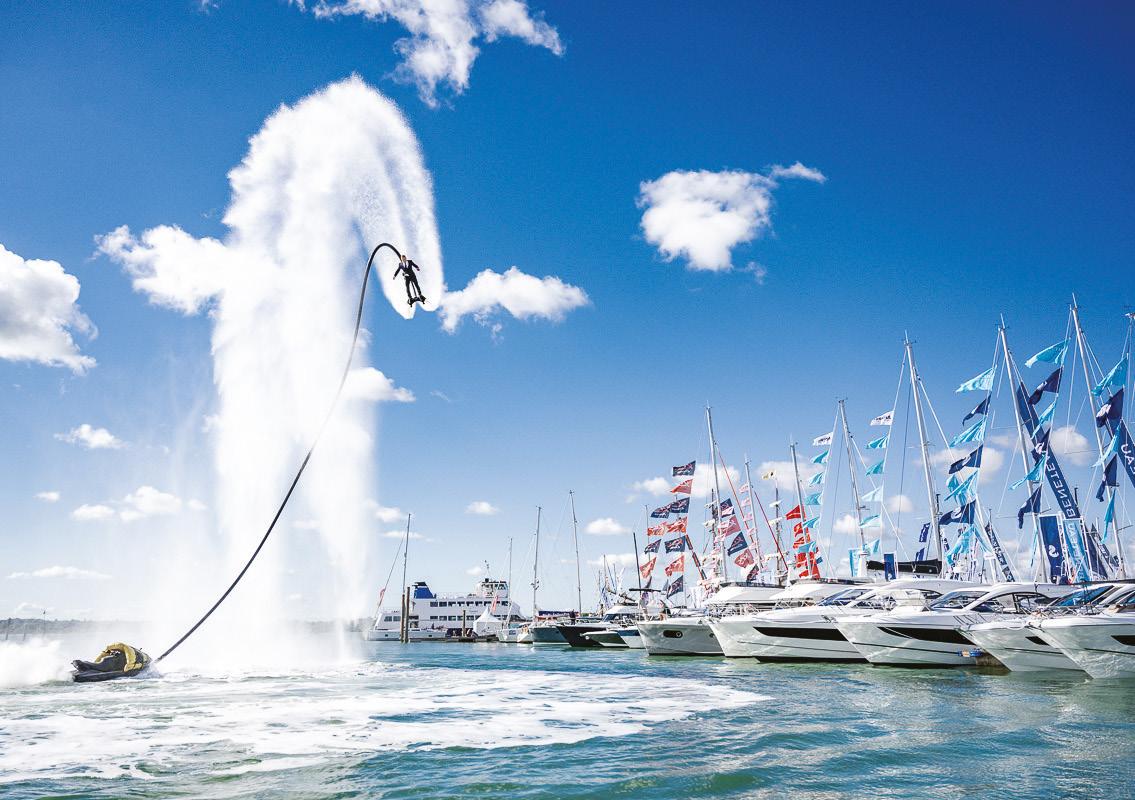
More than 83,000 people visited the 53rd Southampton International Boat Show in September, with more than 14,000 people getting afloat on the show’s Try-a-Boat stand and other initiatives that allowed visitors to try paddleboarding, sailing and motorboating.


Lesley Robinson, CEO, British Marine, said: “Visitors have also been able to get out on the water onboard a selection of fascinating and historic craft including the Morgenster tall ship, F8 landing craft, motor gun boat 81, and the high-speed launch 102. I would like to o er my thanks to Rockley Watersports, Flexisail and Portsmouth Historic Dockyard for making the on the water experiences such a huge success.”

The show boasted more exhibitors, debuts and boats than ever before – a total of 685 stands and berths across the event’s 70,000sq m footprint. Over 650 craft were on display, with 300 in the marina.There were 126 new companies this year and the show hosted 167 UK and world debuts.
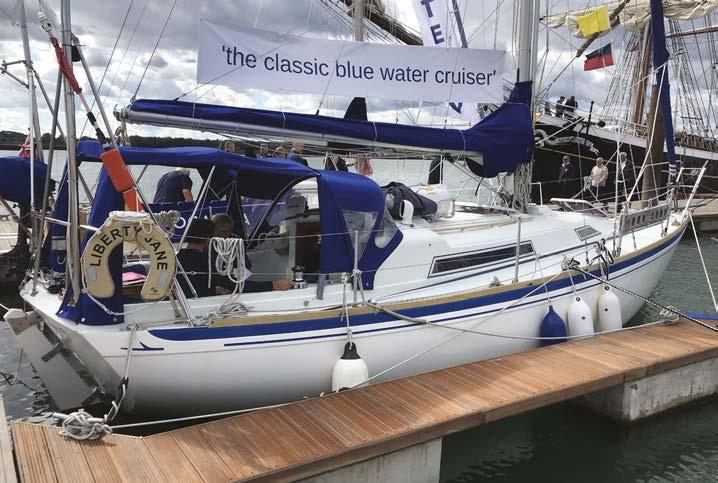
Lesley said: “There has been a fabulous atmosphere at this year’s show and the feedback we’ve received from exhibitors from across the industry has been exceptional, with many indicating very strong sales. The show has put a real smile on everyone’s face with a fantastic mix of products, talks, entertainment and refreshments, plus our stunning new VIP experience. We’ve welcomed everyone from boating newbies to seasoned sailors and watersports enthusiasts, and the wide choice of sailing yachts, motorboats, accessories, paddle boards, kayaks and services has been incredibly well-received.”
British Marine said the three days of national mourning and the closure of the show for one day as a mark of respect for Queen Elizabeth II had impacted visitor numbers but declared the resultant nine-day event a huge success.
A new addition to the 2022 show was a Quayside Club VIP experience, which proved popular.



This new foiling boat, FlyingNikka, in the style of an AC75 used in the America’s Cup, stole the headlines at Les Voiles de SaintTropez in October. Designed by a team led by Irish designer Mark Mills, the 19m posted speeds in excess of 40kts. She was built in Valencia at the King Marine yard. Team manager Alezio Razeto said: “The owner, Roberto Lacorte, was keen to have a thoroughbred race boat, built for speed. We’d witnessed the development of foils on the IMOCA class sailboats and the America’s Cup yachts, so we said to ourselves: why don’t we have articulated foils on a race boat in the Mediterranean? It’s Roberto Lacorte, the owner, who helms the boat. The crew largely has an America’s Cup background. Helming a foiler isn’t the most di cult aspect. The real di culty lies in trimming the sails and the foils. There are a huge number of elements which need configuring to get her up on a plane, airborne and nicely balanced, especially given that the pressure in the sails is never constant. Adjusting the foils is the most complicated element, particularly when you’re flying along at over 30 kts!”

The event attracted around 250 modern and classic yachts, including 46 Maxis, with 2,800 sailors. This year was the 160th anniversary of the organiser, the Société Nautique de Saint-Tropez.

a new meaning to sailing high or low
A new sport called Sail Surfing is taking o in the dinghy classes, swapping surfboards or windsurfers for something with a sail and tiller. The sport can trace ancient origins in the Pacific islands, where the fisherman’s ability to surf his sail-powered multihull into the beach, carrying a boatload of fresh fish, was a skill on which the welfare of the entire island depended. Fast forward several centuries and it took root again among surfers in California. Tired after long days standing on their boards, they would use the last few waves of the day surfing more comfortably in Lasers, Aeros or even the Flying Dutchman, whose 20ft loa became known for its wavecatching ability. While the sport began in beach wave conditions, regattas have now spread across the world with competitors utilising big wind-over-tide conditions to similar e ect. As well as the round-the-buoys race, marks are given for how high above your opponent’s head you can get your boat. Judges on the racecourse measure this using altimeters. It gives an entirely new meaning to the terms sailing high and low.

Marks are given for how high above your opponent’s head you can get your boat...




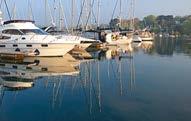





 PORT SOLENT
PORT SOLENT
The ClubSwan 41 is the latest in the new generation of one-design racers launched by the Finnish manufacturer. The boat sits between the ClubSwan 36 and 50 in its range, and promises a similar blend of amped up performance combined with dramatic looks and potential for extremely fast cruising.
Like the other boats in the range, the 41 is designed by Juan Kouyoumdjian and will compete in ORC Category B.

As you’d expect, the boat is very light at 6,200kg and also features a massive sail area with the mast stepped almost centrally allowing for a very large fore triangle. This is a serious racing machine but the interior remains important and Swan has worked with New Zealand studio Pure Design & Engineering and Lucio Micheletti to create a modern, comfortable space.
l nautorswan.comFrench manufacturer Fountaine Pajot has built a solid reputation as a multihull manufacturer by producing affordable cruising catamarans in the 40-60ft’ size bracket. The unveiling of a new 80 footer is therefore something of a step change for the company as it catapults the marque into a somewhat different market. Nevertheless, the new 80 embodies many of the features seen in the smaller boats in its range, including high levels of comfort and class-leading accommodation space. At the same time, it’s all just a bit bigger and more luxurious. The price? A cool 4.9m Euro.
l catamarans-fountaine-pajot.com


Hanse began a revamp of its range last year with the launch of the Hanse 460, and has followed on with its new 510. Like the 460, it breaks with Hanse’s heretofore go-to designer Judel/Vrolijk and switches to the Berret/Racoupeau team who have worked extensively with French manufacturers Beneteau and Jeanneau in the past. The new boat is strikingly modern in its looks and features a high volume hull with plentiful beam carried right aft, and has twin rudders.
Hanse is aiming to up the quality of the product somewhat with its latest generation, and this means a somewhat more plush interior. As you’d expect there is also masses of accommodation space, making this an ideal fast cruiser.
l Inspirationmarine.co.ukA look at the latest launches from around the globe

The Beneteau First 44 picks up squarely where the manufacturer left off with the First 53. This is to say that the boat is most definitely a cruiser/racer which delivers decent amounts of comfort and speed. The boat is competitively priced (starting price is 335,000 Euros) and the design team of Roberto Biscontini, who penned the hull lines, and Lorenzo Argento, who did the deck and interior, have produced a stylish, fast yacht that remains easy to handle. Displacement is moderate and the aim has been to create a yacht that is well adapted to the light winds of the Med but also has the power to stand up to strong winds. To gain this much coveted blend, the designers have produced a boat fine on the waterlines but with plenty of flare aft reducing wetted surface area, despite the fact this is a twin rudder yacht. This is a yacht that takes aim at Dehler, Solaris and X- Yachts and offers an exciting alternative.
beneteau.com
Croatian boatbuilder Salona has been slowly but steadily revamping its range, and the announcement of this new 39ft cruiser/racer further augments its range. The lines are penned by Italian design house Cossutti who has drawn up a fairly conservative design with modest beam and plenty of taper aft married to a single spade rudder and a lead bulbed T-Shaped keel. Displacement is a relatively modest 6,200kg. Accommodation is generous, with a large double aft cabin, and stateroom forward in standard format. The price is also attractive, making this an interesting alternative to, say, X-Yachts or Arcona.
l salonayachts.com
Of all the sounds I’ve ever heard on a boat, the most terrifying is the shuddering ‘crump’ of a heavy wave cascading onto the cabin roof. I’ve only heard it once but it is truly nerve- shattering. I’m not talking about the harmless slap of what might be called an ‘ordinary’ wave against the topsides; I’m talking about that moment when your poor boat suddenly feels the true weight of the sea. It shakes you to the core. I’ve only felt it once, but it was memorable.
I was hove-to in something a bit short of a gale, west of the Azores. e seas were far removed from that chilling description, ‘high’, but it was certainly bouncy and I spent most of the day in my bunk except when I got my hourly muscular workout trying to make tea. e ‘crump’ came in the middle of the night. One wave, bigger than the rest, must have appeared out of nowhere - I didn’t see it coming. e boat, having ridden over the others with little di culty, was brought to a shuddering halt by this concretelike wall of water. e bang was as stunning as a canon shot, and to be in the cabin at that moment was to be like a nut in a shell, crackers about to attack you. I feared the worst. But nothing happened. e boat was ne, the mast still standing, the portholes sound, although my heart was ogging like a storm jib in a tack. e next morning I discovered the Avon dinghy had gone over the side and may have been well on its way to America by then, but that’s a story for another time.
I am telling you this because in the safety of my own home, a similar thump resounded around the house the other morning. It was the landing on my doormat of the latest edition of that classic book, ‘Heavy Weather Sailing’.
As a 22 year old with my rst little 17 footer, and with no knowledge of how to sail, why was this the rst and scariest ever volume I purchased? I suppose because the ultimate storm is everyone’s greatest dread, and while it is easy to gather routine experience over the years, there’s not much that can prepare you for a life-threatening blow. So I read what it was like for other people, hoping to learn
When it comes to the environment, where is the balance to be found? facebook.com/ sailingtoday @sailingtodaymag sailingtoday.co.uk
something from them, and taking mental notes, in between prayers. at early edition of mine, which to my great regret I no longer have, was the work of K Adlard Coles who did immense service in communicating, as well as practising supremely well, the art of cruising under sail in the 50s and 60s. e publishing company which still carries his name maintains his tradition of being steadfastly enthusiastic about everything to do with the sea from a cruising boat point of view. I imagine that the boats I read about nearly y years ago would have been far removed from those of today. Ga rig was still hanging on, and I dare say there were still a few with canvas sails. GRP was in its ascendency, but still not fully trusted. I once owned a GRP boat built around this time and the hull was as thick as a bank vault because the builder didn’t fully trust that plastic stu . e latest edition is skilfully edited by Martin omas and Peter Bruce who have brought their own wealth of experience to the task, but I wonder what Adlard - who was probably used to cruising with hemp rope smelling strongly of stockholm tar -would have made of the chapter on icy, high latitude sailing, now a commonplace activity, or handling a RIB in heavy weather. ‘A RIB?’ he might ask, ‘and what would that be?’ ere’s even a chapter on sailing with ‘foils’ which, to my eye,and probably his, are inconvenient sticky-out things which make you go faster but prevent you ever putting out fenders. Adlard, and I, would probably take a hacksaw to them.
e book makes for an instructive read but do we, as everyday sailors, need to focus so much on heavy weather? Need it spoil a good night’s sleep? When we learn to drive we don’t fret about coping with a car crashes, so why fret about the worst that sailing can throw at you.
Seriously heavy weather is quite rare. A wide-ranging American cruising sailor, Beth Leonard ,sailed all the oceans of the world with her husband, keeping careful log of the conditions she encountered. She reported that for something over 75% of the time, there was too little wind rather than too much. So enjoy ‘Heavy Weather Sailing’ but don’t let it give you nightmares.
Paul reflects back on one of the most spine chilling reads of our times. No, the author is not Stephen King, it’s K Adlard Coles, whose Heavy Weather Sailing is a bona fide classic
‘The boat, having ridden over the other waves with little di culty, was brought to a shuddering halt by this concrete-like wall of water’


I’m half way through an eight-week tour of Europe which has been a good reminder of the full breadth and diversity of our sport. From commentating at the Bosphorus Cup in Istanbul and the Barcolana in Trieste, to the hardcore competition of the 470 Europeans in Turkey and Formula Kite Worlds and Europeans in Sardinia and Greece respectively.
e Bosphorus Cup and the Barcolana are both big boat races but more than races they’re a parade of sail, a festival of fun which also happen to help promote the cities in which they take place. Sailing through the Bosphorus is a real treat, one that event founder Orhan Gorban created more than 20 years ago when he convinced the authorities to close the narrow passage between the Black Sea and the Mediterranean to commercial shipping for a six-hour window. If you’ve never heard of the Bosphorus Cup before, Google it and then nd out how to charter a boat next year! e same for the Barcolana. Even though entries were down this year (at a mere 1619 boats on the start line), it is a breathtaking tra c jam of sailing yachts. Most people are there for the sheer experience of being part of the biggest sailboat race in the world, others are there very much for the win. So much so that one Maxi skipper threw a glass of beer over a rival who had protested him and now nds himself at the mercy of a Rule 69 hearing for Gross Misconduct. I spoke to a rules expert about this and he said the best thing to do - if you choose to douse your rival with beer - is to laugh while doing it. Don’t scowl and look like you mean it, otherwise Rule 69 will come calling. Intent is everything.
Talking of protests, there are strong signs that the young and fun riders on the Formula Kite circuit are having to grow up quicker than they might have liked. Turning from a beach event where riders are there for the pure fun of it, but now to a high-intensity campaign where achieving a particular result determines whether or not you’ll receive funding for the coming season - the priorities are beginning to shi .
On the nal day of the European Championship on a windy day in Nafpaktos, Greece, and there was a touching of control lines between two riders in one of the seminal heats. Generally the riders have all signed up to a ‘gentleman’s agreement’ where they shrug o marginal contact between lines or kites as part of the game. is time, however, Gisela Pulido from Spain decided to protest her rival from France, Poema Newland.
With their 15 square metre kites hovering above them on
the beach, the two riders stood with their backs to each other as the three-person jury reached their shoreside verdict. Newland was in oods of tears as she was told of her disquali cation while Pulido bounced back into the waves, ready to contest the four-rider nal, from which she would take the bronze medal.
Pulido copped a lot of heat on social media, the weight of opinion seemingly against the Spaniard. But that protest is an inevitable part of growing pains as the sport loses its naivety and innocence to modernday Olympic campaigning and all the pressures that go with it.
Pulido’s point of view is pretty straightforward: “When we go out and race each other, we are racing with the knife in the teeth, it’s full-on war. When we come ashore we are friends again.” Newland and others will take some persuading to come around to this point of view but, like it or not, Pulido’s point of view will win out in the end. When you make a pact with the devil, ie becoming an Olympic class, sometimes the fun and the friendship is pushed down the priorities.
Where Pulido will struggle to win her side of the battle is the growing size of kitefoilers. Even in light winds, in fact especially in light winds, the heavier riders are able to hold down bigger kites and generate higher levels of apparent wind. With top-end upwind speeds of 23 knots, even in just 8 knots of true wind, and downwind speeds sometimes in excess of 40 knots, heavy bodyweights are easily justi ed. e fastest female riders are operating between 68kg and 80kg, while Pulido has to do long hours in the gym to get herself over 60kg.
Daniela Moroz, who has just won her sixth world title, has increased her weight to close to 70kg, although she’s not particularly happy doing so. e American rider is keen to see maximum kite sizes limited to take the pressure o the women having to get fat to be fast.
Toni Vodisek, the 95kg Slovenian who has just won his rst men’s world title, walks around proudly with his dad bod, even though he’s in his early twenties.
As a sailing journalist and TV commentator Andy has unparalleled knowledge of the performance racing scene, from grassroots to elite level

e same challenge faces the windsur ng athletes who used to try to be as skinny as possible for the now extinct RS:X board. Now they are trying to bulk to be as heavy as possible for the foiling replacement, the iQFOiL. It’s a tricky subject and one that will need resolving if athletes are to be encouraged to look like athletes.

“More than races they’re, a festival of fun which also help promote the cities in which they take place”











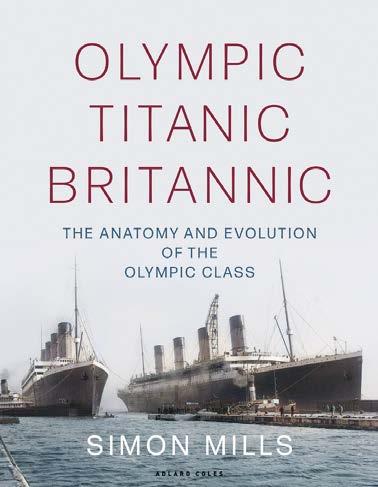

















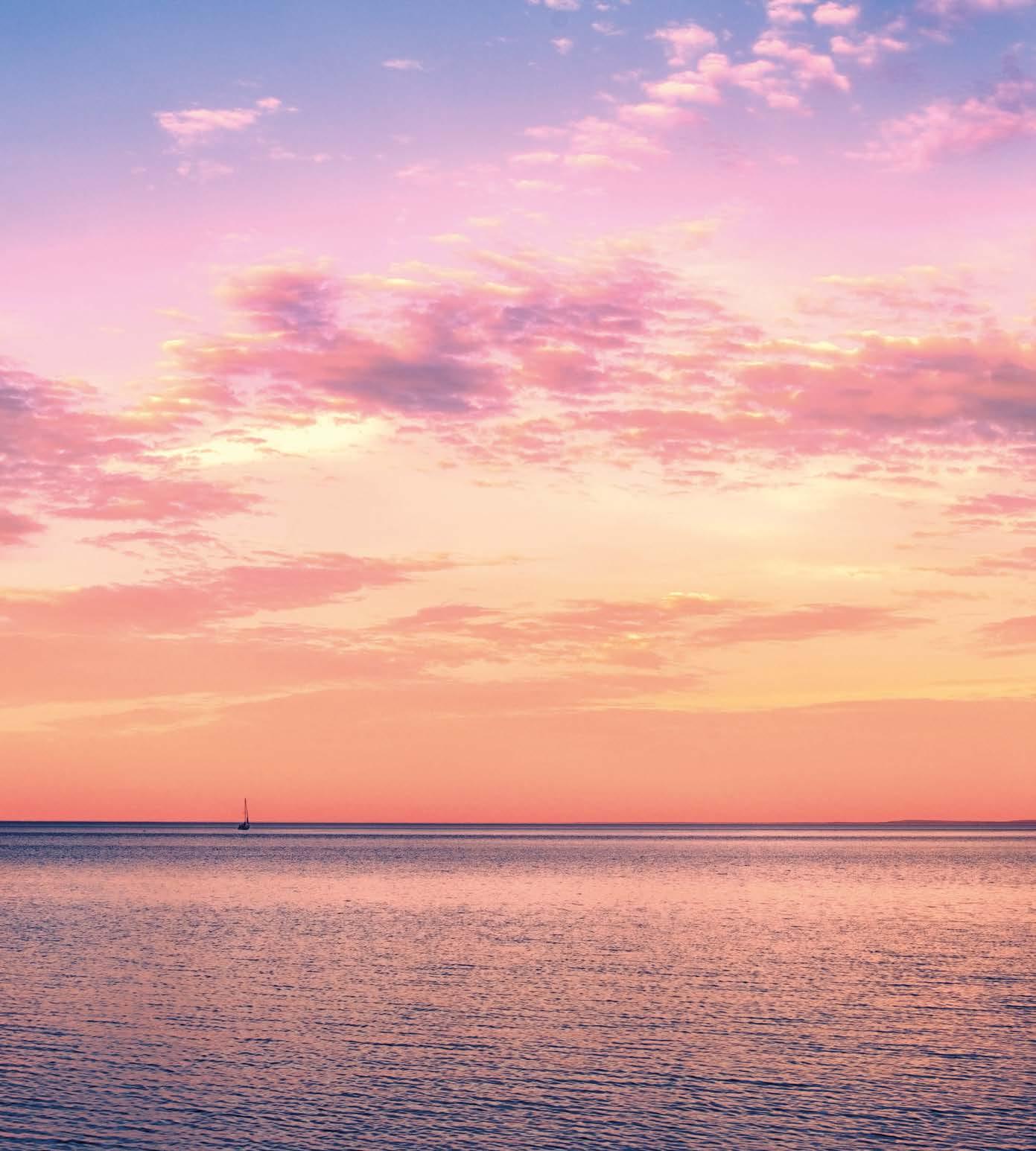
eaving on any passage leaves me with a dry taste in the mouth, a pile of butter ies in the stomach and a lot of ticking o of checklists. e boat is stu ed from stem to stern with enough food for four ocean passages. We have enough spares to x just about anything on board, though Sod’s Law dictates that the one spare we do need will be the one we omitted. It’s kind of endearing that, however many times we get ready for a passage, it is still a daunting experience setting o into the open sea on a small boat. e nerves get to you every time and the bravado
on the dock is notably muted. e one item on a check-list that all of us keep looking at is the weather and, importantly, whether there is bad weather in the o ng. Even in these days of grib forecasts, using half a dozen di erent models, the weather gods can wreak havoc.

I’m pretty thorough in my research of historical weather records for an area or a passage, and we also monitor several weather websites to get a sense of what is happening. And yet it can all turn to custard, and we need to be prepared for heavy weather.
Probably my go-to tactic for heavy weather was gleaned from Moitessier’s e Long Way when he described how running before
a storm that he stopped trailing warps and let Joshua go at its own pace over the waves. Even in a heavy old boat like Joshua he could run under bare poles and safely surf over the waves keeping a sort of rhythm with the sea.
In early December 2003 we le Las Palmas Marina on Gran Canaria heading for Guadeloupe in the Caribbean. Seven Tenths was a 36 (11m) Pedrick Cheoy Lee with three of us on board. We were ve days out when the weather began to deteriorate, and we reduced sail to run with 45-50kts of wind.
Rod Heikell provides some pointers on heavy weather sailing techniques drawn from his extensive experiences
Our weather was once a day from checking in on the SSB net when an American boat ahead of us that had satellite coms would relay the forecast. As we surfed down the waves Lu got the forecast and would draw up a sort of synoptic chart and come out to tell me the bad news: “ is is tropical storm Peter and this is us”, she said showing me the chart. We were e ectively tracking the storm at about the same speed and we were squarely inside the southeast quadrant.
As Seven Tenths surfed down the watery slopes of this out of season tropical storm in the Atlantic, I remember looking up in awe at the storm cells leaking lightning and
A mainsail with a deep third reef has always served me better than a trysail
While a storm jib is a more viable option than a trysail, a staysail or even a roller furling headsail have worked for me


In Antigua before setting o across the Atlantic, I suggested to the crew that they rig the storm jib and trysail that had come with the boat, while I was o doing some paperwork. When I returned three hours later, they were still struggling to get the storm jib and trysail on – and that’s in the marina.
For the last 30 years I have ordered any new slab reefing main with a deep third reef about equivalent to the size of a trysail. Ask your sailmaker to reinforce this third reef with extra cloth and added stitching. If you have a roller reefing main get the sail reinforced for the area that will be out when reefed right down. We keep this third reef rigged with reefing lines all the time, as it can be useful even in calmer weather when heaving-to, or slowing the boat down at night for a daylight entrance to a harbour or anchorage.
Whenever the weather has deteriorated to the point where a trysail and storm jib are needed, I use the main reefed down to the third reef, and either the roller reefing genny with just a bit out, or a staysail partly reefed. Modern sail material is marvellous stu compared to 20 years ago and, in most cases, the critical issues have not been the material itself, assuming it is in good condition, but stitching, fixtures and fittings. Blocks, the
attachment points for reefing lines, the furling line for the headsail, cringles and reinforcement points will often break before the sail material does.
The furling line for roller reefing headsails is often a weak point when hitherto unnoticed chafe lets the whole shebang out in 50kts of wind and ,trust me, getting that lot down and tamed is intimidating.
I’m sure someone will pop up here and tell me that this is an irresponsible and unseamanlike attitude but rigging a storm jib and trysail in bad weather at sea is to my mind unseamanlike. Getting the storm jib hanked on and up on a heaving foredeck doesn’t captivate me either, but should the need arise it’s a lot easier to get the storm jib on than to get the trysail rigged.
That said headsail roller reefing systems are a lot more robust than most people think and I’ve yet to rig a storm jib in gale force winds. Let’s face it: in 50 kts of wind it’s damned di cult to hold onto flapping Terylene let alone get it hanked on and flying. In both Seven Tenths and Tetra I’ve hove-to in 5060 kts sustained with a deep-reefed main and a patch of roller reefing jib, and while I may just have been lucky to avoid damage to the sails, we all need a bit of luck out there.

dangerous amounts of wind all over the night sky. It was scary stu and it’s di cult to describe the menace of 50kts plus of wind, and clouds full of lightning trails. Seven Tenths was behaving well with the waves but we needed to heave-to to let the storm pass. I put the main up with its deep third reef and let a little bit of genny out on the roller ree ng, and backed the genny and magically we were hove-to. We had practiced this before but in much less wind and I was surprised at how calm things were. We still had waves breaking over the boat, but from the bows and she sat at 15 degrees or so o the wind, slowly clocking up and back o the wind. I went to my bunk a er being up for 36 hours or so and Lu and Ian kept watch.
I could be forgiven for thinking that someone up there has got it in for me. Tropical Storm Peter battered the crew of Seven Tenths as it passed close northwest of us with the wind recorded at a constant 60kts and with a de nite hurricane eye. NOAA were just about to classify it as a hurricane before it hit a cold front and petered out. e thing is that this was the rst time since 1887 that a tropical storm had been recorded
in the Atlantic in December. And the irony of it all was that Lu and I were going to the Caribbean to get married. My future fatherin-law was called Peter.
e lessons are plain: Bad weather can brew up at odd times of the year, especially with climate change a ecting things. Running o is an ok tactic but not with tropical storms and hurricanes where you need to get out of the way of the system and head for the equator. And that deep third reef proved its worth yet again.




In mid-Paci c on our way to Palmerston Island, I noticed the wind speed was creeping up over 30kts. Lu had just gone o -watch and was not best amused at being called up, until she looked out the back at the evil greeny-grey cloud stretching right across the horizon. Time to reef the main I said while reducing the roller-ree ng genny. By the time Lu was up at the main, the wind speed was up over 40kts
and, as she wrestled the main down the wind speed kept going up.

Time to get rid of it all together. Once Lu had tamed the main the wind was over 50kts and climbing. I rolled up the genny completely and we scooted along under bare poles at 7-8kts with the wind at 60kts plus. We donned life jackets and harnesses – I know, but better late than never – and steered Skylax directly downwind. A er a couple of hours, the wind was down to 50kts and then 40kts. Strange
how 40kts and dropping is a relief a er so much wind. I remember reading in Moitessier’s e Long Way that the art now is to keep letting out a bit of sail, usually the roller ree ng genoa, to keep the boat going fast enough so it is not pooped by the sea that has built up.


We still got a couple of wavefulls into the cockpit, where the biggest annoyance was the cockpit cushions floating around our shins. And I was worried about the engine start panel in the cockpit,
which had been underwater a few times from the waves washing in. As it turned out it was ok except it lost its buzzer when you turned the ignition on.
We got off lightly. The middle sprayhood was knocked flat. The MOB aid on the transom was washed away. But apart from everything in the cockpit getting drenched, we were ok. After four hours we were back to full genny and a double reefed main, on our way to Palmerston Island.
BELOW LEFT Skylax in brisk trade wind conditions – two reefs in the main and a partially furled genoa BELOW RIGHT Hustling along in the Paci cSometimes it is not the sheer force of the wind that makes a voyage hard going but the overall situation visà-vis wind, the season and current. We were at the bottom of the Red Sea getting out of Bab El Mandeb, the Gate of Tears, at the wrong time of year with a war going on aswell. Bab El Mandeb is the southern entrance to the Red Sea with the small channel on the east side and the main channel, including the shipping channel with separation zones, between the Yemeni island of Mayyun with a coastguard station on it and the Djibouti coast on the other side. Currents mostly ow northwards here, but there are tidal streams as well that will increase or decrease the current.
‘ is is the BBC World Service. ere are reports that Eritrea has invaded the Hanish Islands near the bottom of the Red Sea and occupied Greater Hanish Island. A number of Yemeni soldiers manning the garrison have been killed and the commander of the Eritrean force reports that 80 soldiers have been taken prisoner. e Yemeni
government is sending forces to repel the invading force including a number of naval cra and Mig ghters.’ None of us said anything but just looked at each other as we tacked towards the Yemen coast under Greater Hanish. We had spent ve days in the anchorage at the top of the island wistfully hoping the strong southerlies of 30-35kts would die down a little. Partly because we were getting frustrated at just sitting there and partly because Colin had to y back to London, we had decided to buckle down and beat to windward whatever the wind gods were doing in this part of the world. Now it seemed there was going to be a bit of a war as well.
I had le Turkey in September and sailed Tetra down to Cyprus where Colin and Frank were to join me. Tetra is an old fashioned, long keel yacht built by Cheverton on the Isle of Wight in 1962 and, at just 31 , a rather small yacht for this sort of voyage against the prevailing wind and current. Once through the Suez Canal we pottered around the coast a bit before picking up a good northerly blow, reaching Massawa in Eretria in something under ve



days. Even loaded down, the old lady had averaged 130 plus mile days.
In Aden a er nally escaping through the Gate of Tears

e problem was that I knew that the wind and current would likely be against us from then on, but only in theory. e bruising reality of beating to windward in 30kts and against the current meant that a day’s run was lucky to be 50 miles and it was di cult to sleep, eat or do anything except wedge yourself in the cockpit and turn your head away as green water cascaded over the deck and into the cockpit. ere were times I wished for 150 of ocean-going motor yacht instead of 31 of old-fashioned sailing yacht. Our worst patch was 12 miles made good in 10 hours, but eventually we made the small strait on the east side of Bab el Mandeb and, as we passed through the Gate of Tears, we had our own personal version of why it was called thus and it had nothing to do with sorrow at leaving the bottom of the Red Sea.
In the bumpy bits at the bottom of the Red Sea I had rashly promised all sorts of things to Colin and Frank to keep our spirits up. Amongst these promises was a slap-up meal with all the beer they could drink. e thing
A shing dhow in the Hanish Islands tied up alongside Tetra
We always make a libation to the wind and sea gods wherever we go



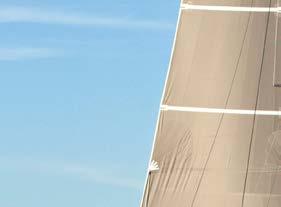




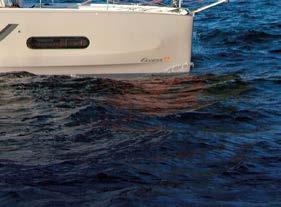
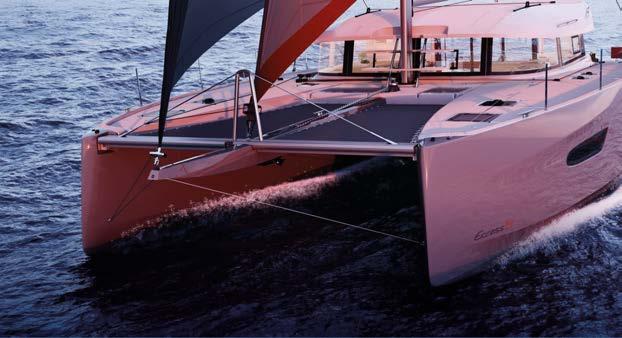











is, nobody had mentioned that in the last war in 1994, the north had won and being more fundamentally minded than the south, alcohol was banned. Except for a few of the large hotels where beer was $5 for a small can. It was an expensive promise but a er the bruising experience of getting out of e Gate of Tears I was more than happy to pay up and more than happy I had ordered new sails for Tetra including a main with a deep third reef in it.
None of us wants it and, in practice, you are unlikely to experience bad weather when sailing in the right season for a stretch of ocean. Most damage comes from squalls where the wind speed may peak at 40-50kts for a short time, o en accompanied by the wind veering dramatically. As long as you keep an eye out astern for squalls, and reef down before one arrives, then you will likely avoid damage. It is the gung-ho sailor who keeps all white sails up in a squall who will come to grief. Normally this will just be sail damage, though it is also possible to damage the rig. at said, there can be occasions when sustained bad weather does happen at sea and skipper and crew need to have a bit of an idea on what to do. I say a bit of an idea because we all have scenarios we have read, on dealing with heavy weather, but in practice things can be a little more uid and involve more guesswork than following a recipe of what to do in gale force winds.

From my experience, the following has worked ok up until now.
As long as you have sea room, run o before the gale. Reduce all sail except for a bit of jib or put up the storm jib and run with the wind. You will likely have to hand steer so make sure you are clipped on. Even under bare poles I’ve done 7-8kts in winds up to 50-55kts with a reasonable amount of control. What is important, is to start increasing sail area as the wind begins to drop and the by now big waves start to collapse on the top. You need to keep speed up to avoid being badly pooped by these collapsing waves.

ere are those who are fans of a sea anchor let go from either
A retro tted electric winch can make life a lot easier in heavy weather
the stern or the bows. I’ve had no experience of these and gured if I was running o downwind I could always trail warps and the kedge anchor we keep on the pushpit.
If running o is not an option, or is the wrong option for other reasons then I usually heave-to. With a deep third reef in the main and a scrap of backed jib, you can tie the helm o so the boat fore-reaches into the wind and importantly into the seas. Depending on the boat, you can be anything from 20-60 degrees o the wind. My previous boat Seven Tenths, a Cheoy Lee Pedrick 36 was ‘better’ at heaving-to than my present boat Skylax, a Warwick Cardinal 46. Being hove-to is remarkably calm and you are meeting the seas with the sharp end of the boat, which just seems a better way to do it.
Lying ahull has never worked for me. e boat tends to lie across the seas and the waves smash into the hull with some force, forcing the boat over every time a wave hits. In really big seas it seems to me there is the danger of a B2 knockdown and I have only ever tried lying ahull in 35-40kts a couple of times. It is not my preferred option.
Books have been written about dealing with heavy weather so this is no more than an outline, but I will stress again that you are unlikely to encounter a full gale at sea if you are in the right stretch of water in the right season. You will always encounter gale force winds for a short duration when squalls come through.

Back in the days when boats still leaked and electronics weren’t even a glimmer in the sunrise, I learned many a useful lesson from the foreman at the Elephant Boatyard up the Hamble River. e late, great Davey Elliot was a classic Solent longshoreman of the old school. I really don’t think there was anything about boats he didn’t know, but his talents reached far wider. He was an
accomplished student of the human condition, he had a tongue that would split solid oak to take down any upstart sailor who fancied himself, and he was a natural healer.
is latter gi was kept private and I had no inkling of it until one day, su ering more than usual from a cartilage injury, I was limping back to my boat from a trip to the skip when he called over to me.
“Looks like you’ve got a problem with your knee, Nipper,” he said.
Catch up with Tom’s columns now and in the future at sailingtoday.co.uk

Although I was then pushing 50, he’d called me that ever since I was a 6 6in 22-year-old struggling with my rst wooden boat.
“Come on over to my emporium and I’ll see what I can do.”
Not knowing what to expect, I tottered across to the shipping container where he kept his tools and work bench. Few of us on the yard were ever invited into this sanctus sanctorum, so I must have been doing something right. What
CUNLIFFEwhen
comes to close quarters handling in a marina
I recall best is the wonderful scent of the place. Fresh wood shavings mixed with Stockholm tar blended with linseed oil made a heady whi , while dri ing over it all was the pale blue fug of Davey’s pipe, which was rarely seen out of his mouth. At the end farthest from the door stood his well-worn sea chest, dating from his time as a ship’s carpenter going deep-sea. He sat me down on this and sized me up. We’d known each other for a quarter of a century. Although I was never a natural with caulking irons, saw and chisel, I like to think he had developed a sort of respect for me as an honest tryer who did at least make a habit of disappearing over the horizon and returning with a few tales to tell.
Davey didn’t say anything. He just held his cupped hands around my knee and seemed to go o into some sort of trance. He wasn’t touching me at all, but a er half a minute or so, my knee began to heat up. is was no illusion. It was pulsing with warmth and, a er a little while, he pulled his hands back as though they were being burned.
“ at’s enough for now,” he said, shaking his wrists. “It’s too hot for me. Must be doing some good. Come back tomorrow at ve o’clock when I knock o . We’ll give it some more.” And with that, he shooed me out, locked up the container and strolled back to the gangway of the traditional shing boat where he lived.
My knee felt better in the morning, and at 1700 I came back into the yard to report for treatment. Davey didn’t show up, so I waited until six o’clock then went to the pub next door for a refresher. In the bar I fell in with a neighbour from the yard. He looked sick and I was about to tell him that Davey hadn’t appeared, which was out of character, when he broke the news that my old friend had literally dropped dead that a ernoon.
Several pints later, more of Davey’s acolytes had gathered at the bar. Still in a state of disbelief, we remembered his sayings, his cuttingo of fools, and the kindness he was always ready to show to decent folk in need of a leg up. One incident had
stuck rmly in my own mind and it will be there until I join Davey in the big shipyard down the far blue yonder. I was a young skipper in charge of a yacht with a heavy tonnage and a very large turning circle. One grey morning, the river was quiet, the tide slack and I was manoeuvring among moored yachts under power. I had to turn my boat through 180 degrees and, rather than opting for the prudent method of going ahead and astern, using the prop-walk to make the most of the small amount of space available, I decided to go for an all-or-nothing turn under full power with the rudder hard over. e propeller was bang in front of a large rudder. With lots of grunt coming o the prop, the blade diverted the gushing water, allowing me to swing round a lot more tightly than the yacht’s natural inclination. All was going ne. I was halfway through the manoeuvre and heading brie y towards a row of yachts secured fore-and a on a series of piles when the engine coughed and gave up the ghost. e silence was deafening but the heavy yacht hardly broke her stride. She kept right on going, but bere of her mighty propeller it was soon obvious that rather than get comfortably round, she was going to tee-bone one of the yachts on the trots ahead. I was leaning all my weight on the big tiller with

 ABOVE e late, great Davey Elliot
BELOW
Slipping into a simple berth. Would it were always so easy!
ABOVE e late, great Davey Elliot
BELOW
Slipping into a simple berth. Would it were always so easy!
“bereft of her mighty propeller it was soon obvious that rather than get comfortably round, she was going to tee-bone one of the yachts on the trots ahead”
disaster looming and no clue about what to do next when Davey appeared in the companionway of the lovely varnished hull that was plumb in my sights. Taking his pipe calmly from his lips he pointed it to the gap between his long counter stern and the pile to which it was secured with a very large rope. Steering into this dubious haven was a possibility, because it involved easing the tiller. In any case, nobody with any sense of emotional survival argued with Davey, so I did as I was told. As the spoon bow of my long-keeled yacht rode up on Davey’s stern line he whipped a couple of turns o the bollard to which it was secured and expertly surged it away. Somehow, he gauged the friction just right and shrugged o the last of my way just before I hit anything. As the boats slowly came together with no damage at all, the cockpits fell alongside one another and he looked me square in the eye.
“Next time you’re heading for a line of yachts, Nipper,” he
A heady cocktail of tangled ropes, no fenders, confused crew and bemused onlookers – Davey would not have been impressed
said, re-lighting his pipe with much sucking and pu ng, “you be sure to pick a cheap one!”
Tom has been mate on a merchant ship, run yachts for gentlemen, operated charter boats, delivered, raced and taught. He writes the pilot for the English Channel, a complete set of cruising text books and runs his own internet club for sailors worldwide at tomcunli e.com

I think about this incident every week as folk ask me to help with their sailing problems. Looking back on my own career I realise it’s no coincidence that the most popular questions are about manoeuvring under power. Speci cally, how the devil to get in and out of a tideswept nger berth hemmed in by ranks of pontoons sited far too close, and for which the annual fee would buy a respectable used car. Much is written in magazines about sure- re ways of defusing these horrors. Some of them work some of the time, but the bottom line is that there is o en no easy answer.
I always advise marina visitors to tell the berthing master when they call up that they have an awkward boat, that they are inexperienced –whether they are or not – and that they really need an up-tide berth.

Sending people into a down-tide
cul-de-sac with the wind up their chu with a nal tight turn against the propeller is handing them a ticket to nowhere. We must insist on better service, but if there’s no help for it and you’re stuck with a non-starter, it’s a good idea to rig fenders on both sides, remember to keep up-tide when approaching along a pontoon corridor, take your time and work out what’s the most wretched result that can happen if it all goes belly-up. Be prepared for that while hoping for the best,_ and you’re a lot better o than the chancer who comes zooming in with no contingency plan, no fenders rigged and a foredeck crew still trying to untangle a line that’s too short anyway.
While you’re at it, look hard at any potential victims, price them up quickly and make sure you land up on the cheapest. You may not get your knee xed, but you can award yourself a wry chuckle at the end of the day.
“In any case, nobody with any sense of emotional survival argued with Davey, so I did as I was told”


lex omson may have relinquished the wheel when he announced his decision not to go again for the next Vendée Globe, but he has certainly not let go of his passion for solo o shore sailing.
Far from it. For the last 12 months, the ve-time Vendée veteran has been seeking a way to channel his expertise and pass on the knowledge he gained from two decades of campaigning his IMOCA 60 Hugo Boss –during which he broke multiple world records and scooped two Vendée podium positions.

Of many applications and o ers, he has narrowed it down to one. Now, the hard work begins with the announcement of an exciting new partnership that sees Canadian businessman Scott Shawyer as president and omson as mentor of an all-new, fully professional o shore sailing team.
Canada Ocean Racing aims to become the rst ever Canadian team to complete the Vendée Globe. Along the way, they plan to spearhead the development of o shore sailing in Canada by inspiring others, creating performance pathways, and by constructing a groundbreaking, long-term business.

omson will be providing his unrivalled expertise both on and o the water, and says the aim is to enter a competitive boat in the 2028 Vendée Globe; for 2032, the target will be to top the podium.
e current intention is for Shawyer to be the race skipper – but that’s not set in stone, as the scope of this campaign stretches way beyond one person. e team is also considering entering e Ocean Race in future – although the forthcoming start in January 2023 is way too close to be realistic, as is the next edition of the Vendée in 2024.
Instead, this is a seriously big picture campaign in a class that is becoming ever more competitive
ABOVE– not to mention technical, with the advent of fully foiling IMOCAs likely by the 2028 Vendée. But there is both eagerness and con dence, and Shawyer – delighted to have omson’s backing – has described him as “the best in the business”.
Thomson himself is aware of the difference a good mentor can make; several helped shape the early stages of his own career, including Kevin Townsend, Sir Robin Knox-Johnston and Sir Keith Mills – all of whom he says “have had huge influences in my life. Now it’s nice to be able to start doing the same.”
Thomson is already recognised as one of the highest profile ambassadors for our sport; as well as his racing accolades, his trilogy of audacious stunts on board Hugo Boss have drawn many millions of views worldwide, and he has spent many years helping to shape the IMOCA 60 class.
Where next a er years of Vendée Globe campaigns? Georgie Corlett-Pitt chats to Alex omson as he launches an exciting new project…Interview
His role in this new project he says is a “natural t” and – as well as enabling him to spend more time with his young family when not in Canada – he is looking forward to a fresh direction and to promoting the sport to new audiences. “I get to carry on living the dream,” he smiles.
He’s also hugely excited about working with Shawyer, who was inspired to do the Vendée while watching the last edition during lockdown at a time when he was su ering from anxiety, and drew energy and motivation from following the race.


But, surprisingly perhaps, omson’s chosen protégé is no stereotypical rookie, rather a successful businessman with a penchant for adventure and a philanthropic vision to spread the sport of o shore sailing. Equally
unexpected is the fact that, despite being a lifelong sailor, at the age of 50, Shawyer has only a small amount of o shore experience; the delivery of the team’s newly acquired IMOCA 60 from Portsmouth, UK to Halifax, Canada, coming as something of a baptism of re. His previous sailing experience had largely been in dinghies, A-Class cats and cruising yachts, but for a man who counts trekking to the North Pole for charity, and representing Canada in downhill ski racing among his other sporting achievements, he is clearly not short of grit.
He also has, according to omson, a deep-running passion for the sport together with resolute determination and a proven ability to commit – traits which omson himself identi es with, and which
ABOVE LEFT Canada Ocean Racing's newly acquired IMOCA 60

ABOVE RIGHT omson in pensive mood
BELOW Entrepreneur, philanthopist, adventurer and potential future Vendée skipper Scott Shawyer
are fundamental building blocks in a campaign of this sort.
“He’s an inspiration. I take my hat o to him, I really do,” omson says. “ ere are lots of things you can teach about the sailing part, but you can’t teach the desire and you can’t buy the desire – that has to come from within.”
e newcomer now faces an intense sailing programme of 30,000-50,000 miles a year, set out for him by omson and with full support from omson’s highly respected campaign management team. It will be the springboard Shawyer needs to succeed in his ambition – but it won’t be easy.
“He’s a lot less emotional than I am,” omson appraises. “He’s analytical and constantly wants to improve; he’s happy to take constructive criticism. But for someone with that amount of success in other areas behind him, it’s hard to be at the top and go right back and start again.”
omson himself is relishing the opportunity to impart his knowledge to someone so determined. Coaching clearly comes naturally, as he describes himself as being from a “sailing school background”; his own big break came when he famously skippered a team of amateur sailors to win the 1999 Clipper Round the World Race, aged just 25.
But even throughout his own successful career, the o shore pro admits he hasn’t launched a programme as comprehensive and far-reaching as this.
“We’re starting from scratch,” omson explains, as he outlines Canada’s currently scant opportunities for o shore sailing. “We want to be able to thread the Vendée into people’s lives in Canada. We rst need to build an audience, and to do that there’s no better way than to have the boat there, have people see it, feel it, and talk to the skipper, the crew. Our plan in touring the boat in Canada over the next two months is to connect with people and tell the story. Once we have proved the value, then we will have a starting point for how this is going to work commercially.”
omson is unlikely to pick any sort of “quick hit solution”; he reveals it took 11 years for his Hugo Boss-sponsored endeavours to attain the top levels of campaign budgets and attract others such as Nokia to the fold. “ is is a strategic plan,” he says, noting the risk of under-selling the campaign in the shortterm. “As much as we would all love it to be a non- nancial thing, ultimately money matters and you have to be able to raise the right money to give you the right tools to fully do the job.”
Shawyer will bring another level of business acumen to the table – gained through 25 years as president and CEO of leading industrial automation and systems integration company
JMP Solutions – and with it a unique advantage that has led omson to a rm, “With that kind of knowledge, con dence and ability to achieve, I’m happy to stand behind them because I do, I totally believe.”
The challenge comes in applying this to sailing and to capturing the attention of Shawyer’s home nation. But with 30 percent of Canadians speaking French and given the huge popularity of offshore sailing among the French, Thomson is positive about gaining traction. The international fanbase for the IMOCA class he says is “rising exponentially” and he points to Germany’s debutant skipper Boris Herrmann who shot to “national hero” status following his fifth place in the last Vendée Globe. “With a few more countries involved we will end up truly global; I really want to be part of that story, to build-up the Vendée and this part of the sport into something big,” he says.
In addition to their current boat tour and ongoing fan engagement activities, Canada Ocean Racing’s campaign will

ABOVE e boat was launched in 2011 under the name Acciona and is very much a means of getting the team up to speed with the challenges of sailing an IMOCA 60
BELOW
Shawyer brings business acumen, enthusiasm and drive to the project
also create youth and female talent pools, and an inspiring platform for the next generation. Training initiatives for support roles in rigging, composites and so on, will help form a much-needed technical skills base and network in Canada.
For now, the team will train using an IMOCA 60, launched in 2011 as Acciona , more recently campaigned by Offshore Team Germany in The Ocean Race Europe. A new boat is likely to follow the 2028 Vendée, the team not wanting to risk reliability issues ahead of the start. Instead, the focus will be on competing in the IMOCA Globe Series to build experience ahead of qualification for the 2028 Vendée. With more and more skippers being drawn to this pinnacle solo circumnavigation, ensuring a spot on the startline is likely to become more difficult, and Thomson knows that consistency is critical; get the fundamentals right and performance improvements will naturally follow.
Their target of winning in 2032 is, after all, a decade away.
“Scott is not just buying a boat and going off and doing it; he’s committed to doing it properly and I’m excited to see how far this person can go,” he says. “I don’t want to put any pressure on, but I’ve got high hopes for him.”
And might Thomson feel any regrets at not being on the startline himself? “Maybe, a little,” he muses – but it’s something he tries not to worry about. For now, it’s about enjoying the start of a new chapter in his own career, and in that of ocean racing.





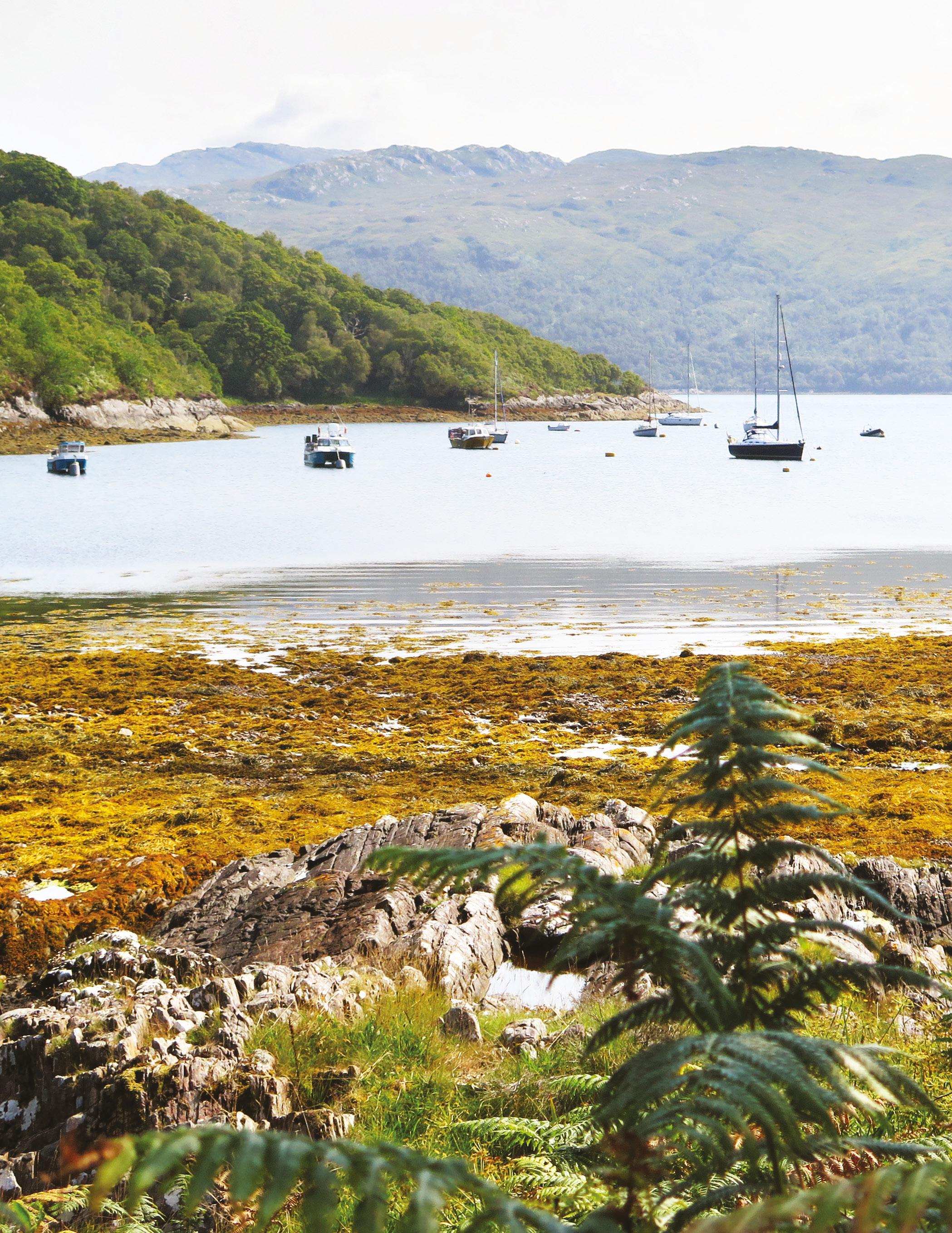

ur intention for the summer of 2021 was to sail our Westerly Fulmar, Ophelie, from our Marconi Sailing Club mooring on the River Blackwater in Essex, up the east coast travelling anti-clockwise towards Scotland. ere is not the space to give a full account of our journey, so this is just a small part of the adventure.
Finally ready, my wife Jane and I, accompanied by our friend Peter set o for our shakedown sail, restoring our sea legs, in home waters via West Mersea, Brightlingsea and on to the River Orwell with the hope the weather would change its mind. Slogging up the Wallet while it blew a vigorous north easterly, the wind over tide produced rather uncomfortable conditions. is was not a very favourable prospect for the next 300-plus miles.
Looking at the weather charts for the following week, I suspected the wind was going to stay in that direction for some time, so a change of plan was rapidly drawn up; we would go clockwise and along the south coast. I understand there is a ‘law’ regarding this phenomenon, so we sailed, in

e west coast of Scotland is acknowledged as one of the nest cruising grounds in the world. Mervyn Maggs spent a summer exploring
southwest/northwest breezes, as far as Plymouth where Peter sadly le us. From here, Jane and I pushed on up the Irish sea and on to our goal of Troon in bonny Scotland, and this is where this bit of the story will begin. is year was blighted with Covid, but as some compensation, the weather as we went further north so ened down and we could move on most days. e plan was that friends, Lawrence, Helen and Benjamin would drive up from Maldon to crew on this part of the voyage. For Lawrence this was a test of his memory and fond recollections of his stomping ground many moons ago, where he learnt to sail in his youthful innocence. All the extra essentials of our crew were stowed in every nook and cranny, hoping that we would all work well together and not wake anyone up in the night due to the necessities of age.
Casting Lawrence’s memory back possibly 40 years of sailing on the Firth of Clyde, we planned to voyage to Oban, with its handy railway connection, so they could return to Troon to pick up their car and go home. On our rst night together, we treated ourselves to some of the nest sh and chips bought from a shop on the sh dock. To prove the excellence, we queued for at least half an hour to order, and another 20 minutes for it to be cooked. Everyone in the queue exclaimed it was worth the wait. Talking of sh, Benjamin thought he might just dangle a line over the
side to pass the time in the marina and to everyone’s surprise he caught a mackerel. is took us all aback and it was decided to return the sh to its habitat in the crystal-clear water full of small shoals of sand eels and fry. is year the water was exceptionally clear, and we surmised it might be because of the minimal rainfall and the lack of peat being washed into the sea from the land.
Sailing from Troon northwards, our rst anchorage was at Little Cumbrae, sailing in light winds that proved to be a good speed for shing. We caught two mackerel that made a delicious starter that evening. We arrived a er ve hours and anchored behind Castle Island where Helen and son went to explore the Castle using the in atable dingy in this quiet and picturesque anchorage; the dingy is a great asset for these parts.
Anchor up the next morning and we made our way east of the Isle of Bute in the Firth of Clyde
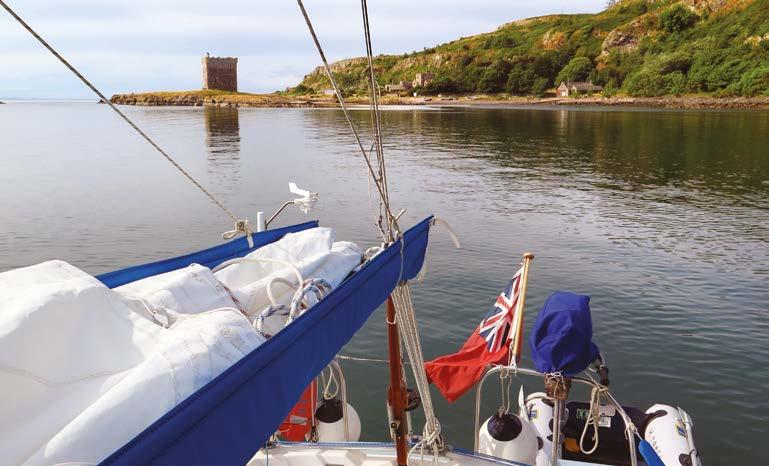

along its corridor of high ground that receded into the Kyles of Bute. e shore around us grew and the channel narrowed, heightening our expectations of what was to come, and we were not disappointed.

Wiggling our way through the Eilean Buidhe, we passed Eilean Mor in limited depth to nd an anchorage just inside Caladha Harbour, to the northwest of Eilean Dubh, in very shallow water and mud ground. Luckily for us we found a place to anchor, as space is very limited. e harbour boasted a lighthouse at one end and proved good for exploring in the dinghy.
e following day we made our way down the West Kyle to Ardlamont Point and headed north to East Tarbert as our next port of call. East Tarbert proved to be a lovely harbour, providing some good walking and a castle to explore. Jane

and I investigated the possibilities of eating out in order to sate our desire for some of the infamous sea food of this area. ere were lots of places to choose from, but they were mostly booked up and o ered too little of what we wanted. Also, we had a desire to eat kippers from these parts, as Loch Fyne Kippers are regarded very highly. So, spotting two old boys drinking in front of a pub, I asked them their advice on purchasing some kippers in the area. Without hesitation, they told us of a local shmonger just around the corner where there would be kippers and much more. ey highly recommended the smoked haddock, the chosen sh for the west coast. It took a while to nd the shop, tucked away down an unmarked alleyway, out of sight of most tourists. We all returned the next morning to buy fresh langoustines, smoked haddock and, of course, the kippers that sated our appetites.
ABOVE LEFT Looking down on Loch Tarbert
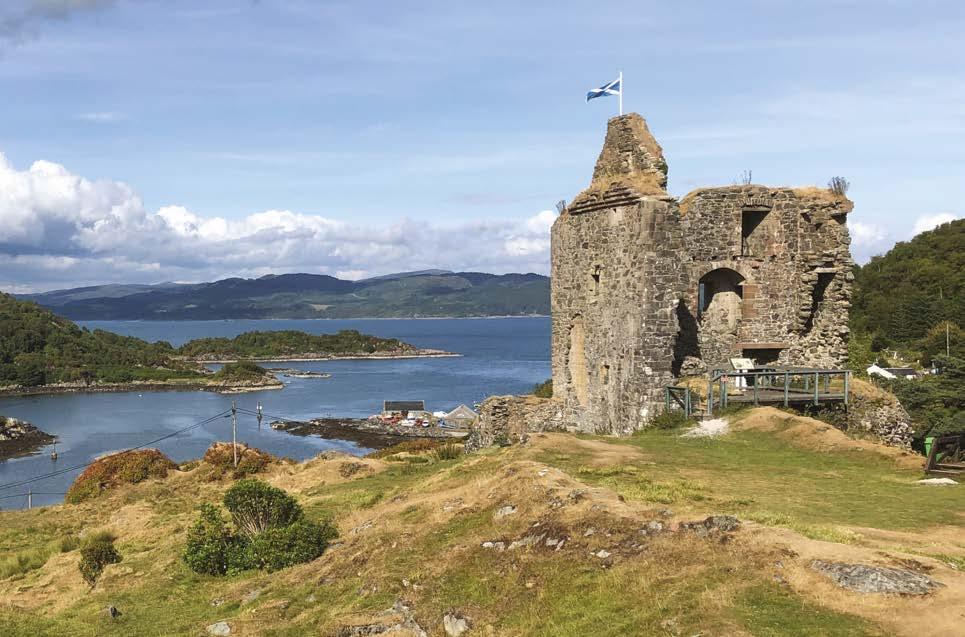

BELOW LEFT Beautiful conditions at Eilean Dubh
Waiting for a lock in the Crinan Canal


Moving on to the Crinan Canal, having booked ahead as required due to the limit on boats that are able to transit, and the reduced opening times of the canal. In preparation we carried a fender board, plenty of standard fenders, two round buoys for springing o plus two long lines. Self-su ciency is required to travel the nine-mile canal, which can apparently be transited in just six hours, but only when it’s fully operational and you have the energy. Further to this, the locks have a high rise and fall, requiring assistance ashore to open and close the gates, long lines and the ability to pass them up to the bollards. We found that a crew ashore, plus two long boat hooks were a very good way of dealing with this.
We arrived at Ardrishaig in the pouring rain at the designated time, crew ready, oilies on and went straight into the sea lock, ready to take on the task at hand. We were
assisted by the lock keepers at some points of that day’s journey through four locks and under one bridge. It was great having crew, I was on the helm and just pointing the boat in the right direction while Jane, Helen, Lawrence and Benjamin all did their bit of taking lines, opening and closing lock gates. For this part of the journey, we decided to take the lock keepers advice and stop before lock ve at Cairnbaan to enjoy the scenery and the pub. The following day we paired up with another Westerly Fulmar that had a willing crew on board, halving the work through a further nine locks and two bridges. Finally, we entered the Crinan Basin and tucked into a snug berth for the night alongside a grass verge in what is a small harbour. We found a café supplying coffee and cakes plus the added benefit of a Clyde puffer tucked away in its berth.

We were lucky to only catch the end of Highland Week, which could have made life extra complicated through the canal, due to the higher number of boats. Luckily, we were heading in the opposite direction as we locked out through the nal sea lock into the Sound of Jura and went onto Oban Marina on the Isle of Kerrera. Here we had a pizza under Covid conditions eating plein air. A request by Benjamin to have square onions on his square Pizza, was met without a blink in our order. We all slept soundly that night. e following morning, we slipped over to the Oban Transit marina to say a sad goodbye to our crew and friends, who caught the train back to Troon to pick up their car and head home.
Oban is a bright bustling port/ terminus with ferries going to all the various islands. ere are also many good shops and places to eat, as well as being an interesting location especially if you like amphitheatres.

But our minds were turned to nding a home for Ophelie over the winter, as it was now midAugust. It was more di cult than it sounded however, due to the lack of yard space taken up by cruising sailors leaving their yachts there for the following season. Staying in the water was one possibility, but not knowing how severe the weather might be we resisted this option. We decided to move on to Loch Etive, home of the famous Connel bridge and with caution of the tide that can run at the loch entrance we made to Dunsta nage
Marina. It seemed a good marina with lovely views, good facilities and close to Oban. We hoped to be able to stay here for the winter, but with no rm commitment from the yard, we started to fret. Our minds were open, but we decided it was time to take in a breath, use it as a base and start to explore the local area and other possibilities.
Now a change of pace as we moved from passage mode, and started exploring new local places. As time went on, we found the waters more comfortable and almost started to consider them as home waters. e necessity to push on at an average of 5kts had been lost, as now we can dri at just 2kts, walk, drink wine, eat well, with the necessary accompaniment of good reading and time to take in the landscape.
Having spoken to a fellow local traveller, Loch Aline was recommended as one of their favourite places to



anchor, with good holding in mud. You can drop to the end of the loch for a peaceful anchorage in lovely surroundings. is was our rst foray into the Sound of Mull, with the wind on the nose we tacked from Dunsta nage. When entering the loch, you see the commercial port side that is used to transport sand for high quality lens-making, but further down it separates you into tranquillity. We found a good place to land the dinghy in order to explore the adjacent rainforest, where there are thick carpets of mosses, many fungi and swaths of ferns. is is very special to this part of the world, and we decided it could perhaps be preferable to climbing hills!
On leaving the anchorage in what seemed benign conditions, we hauled up a very black muddy anchor and set o for Tobermory. All was ne until we reached the end of the loch, where we were met by a brisk northwesterly wind whistling down at a pace that did not suit our sensibilities. So, we turned around and spent the night on the pontoons
ABOVE A run ashore at Loch Aline A seafood lover's lunch at Oban BELOW LEFT AND RIGHT Two di erent views looking out from Obanthat are run locally, and are closer to the entrance. From there we could walk to nd food and provisions.
e following day we gritted our teeth put a reef in the headsail and main sail, for a fast beat along the Sound of Mull, while curtains of rain greeted us, reducing visibility at times. Compensation for this was seeing the landscape change in the many guises of the light, all enhanced when we spotted a White Tailed Eagle diving into the water, regrettably with no catch. We arrived at Tobermory damp but satis ed and moored along a pontoon. e plan had been to stay an extra night, but an easterly was forecasted for our return so, with the belief we would have a fair wind, we le a day early. e following day we set o again to return to Dunsta nage Marina with light winds that were on the nose again. Delighted to spot a Golden Eagle on our trip to the marina, where we had arranged to pick up our friends Peter and Jane the next day. ey were going to stay for a few days sailing
with us. Our visitors arrived to a dreich day, but the following day was dry, so we all set o to Oban Marina on the Isle of Kerrara, a slow voyage, in light breeze taking four hours of pleasurable sailing before mooring up in the Marina to an evening of catching up on life and enjoying the views of the island from the higher ground.
Bit of a shock to wake up the next morning to the sound of foghorns. We had to wait until midday for the fog to li enough to start heading back to Dunsta nage to say a sad farewell to Peter and Jane.
From here we continued our exploration of the Sound of Mull and motor sailed to Tobermory again, ready for our next destination to Loch Droma Buidhe. A lovely free sail was had before we found our way into the narrow entrance, which rapidly opened to a ne, well sheltered and picturesque anchorage with 7.6m water. We were able to tuck behind a rock at the far end and spend a couple of days rowing and exploring this little corner.
ABOVE LEFT Oban Marina on the Isle of Kerrera

Calm conditions at Droma Buidhe
BELOW LEFT
A peaceful mooring at Salen
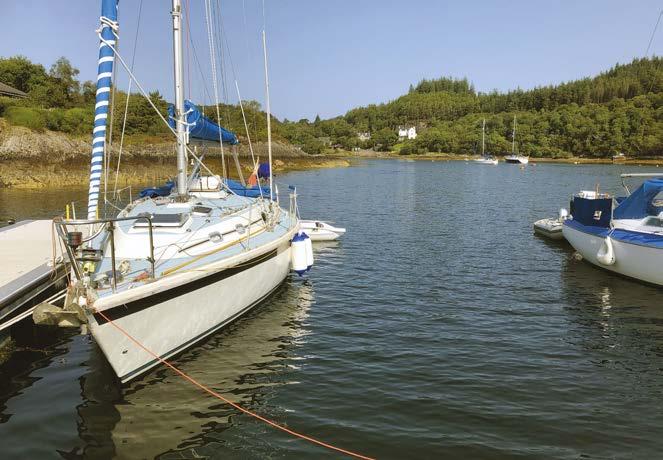
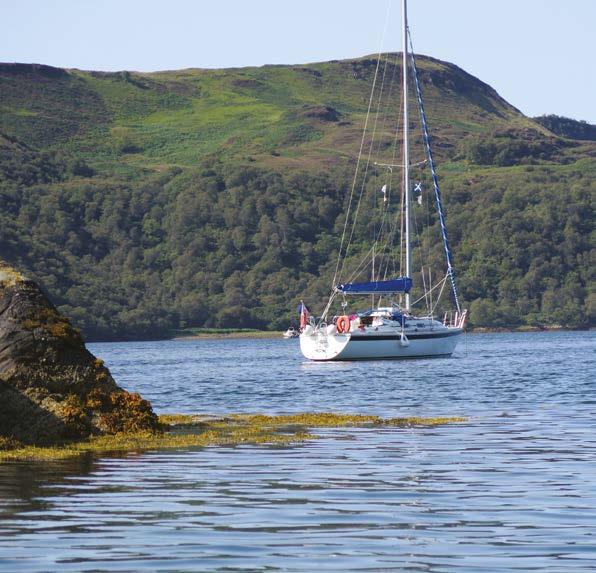
A colourful scene at Tobermory

e necessity to go back and lay the boat up for winter was beckoning, but before this we visited Salen Jetty on the north shore of Loch Sunart. e idea was to try and nd somewhere to eat but to no avail. However we were compensated by lying on a pontoon close to the beautiful but simple jetty designed and built under the supervision of omas Telford. All of this was complemented by good facilities and very hospitable owners.
Now we felt we should more actively search for our winter roost. We were lucky to talk to some fellow travellers, who made a brilliant recommendation. We have been sworn to secrecy under the ‘marina secrets act of 2021 for Scottish waters’! But here we were very kindly found a place only because we were a bilge keeler, so did not need a cradle –another blessing of a bilge keeler. So our season came to an end.
Many thanks to Marconi Sailing Club members who helped in many ways, the Cruising Association, and not forgetting the comradeship of the Westerly Association.
ith a cool, calm and collected nature, Sam Goodchild stands apart from your average o shore solo sailor. ere’s none of the stereotypical nervous energy bubbling away, no unrelenting singlemindedness. Instead, you get the sense that Sam is that type of person whose brain is continually, intently processing, but also ready to hone-in and prioritise as needed. is multi-channel thinking ability is impressive, and no doubt is what stood him apart as skipper of choice for this most multifaceted of campaigns.
Sam is currently skipper of the Ocean Fi y, Leyton – a semifoiling trimaran previously known as the Multi50 – and is backed by French consulting rm Leyton (multi-national specialists in economic, environmental and social transition projects). Not only

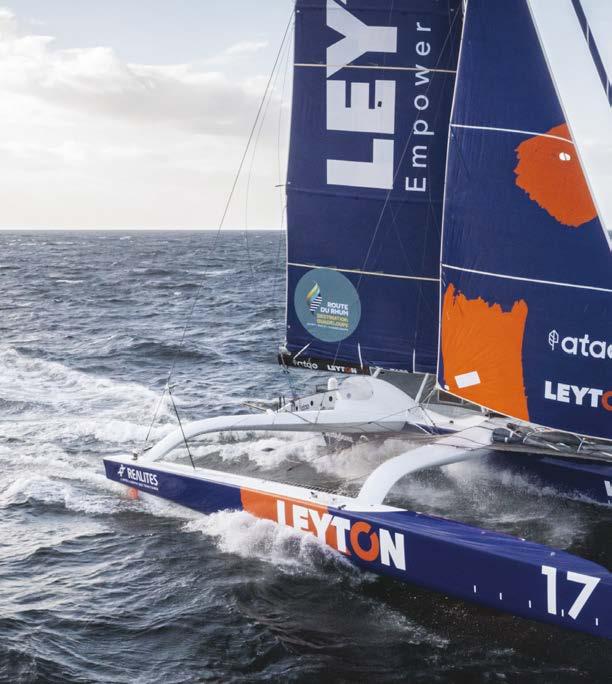
is he campaigning in a number of inshore and o shore races, both crewed and solo, he also has a full calendar of activation events for Leyton’s 2,500-strong tech-savvy employees. e campaign is also enabling a number of pioneering technology partnerships within Leyton’s corporate network, using the Ocean Fi y as a test platform.
It’s a hugely wide-reaching campaign, yet the 32-year old sailor appears energised and in no way daunted.
Lucky that, because sailing this boat takes someone who is on the ball. And in fact – let’s not mince words here – it takes someone who also has cojones
With a 50 beam, the Ocean Fi y is as wide as it is long. Weighing just 3.5 tonnes it packs some serious power to weight punch. Speeds of up to 40kts are possible. It’s not uncommon for these boats to capsize; in fact, exactly that happened to one of Sam’s closest competitors, Armel Tripon, earlier
this year, at a point when the two were in close proximity – an incident Sam admits as being “a bit scary”.
It was thoughts of this sort (ie, impending doom) that I fought hard to keep out of my mind as I joined Sam for a sail on board Leyton and we began blasting eastwards out of the Solent in a solid 20kts, the dark storm clouds skirting the periphery only adding to my trepidation. I’ll be honest, I generally prefer my boats with just the one hull, and I knew this was about to be an experience.
As Leyton powered up, we quickly outdid any other craft on the water, and even when yours truly here was privileged to be offered the helm, we were still notching up 27kts of boat speed. As bullets of water torpedoed up through the trampolines and flew like so many darts into the side of my face, Sam pointed out the retracted windshields and mooted the idea that he could slide them
ABOVE Goodchild aboard Leyton – a boat that requires you to keep your wits about you
Georgie Corlett-Pitt talks to Leyton skipper Sam Goodchild ahead of the Route du Rhum and discovers what it’s like to sail a 50 ocean racing tri…Interview
out for me, before jovially saying “but it’s less fun like that!”
With one bicep aching from trying my best to steer the tri in the way she demanded – there’s a de nite ‘groove’ – and a wind-saltwater concoction stinging my eyes, I relinquished the tiller back to the professional. With a complete absence of grace, I levered my way out of the helm’s deep-moulded plastic bucket seat, and sought relative refuge on what little solid oor the cockpit has to o er. Crikey. I caught my breath in the moment of respite as Sam steered the colossal cra downwind, braced as the mainsail whomped across, the traveller arcing on the giant curved track behind me, and got ready for another kamikaze reach as the hulls once again picked up speed. is time I managed to summon the wherewithal to take things in a little more and now noticed the clean skimming of the hulls over the tops of
the waves. While the Ocean Fi y does have a foil on each of the outer hulls, they are relatively small and as there is no rudder foil, the boat doesn’t fully li out of the water. What the foils do do, however, is to provide an extra degree of stability and they can be raked to maximise bow li in heavy sea states. is means there’s very little chance of pitchpoling; I now realised that sailing this boat is all about managing power. Considering we had a reefed main and a J2 up – not to mention a crew of ve professionals on board – this really was as Sam put it “safe mode sailing”. Not that I was going to let go of my grip any time soon, but it was nice to relax a little and enjoy the ride.

Blasting along, it struck me that spending any amount of time solo on this boat must leave you feeling deeply connected to the elements. Yes, its proportions mean it handles di erently to a monohull of equivalent length
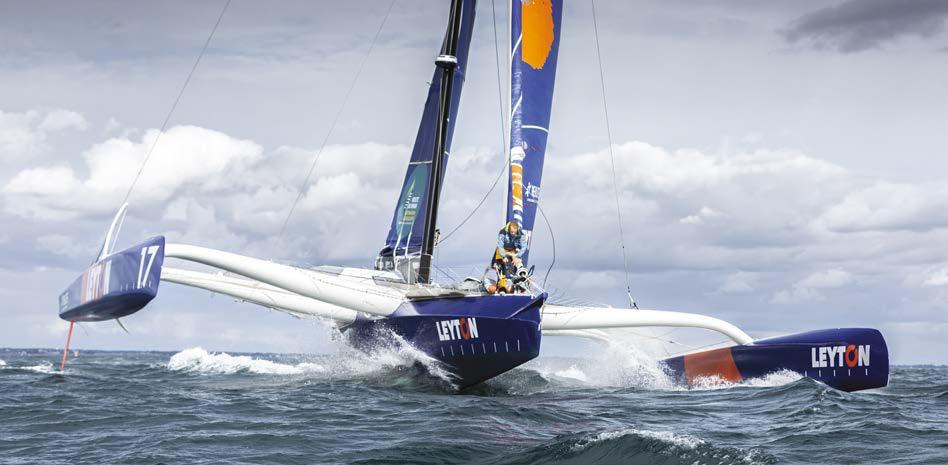
ABOVE At the bow getting ready to head o downwind at Mach 10
BELOW 50 wide and 50 long with a weight of 3,500kg, this is a boat with a serious amount of power behind it

and to me there’s less of a connection in that respect, but the tiny island of a cockpit leaves you precious little in the way of actual boat to stand on. e trampolines, which felt so unnerving to step onto at rst, once underway suddenly seem quite robust annexes – not that you would want to spend any time hanging around on them; even in 20kts, the Ocean Fi y’s rapid acceleration betrayed her capacity to shrug the unwary o her transom, and the adage ‘one hand for yourself, one for the boat’ sprang to mind as I once again gripped tighter. ankfully, designed as it is for singlehanding, the boat can almost entirely be sailed from the sanctuary of the cockpit – a veritable hub of halyards, control lines, electronics, winches and a pedestal grinder. Headsails and genoas can all be furled from here, and the wingmast and daggerboards adjusted, which keeps things simple and safe for the solo skipper.
Later, as we motored back to the pontoon at Gunwharf Quays, with a RIB on hand to nudge us sideways into the berth, I jumped several feet directly down below to check out the, ahem, living quarters. Sparse doesn’t cut it. I’m plenty used to seeing stripped out race boats with nothing but a jet-boil in the way of home comforts, but the cavernous quarters of a monohull are nothing short of palatial when compared to the slim con nes of the Ocean
Fi y’s cabin. is felt more like an oversized locker, with barely space to roll over – and that’s assuming Sam nds any time to sleep! On the plus side, he’s a mere four ladder rungs away from being back up on the deck pronto should he need to be – oh, and the emergency escape hatches do provide some nice watery views, but otherwise, there’s little to recommend this as more than a refuge space.
Back on dry land, my rst question to Sam is how he feels about sailing this incredible beast of a boat singlehandedly? I suggest to him that he must nd it at least a little intimidating – but with his characteristic understated con dence, he assures me not. When you think of his past experience, with a Volvo Ocean Race and a Jules Verne Record attempt, as well as time spent racing the Class 40, Figaro, MOD70 and Ultime classes, his assertiveness seems plausible.
However, he confesses that it was a di erent story two years ago and sailing the boat “seemed impossible” when he rst took on the role of skipper.
In the time since, he has concentrated everything on nding precisely where the limits lie, and is “much more relaxed” when sailing as a result. He says: “Figuring out how can we go fast to win the race at the same time as being able to be relax enough to go to sleep and also not capsize is what occupies me most of the time. My approach has been to nd where the comfort zone is, putting in hours and hours of sailing, especially in stronger winds, to learn
what is safe. It’s everything from daggerboard height and foil settings to wind angles and sail settings. It’s about learning what is safe, and also knowing what my next move will be.
“Earlier this year I did a solo race where we had really unstable conditions; although the wind was not necessarily that strong, there were some strong gusts that went from 5-30kts – and it was the middle of the night, pitch black, with all the sails up. It sounds unpleasant, but it was really good for learning what I can actually get away with because I was pushing the limits without really meaning to. It was good just to go, ‘ok, well, I didn’t know you could go in 30kts with the full main up and the gennaker, and actually get out of it on my own’; I’ve never done that before; and now we’ve done it and I
don’t want do it again – but I know I know what to do if it does happen!”
All controls lead back to the cockpit
Although he has put plenty of hours in, it’s not all been trial and error; Sam – who is bilingual in English and French a er an early childhood spent in the Caribbean – is fortunate to have had the likes of Seb Josse and omas Coville sail with him on board, and he has Aymeric Chappellier as his full time team manager who also coskippered last year’s Transat Jacque Vabre with him; before that, the two were rivals in the Class 40.
When asked what motivates him to take on such a big challenge, Sam’s answer is simple: “I like learning,” he says. “ at’s what has driven me throughout my whole career, from dinghies through Figaros and Ultimes. Every boat you go on you learn something new, which is really cool.”
With eight Ocean Fi ies now regularly competing, Sam says the rejuvenated class o ers an appealing balance: “It’s got the performance of an Ultime – albeit not quite as fast – and the eet racing of the Figaros – albeit not quite as many boats. But I really like that combination of having a high-performance challenge at the same time as close racing.”
Sam is certainly making his mark on the class, having already this season won the Drheam Cup and the 1000 Milles des Sables solo races, and nished second in the crewed Pro Sailing Tour – a new


inshore/o shore competition for the class with events spanning from Corsica to Brittany via Cowes.
Now, he’s focussing everything on the upcoming Route du Rhum, a 3,542nm solo race that sets o on 6 November from St Malo, France to Guadeloupe, which should take around two weeks. He’s hoping for some windy weather – the sort of conditions in which he says a race like the Route Du Rhum “can be won or lost in”. But a er dismasting in the last edition (in 2018, while lying third in the solo Class 40 eet) this time round he is determined, and the next few weeks will be spent sail testing and doing full gear checks to ensure absolute reliability. He describes his growing technical team as “brilliant” and says the pressure is on not to let anyone down. “I’ve seen the time and the e ort everyone puts in behind me to make sure the boat is ready and in a good place, but on 6 November there will be no one else on board. I’m trying not to put pressure on myself, but I want to have a good race and I’ll do my best,” he vows, adding: “It’s all about controlling the controllables.”


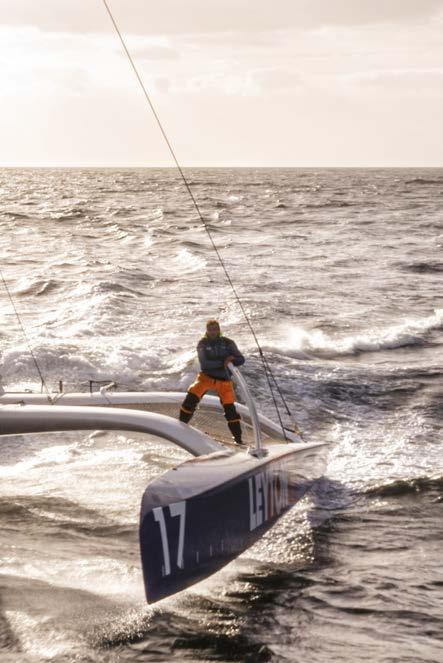
e challenge – and appeal – once the race is underway will come in sorting the priorities, as Sam says: “I enjoy having so many things to think about, but you can’t possibly do everything so you have got to decide, ‘okay what’s my priority now? Is it
sleeping, is it looking at the nav, is it xing that thing that broke yesterday, is it trying to go fast and driving?’”
In addition to maximising the boat’s performance, Sam will also be facilitating technological research and development brought about through Leyton’s client partnerships; these include solar panel technology that can be incorporated into sails and will eventually be upscaled for use on cargo ships, as well as a sleep monitor headband for use by the medical industry. He’s excited and fully engaged by these as he talks through the mutually bene cial opportunities that such an “ecosystem” o ers.
Sam has also been keen to give back to the sailing community, and so last year the Leyton sailing team established a close tie to e Magenta Project. Much of the impetus for doing so comes from a strong emphasis on equality ingrained from his own upbringing, as well as a wish to break down barriers in o shore
multihulls, where experience is a pre-requisite but it’s di cult to gain.
e initiative is already having an impact. Last season, Leyton entered the rst mixed team into the Pro Sailing Tour in which they nished rst, and this year around 35 female sailors have sailed on board Leyton, from Olympians to students to pro o shore monohull sailors, including a group who, under Alexia Barrier, are now planning a Jules Verne attempt.
“I know from my own experience that it’s o en the rst step that’s the hardest,” explains Sam. “Our aim is to open some doorways and help to get more women into the o shore scene. We’re not going to revolutionise the world, but if we can make a small di erence then that’s great.”
Alongside all this, Sam still has his sights set on his own ultimate goal; the Ocean Fi y may be an exceptional challenge, but this ballsy sailor doesn’t intend to stop here.
“I just love doing new things and challenging myself,” he smiles. “I’ve been driven by doing the Vendée Globe for a long time; that’s driven by wanting do something that seems stupid and impossible. Two years ago when I got this boat, I had no idea how I was going to sail it across the Atlantic on my own. But little by little you break it down and you build up your con dence, you learn what works and what doesn’t work. And I realised that people have done it before, so why can’t I?”
ABOVE Cool, calm, collected and, most importantly, in control BELOW Next stop, Route du RhumExcess catamarans continues in its quest to blend performance, comfort and a ordability with its new 14. Has it succeeded? Sam Je erson nds out
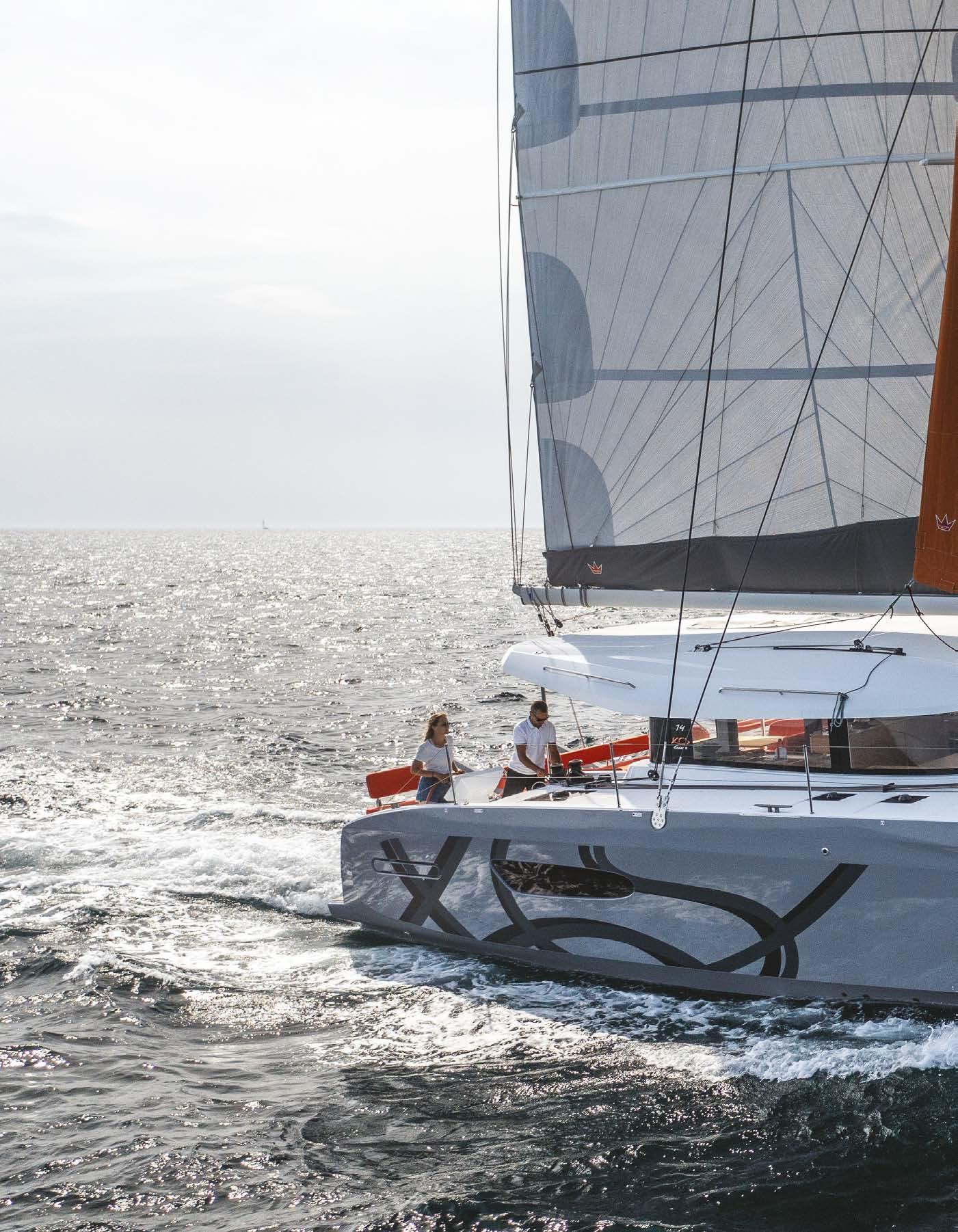

Some years back Lagoon Catamarans came up with what appeared to be a stroke of marketing genius. e company was – and still is – the largest manufacturer of cruising multihulls in the world. Yet the world was not enough and the company wanted more. Much as our incumbent prime minister is xated on growth, so too did Lagoon and it opted to aim its sights at a younger market. e result was the Excess catamaran range; cruising catamarans, which were jazzed up with stylish interiors, bigger rigs and more sensitive handling, thanks to twin outboard helms. e marketing behind these boats was incredibly slick but the rst couple of models o the production line were a bit, well, familiar. is was because they were cannbalised from existing Lagoon moulds with new decks, rigs and interiors. Life is all about compromise – unless you are the incumbent prime minister that is – but some felt that compromise had gone too far. Including, as it turned out, the bo ns at Excess who came to realise if they wanted to create a distinctive brand, they were going to need a distinctive product. It was also noted that the cost of cannibalising and modifying existing moulds to make a new boat was really not worth the hassle. With this in mind, the Excess 11 was built as an entirely new boat,
which bore nothing in common with the Lagoon range save for two hulls, the same designer in VPLP and a ercely competitive price. e new Excess 14 follows on in that theme.
So this is their fourth yacht in the line but their second ‘pure’ design and it sticks with the theme of sportier handling combined with good internal volume and comfort. e boat marks out its sporty credentials with the twin helms, a powerful rig, sporty look, asymmetric hulls, and deeper rudders than a standard cruising cat. Meanwhile, its cruising DNA is on show with the lack of daggerboards and the well appointed and roomy interior plus extensive lounging areas. As mentioned, this model
ABOVE the hulls are asymmetric, which helps de ect waves and are very ne at the waterline
Note the distinctive 'step out' of the hull above the waterline
has been designed by VPLP, a company that taps into a vast well of knowledge when it comes to designing both cruising and racing multihulls. e boat has been quite aggressively styled with dreadnought bows, while underneath the water the asymmetric hulls – very rare on a mass production catamaran – sweep back to a fairly deep keel providing good amounts of grip. ere is higher clearance on the nacelle than on a standard Lagoon and this, combined with the asymmetric hulls, should keep slamming to a minimum. Unlike earlier models in the Excess range, she has an overlapping genoa as standard and this, married with a low boom and square top mainsail, gives lots of power – which can be further enhanced if you select the Pulse Line upgrade, which provides a yet larger rig on a carbon bre mast. Weight has been kept down to a modest 11,700kg thanks to foam sandwich construction with carbon bre reinforcement. is means that, while the 14 is no lightweight ier, the boat is certainly not on the heavy side. e boat is, in e ect, sitting in a niche between, say, the Nautitechs of this world and the pure blue water performance multihulls such as Windelo, Catana and Outremer


Step aboard and the most obvious and notable feature compared to many rivals are the twin helms set well outboard, each with somewhat
distinctive curved biminis providing protection from the sun. e only rival which provides this set up is Nautitech – although Outremer’s 4X mixes it up with tillers and wheel steering – but this is not a boat pitching directly against an Outremer. e main advantage is, of course, greatly enhanced feel. e downside is that visibility can be slightly compromised when manoeuvring compared to a cat with a bridgedeck or raised helm station – although this is well mitigated on the Excess 14 thanks to lots of non tinted plexiglass, meaning you can see right through the coachroof. e main helming station is to starboard where the electronic throttles and all running rigging is to hand. ere is


the option to have a repeater throttle at the port station too. e running rigging runs down the starboard hull just outboard of the coachroof and the side deck is su ciently wide that this is not a problem. e ropes are led to a bank of jammers and controlled by twin Harken winches just to the le of the helm station. e only running rigging led to port is the halyard for the Code 0. e cockpit is roomy as you’d expect with a solid bimini providing shelter. e space feels uncluttered and there is an L-shaped seating area to port that can seat eight, plus further seating to starboard with storage and a fridge contained within this pod. e cockpit is nicely enclosed by a bench seat a

A light, bright interior with masses of space

ABOVE RIGHT the indoor/outdoor nature of the living space is unmistakeable
BELOW LEFT Twin helms feel more direct and give better feel and involvement
BELOW RIGHT ere is a small nav station to port in the saloon
with further storage underneath. Behind this is a very long mainsheet traveller, which provides good scope for tweaking. Beyond that are the davits for the dinghy and a pod for the lifera . Up forward one of the notable features is that low boom, which has about 30cm clearance from the coachroof and makes stowing the mainsail a lot less of a trial than it is on many multihulls. Despite this low boom, Excess has tted what it calls a ‘skylounge’ with seats and a recessed footwell in the coachroof, which provides a nice seating area when you are in port. Meanwhile the seat backs fold down when you are under way so the boom is unimpeded. On the foredeck, the bridge is short, which reduces














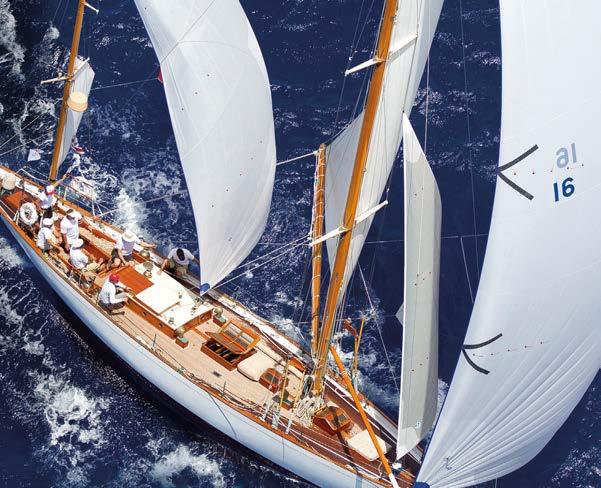

































pitching by reducing weight forward. ere is the usual storage and a long (optional) bowsprit, which does substantially boost length. is is a boon for sailing but a bit of a pain when it comes to mooring fees. ere is also the option of a small, skipper’s cabin forward.
Down below is a total misnomer in a multihull of this nature, as the transition from outdoor to indoor is seamless and step free via sliding patio doors. e interior is incredibly light and tted out in a stylish, contemporary New York lo style.

is is a useful term but having never been to a New York lo I guess I’m rather talking through my hat. In lay terms it means there are a lot of pastel colours, and the space feels
light and modern without being stark. Ultimately, it looks very stylish and uncomplicated. e galley is set a to port with the fridges and additional worktop space a to starboard. Forward of this is a nice seating area with plentiful storage. ere are several options on the layout, and they are targeting couples working from their boats – the digital nomads – with a large o ce area with desk and a exible space upfront which you can use as a dressing area, workshop or cabin with extra berths e standard con guration is with one hull set up as the owner’s suite, but there is also the option of a four cabin version with four cabins, four heads and four separate showers. I tested the version with the full owner’s suite and this was an area with masses
A palatial owners saloon is set a in the starboard hull
Forward of the owner's saloon is a walk in wardrobe that can easily be converted into twin berths


A big rig and modest displacement ensure this is a speedy boat
of room, which included a walk in dressing room forward but this could be converted into twin berths in case you had extra guests. It was an interesting feature that made the boat extra versatile. e overall feel down below was very good and the feeling of light and space was very notable.
e day of the test sail dished up very modest breezes in the bay of Cannes, with the wind peaking at about 12kn. We headed out of a su ocating marina and made sail with minimal e ort. e controls really are very simple and de nitely keep things uncomplicated for short-handed sailing. Everything was well to hand and the boat is clearly well thought out. Sails up and the boat behaved very responsively in the modest conditions. We were sailing alongside a Windelo 54 – also on test – and the smaller boat certainly didn’t disgrace itself. Indeed, with a Sail area to displacement ratio of 26.5, the Excess has every right to mix it with the big boys, particularly in light airs. Grip seemed to be good on the wind thanks to those deeper integrated keels, while the steering was far more responsive than you would enjoy on, say, a Lagoon of similar size. With the Code 0 unfurled we were soon skipping along at an impressive clip, despite the conditions, and opted to thread the channel between the Iles de Lerins o Cannes. is is a congested passage with lots of boats at anchor but the easy handling meant it was stress free. e cockpit set up made for a convivial setting and the overall feel was very good. I just wish there had been a tad more wind. as I don’t think it would have taken much for the boat to take o .

Excess has come a long way in a very short time and the 11 and 14 have ensured that the brand steps clear of the shadow of Lagoon, and stands alone as a clever and innovative marque in its own right. e 14 felt well balanced, and the aim of providing enhanced performance in a user friendly package has been achieved. is is impressive as Excess treads a ne line between full blown ‘production’ multihulls and
the more technical fast cruisers, which are much more pricey. e 14 ts perfectly into that niche and also promises to be a great yacht for owners whose rst love is a monohull but are willing to be seduced by a multihull that handles well. It does all of this with a great deal of style to boot.
COMFORT:
BLUE WATER ABILITY:
LOOKS:

A similar boat in terms of the line it treads between comfort and performance. is is a boat that shares the twin outboard helms, which enhance handling and feel. e boat is a few years old now but continues to enjoy broad appeal. nautitechcatamarans.com
Excess is an o shoot of the Lagoon brand and it is therefore logical that the 46 is a very credible alternative. Comfort is slightly up and the interior has a di erent feel to the Excess but performance levels are lower and there is a single helming station. cata-lagoon.com








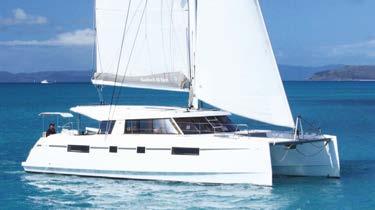


A popular mid range catamaran from the La Rochelle-based manufacturers that prides itself on producing boats with a mix of high levels of comfort but lively performance. is is a slightly di erent beast to the Excess as it has a single helm station to starboard but performance levels are not dissimilar. catamarans-fountaine-pajot.com



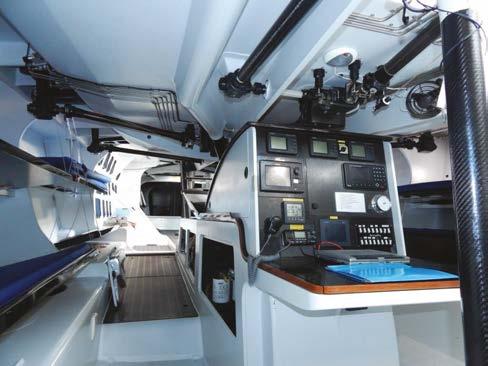
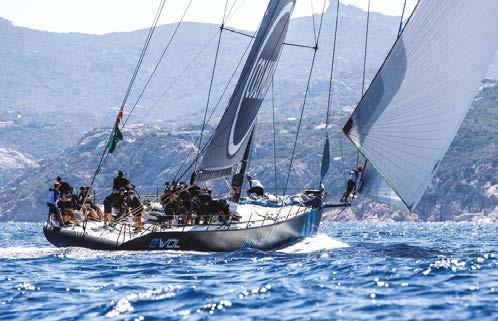





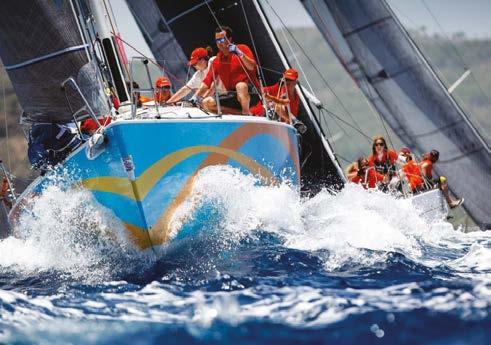



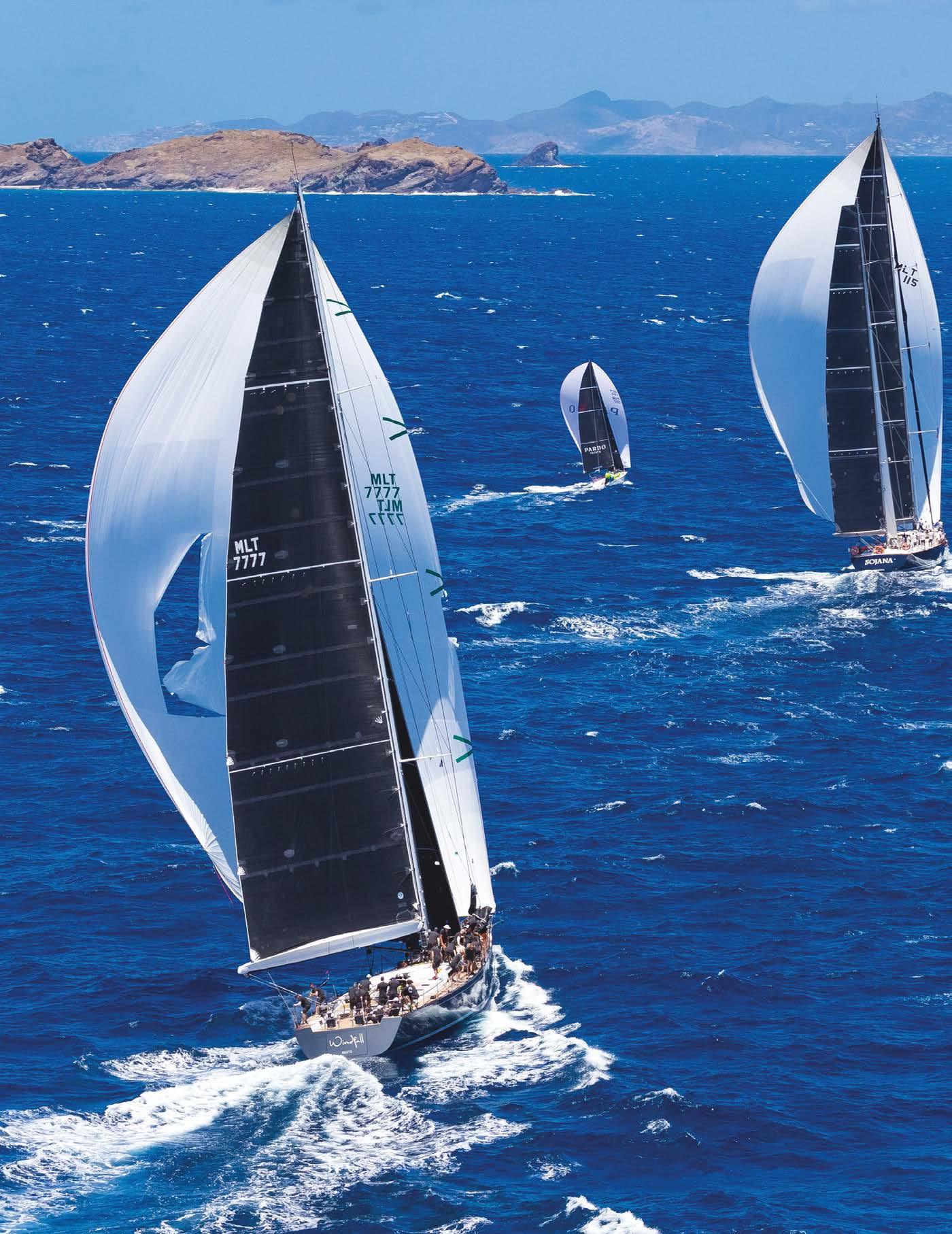
he start of the Caribbean racing season signals a step change in the racing calendar. e racing circuit in Europe is fascinating and challenging; ckle then erce winds in the Mediterranean, and erce tides in the Atlantic can turn races into a fascinating game of chess. In the Caribbean though, things take on a new dimension. is is racing with the contrast and the volume turned right up. For those of us who battle on through the European winter, scraping ice o our decks, we can only watch from afar with admiration as racers do battle before the booming trade winds, launching their yachts o mighty Atlantic swells as they roar around race courses. is season all the old favourites are back. Covid has been banished as a bad memory, and once more the yacht clubs and marinas thrum to the excitement of a full racing season. A season rich in excitement and driven forward by the roar of the Caribbean swell, the regular thrum of the faithful trade wind, the sing song of the cicadas, and a persistent reggae beat. So grab yourself a rum punch, sit back and enjoy our guide to this year’s events.
Flung out to the eastern edge of the Caribbean, Barbados is known for its party vibe. Barbados Sailing Week is one of the big season openers, and this week long event includes the 60nm Round Barbados Race, an event with 19th century origins. For potential record breakers, there’s the incentive of winning the skipper’s weight in Mount Gay rum, which ensures the event attracts top class competition. A string of coastal races completes the series. roundbarbados.com

Grenada, the ‘isle of spice’, provides a colourful backdrop to Grenada Sailing Week, an event that has been gathering real momentum in recent years. e event will kick o in Tyrell Bay, Carriacou and Monday sees the Carriacou Round Island Race, then Tuesday the eet races down to La Phare Bleu Marina in Grenada. e layday is Wednesday, with ursday and Friday ending at Camper & Nicholson’s Port Louis Marina. grenadasailingweek.com
With the racing calendar back up to speed, this year’s Caribbean season promises to be the hottest ever
RORC’s Caribbean 600, now onto its 14th edition, has well and truly established itself and has become a rm highlight of the Caribbean racing circuit. Early entries for this year’s 600 mile chase around 11 islands include a diverse and highly competitive eet. Setting o from Antigua Yacht Club in the picturesque English Harbour, the tour takes in St Kitts and Nevis, Anguilla and Guadeloupe, making for an exciting and challenging race.
caribbean600.rorc.org
Entries have recently opened for the St Maarten Heineken Regatta. is four day event is a stalwart of the Caribbean calendar and one that prides itself on its green credentials, being a paperless regatta that also bans polystyrene and runs a number of community beach clean up operations. Organised by the Sint Maarten Yacht Club, racing takes place in the sweeping Simpson Bay o the southwest corner of the island. e event is always well attended with the record number of competitors being in 2008 when 284 boats raced.
heinekenregatta.com
e island of St omas is the largest of the US Virgin Islands and o ers stunning tradewind racing and equally magni cent scenery. e regatta is typically laid back, promising the quintessential

beachfront vibe, but don't let that fool you! is is a high octane event, famed for being a chance to trade tacks and tactics with America’s Cup, Volvo Ocean and Olympic crews. e regatta includes Round the Rocks Race, which navigates by the neighbouring island of St John. For crews registering before 31 January 2023, there’s a 50 per cent discount on entry fee. stthomasinternationalregatta.com
Antigua Sailing Week has been a rm favourite with returning crews, both professional and amateur alike, for over 50 years. Entries are already open and plenty more are expected to follow. Organisers are promising an exciting and responsible regatta,
RORC Caribbean 600
with a strong focus on competitive and enjoyable racing. Some course updates are being made in response to competitor feedback from previous years. Schedule highlights include an exciting one-day round Antigua Race, plenty of close racing o English and Falmouth Harbours, and daily prizegivings at Antigua YC. Spectators can enjoy views of the starts from the Shirley Heights Lookout, and there are many white sand beaches to enjoy – one for every day of the year, or so the locals say!
Sailingweek.com
e BVI Spring Regatta and Sailing Week, hosted by Nanny Cay, has a packed schedule in store, promising something for everyone, racers and
cruisers alike. ere are two days of warm up racing o ering the chance to explore the beauty of the BVIs, before three days of more intense racing gets underway. It’s a winning combination for many, that has been honed over nearly 50 editions of the event. ere are 18 classes, with courses navigating rocks and islands, promising a hugely varied and challenging programme of racing. e regatta prides itself on green initiatives such as eliminating single use plastic; in 2019 it introduced winners' awards made from hurricane damage materials, and skippers' bags made from recycled sailcloth. bvispringregatta.org
ABOVE e winter season in the Carribean brings plenty of breeze and adrenalinelled racing
BELOW e super maxi Comanche took line honours in the 2021 RORC Transatlantic Race

e 12th edition of the Superyacht Challenge Antigua is a week long regatta that pits some of the mightiest superyachts against each other. superyachtchallengeantigua.com
e island of St Barths has long enjoyed a reputation as a top end, glitzy spot and this spirit is epitomised by the St Barths Bucket, which was conceived for top end superyachts such as the J-Class to race together and it has
developed to become the biggest superyacht regatta in the world. bucketregatta.com
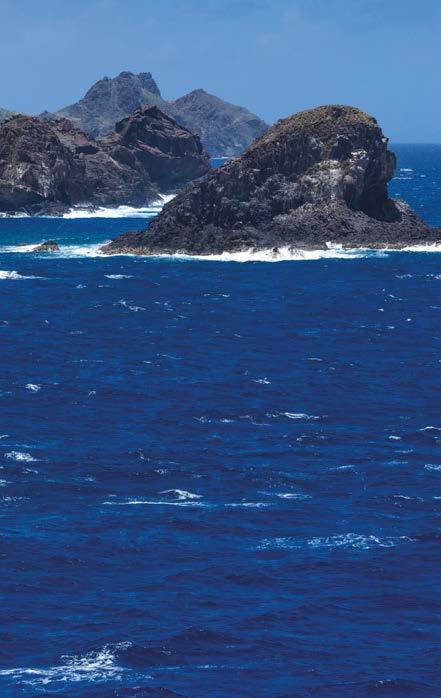
Conceived in 2010, Les Voiles de St Barth has a relatively short history but its rise has been meteoric to the point that it has become one of the biggest races in the Caribbean calendar. Yachts are measured on the CSA handicapping system with classes ranging from the Maxi down to the One Design Diam 24 trimaran class.
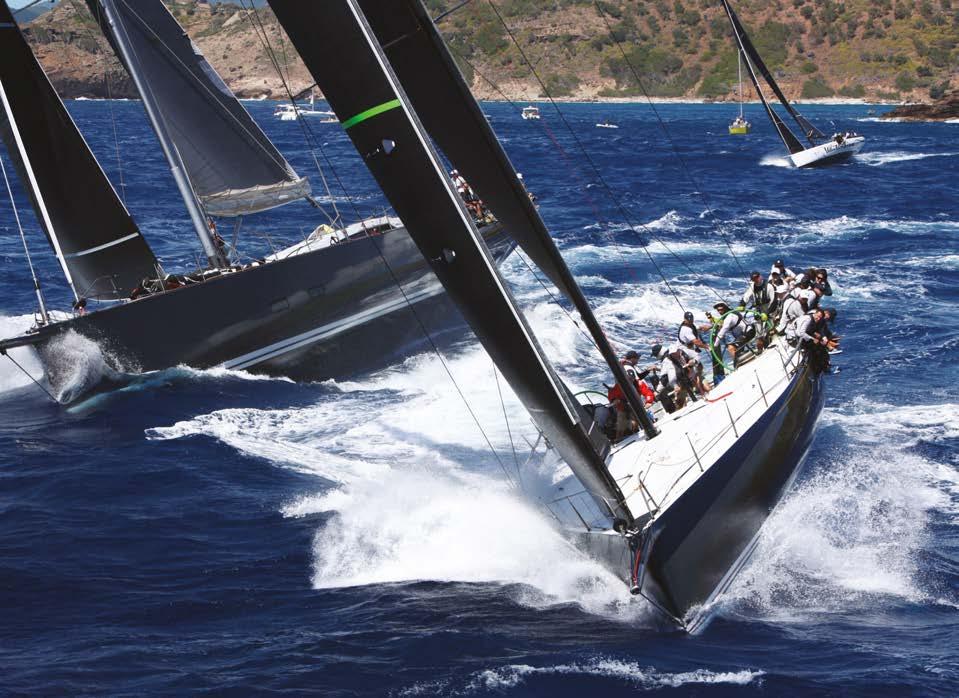
lesvoilesdestbarthrichardmille.com
RORC’s decision to include a transatlantic race in its schedule settled the age old question of how to get your boat to the Caribbean, by allowing you to do it in real style. This is the longest o shore race in RORC’s calendar and is set to depart 8 January 2023 from Puerto Calero, Lanzarote, Canary Islands. Run in association with the International Maxi Association and the Yacht Club de France, over 20 teams are expected to race the 3,000m course to Camper & Nicholsons Port Louis Marina, Grenada. Racing under IRC and MOCRA Racing Rules, the RORC Transatlantic Race is open to Monohulls, MOCRA Multihulls and Classic yachts ranging in size from 30ft (9.15m) LOA. Two-handed entries are also eligible.
The 2022 edition dished up a thrilling battle with the winner of IRC One, Ross Applebey’s 1987 Oyster 48, Scarlet Oyster came short of snatching the overall win by just over an hour in a breathtakingly close race to the finish. They went on to take second place overall by a nail-biting 115 seconds from David Collins’ Botin 52 Tala competing in IRC Zero. The 100ft (30.48m) VPLP Design/Verdier maxi Comanche, skippered by Mitch Booth was the eventual winner of the RORC Transatlantic Race Trophy for the best corrected time under IRC. The team also set a new Monohull Race Record of 7 days 22 hours 1 minute 4 seconds, beating the previous record by over two days, and completed a hattrick, winning the IMA Trophy for Monohull Line Honours, IRC Super Zero and the Yacht Club de France Trophy.
Awinter sun sailing holiday is probably one of the best antidotes to our busy working and o en monotonous lives in the UK. Add the Caribbean and some competitive racing to the mix, and images of life’s daily routine back home, particularly in the depths of winter, disappear almost instantaneously.
e Caribbean with its guaranteed sun and good winds has not only become a favourite choice for charter holidays in general over the winter months, but it has also become a destination for those keen to embrace the hugely popular Caribbean racing scene.
e season runs from January to April avoiding the hurricane period. e good news is that there are now so many charter companies specialising in Caribbean race charter and Transatlantic crossings.
ere is plenty of choice to either sign up as a crew member aboard a yacht with a professional crew, or charter your own yacht.
When it comes to choice, there are at least 11 Caribbean regattas to choose from (see page 58 for a list of some of the most popular regattas).

Although the Caribbean season kicks o on 8 January with the RORC Transatlantic Race and o ers the opportunity for a quick sprint across the ‘Pond’, for those with more time to spare, it’s worth considering the Atlantic Rally for Cruisers (ARC). is annual rally, which starts on 20 November and takes between 18-21 days to complete, is one of the most popular events on the blue water cruising calendar, with a direct route of 2,700nm of ocean sailing from Las Palmas de Gran Canaria to Saint Lucia.

While most teams taking part in the ARC are aboard privately owned yachts with family and friends, companies like LV Yachting, Kraken Travel, and First Away Yacht Charters specialise in this event so, if you fancy a challenge, it could be worth bagging a last-minute spot. Another idea is to register at oceancrewlink. com, a website dedicated to matching
ABOVE LEFT Sunsail charter yachts are regular competitors at places like St Maarten Heineken Regatta
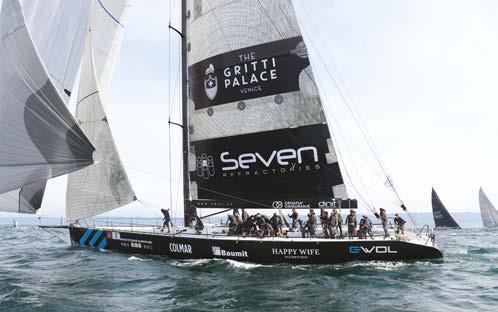
Signing up for a berth on a race charter yacht is a good opportunity to learn the intricacies of racing, such as a good start BELOW
LV Yachting's Reichel Pugh-designed Super Maxi 86 Way of life
teams/crew for ocean crossings.
Once in the Caribbean, the rst event of the season is Barbados Sailing Week that encompasses the Round Barbados Race – a classic 60nm ‘pipe-opener’ – which is taking place on 18 January. For this and most of the Caribbean regattas such as Grenada Sailing Week, Caribbean Multihull Challenge, RORC Caribbean 600, St Barts Bucket, and Antigua Sailing Week, check out LV Yachting. is company specialises in bespoke race charter and has a huge selection of grand prix, performance racers including Way of life. is is an iconic Reichel Pugh-designed Super Maxi 86, with an enviable racing history across the globe. She is available to charter for the RORC Transat, and events in the Caribbean and Mediterranean.
LV Yachting also prides itself on linking up teams with the best boats for their regatta of choice. If you are looking for an individual berth spot with LV, there are two key events – RORC Caribbean 600, and St Maarten Heineken Regatta.
Global Yacht Racing is another good option to consider with plenty of events on its list including Grenada Sailing Week, St omas International Regatta, BVI Spring
e ultimate way to really embrace the delights of the Caribbean is to sign up for a race charter at one of the many seasonal regattas says Sue Pelling
Regatta and Les Voiles de St Barth. is company not only o ers a vast choice of performance yachts to support bespoke charter requirements, with its Silver, Gold and Platinum level options, but it also caters for individuals or groups keen to join race-winning teams at Caribbean hotspots like Grenada Sailing Week.
Ondeck, which is based in English Harbour Antigua, has been part of the Caribbean race scene for many years and is particularly popular for individual charter berths and groups looking to really embrace the Caribbean Regatta season. As well as the racing, at places like Barbados Sailing Week, Grenada Sailing Week, RORC Caribbean 600, St Maarten Heineken Regatta, St omas International Regata, BVI, Les Voiles de St Barth and, of course, Antigua Sailing Week, the sta at Ondeck will ensure you experience the Caribbean racing scene at its best.
For popular events like the BVI Spring Regatta, there are plenty of charter options including some well-known companies such as e Moorings and Sunsail, both of which have a selection of monohulls and multihulls available.
If you know which regatta you want to take part in, you can narrow down your search for a yacht or berth, by heading straight to the event’s charter listings on their website. You’ll see most regattas not only promote the larger known companies like Dream Yacht Charter – Antigua Sailing Week’s o cial bareboat and by-the-cabin
charter sponsor – but they also support local charter companies.
Events like St omas International Regatta in the US Virgin Islands lists several including St omas Sailing Centre that has IC24s for charter for exciting, highly competitive J/24-style racing. For a blast around Barbados, check out Sail Racing Academy.


Grenada Bluewater Sailing is one of many independent companies with a racing yacht and skipper for charter. As well as the popular events like Antigua Sailing Week, and Grenada Sailing Week, this company goes slightly o the ‘beaten track’ taking in some smaller, fun, traditional regattas such as Bequia Easter Regatta, and Carriacou Regatta Festival.
Scarlet Oyster, Ross Applebey’s successful Oyster Lightwave 48 charter yacht, is heading to the Caribbean again in 2023 via the RORC Transatlantic Race in January and will be competing on the Caribbean race circuit once again.
For something slightly di erent, look at the adventure sailing holiday company Rubicon 3 that o ers racing berths aboard one of its 60 expedition yachts at Grenada Sailing Week, St Maarten Heineken Regatta,
ABOVE Sunsail charter guests enjoyoing the delights of Caribbean racing

High speed racing aboard LV Yachting’s Cape 31
and the RORC Caribbean 600.
For bareboat options check out boatbookings. com, islandcharters.co.uk and A2A Yachting, which says it can organise charter for most major formal regattas including skippered racing monhoulls, or luxury crewed superyachts.
Finally, whatever you decide to do, you can be sure it will be a holiday you’ll never forget. Pack your shorts, deck shoes, t-shirts, hat, sunglasses, gloves and copious amounts of sun protection cream, and you are good to go. Most charter sailing holiday companies supply lifejackets, and heavy weather gear, so you really don’t need huge amounts of kit other than the essentials mentioned above, and a change of clothes for dining out.
lvyachting.com islandcharters.co.uk globalyachtracing.com kraken.travel firstawayyachtcharters.co.uk ondecksailing.com grenadabluewatersailing.com dreamyachtcharter.com stthomassailingcenter.com a2a-yachting.net rubicon3adventure.com boatbookings.com
Scarlet Oyster –Facebook: ScarletOyster/ sailracingacademy.org

n June 1822 three sailors set out from Livorno on the Tuscan coast of Italy and headed for their home port of Lerici, some 36nm up the coast in a 29 yacht. e weather was hot and thundery, the boat was heavily canvassed and open with no deck. She was seen heading north at a good clip before disappearing from sight as she sailed into the murk of a thundery shower that passed to the north of the town. e crew were never seen alive again. is brutal little vignette was played out in the great days of sail with monotonous regularity. Death was a simple fact of, well, life. What makes the story stand out was that among the crew was the poet, Percy Bysshe Shelley. Indeed, he was the owner of the boat, and the death of a notable romantic poet has seen the circumstances of the voyage revisited and pored over endlessly.
I wouldn’t say that it was exactly the aforementioned poet’s misfortunes that led me to be cruising down the Ligurian coast but it’s fair to say he played a part. You see, some years earlier I had submitted a book proposal to Bloomsbury publishing regarding the poet’s brief, doomed, irtation
with yachting and had stated as part of this book, I would sail my own boat in the wake of Shelley. is seemed like a long shot as my boat lay to a swinging mooring in Poole Harbour but it turned out that this was more attainable than I thought, and a couple of years later I picked up my boat from a swinging mooring o the port of Lerici in the Bay of Poets to start my trip. It was August and very hot but I can thoroughly recommend the town, a beautiful port at the southern end of the Cinque Terre. e Cinque Terre for the uninitiated is a group of ve small villages perched on the coast directly to the north of Lerici, which are all inaccessible by road and incredibly picturesque, perching on steep slopes overlooking the Ligurian Sea. Bright houses nestled in the green terraced slopes, glowing in the Mediterranean light. ey would move even the stoniest of American

e poet Shelley had many claims to fame but he was also a pioneer of yacht cruising. Sam Je erson decided to sail in his wake along the Tuscan coast of Italy
tourists to use the word ‘cute’ and are sadly becoming increasingly impossible to visit due to the hordes that descend upon them. Anyway, Lerici is not o cially in the Cinque Terre so has escaped the worst of the crowds. Perhaps this is why Shelley chose it – only joking. I guess he was just blazing a trail of bewildered tourists wandering about the place and noting that it was rather charming – though I’m sure Shelley would have been more descriptive.
e poet in question actually rented a house right on the waterfront between Lerici and the next village along – San Terenzo. e two places are little more than a kilometre apart and take up the broad sweep of the Bay of Poets as it is known. Shelley rented a villa with his wife Mary – she who wrote Frankenstein – plus friend Edward Williams and
his partner Jane Williams. Edward Williams was part of Shelley’s Pisan Circle – which sounds like a nice thing to eat – but was in fact a rather laddy group, which also included Edward Trewlawney – an ex naval o cer and general ne’er do-well plus Lord Byron, noted poet, lothario and um, well, ne’er do-well. Anyway, Shelley clearly had an eye for a villa as Villa Magni dominates the shoreline between San Terenzo and Lerici. On the eve of departure I anchored o just to get in the mood so to speak. e place hasn’t changed much since Shelley’s day and remains a large, whitewashed building with a distinctive ve arched terrace out front. In Shelley’s day the building sat directly at the edge of the sea. Indeed, Mary Shelley complained that on stormy days, the sea would lash the the balcony and the whole villa became rather damp. In 1888, however, a road was constructed in
ABOVE (inset le ) Villa Magni as it was in Shelley's day. e yacht moored o is purportedly Shelley's boat, Ariel, however the rig does not match contemporary descriptions; (inset right) Villa Magni now at the far right of the picture



front of the villa and this remains. e residents of San Terenzo have not forgotten their English visitor, however, and there is a small park next to the villa named Shelley’s Park, while the bay that stretches between San Terenzo and Lerici is now known as the Bay of Poets.
A er taking a bit of a roam around both San Terenzo and Lerici I was in good spirits, having just quit my swinging mooring without paying a cent due to some sort of takeover of the port by a new operator. e harbourmaster simply wouldn’t take my money, which was ne by me. I sat out in the bay on a starry night and watched reworks go o in the heavens. I had stocked the boat poorly thanks to a pretty ropey selection of shops in Lerici but otherwise I was ready to go. e following morning I raised the anchor and headed o down the coast. My plan was to sail down to
Livorno, following in Shelley’s wake before cutting across to Capraia, a small island o the Tuscan coast. A er that plans were unclear but I thought I’d probably head back up the coast following the poet on the nal, fatal, leg of his voyage. Our boats were of similar size – his yacht, Ariel, was, by the most reliable estimates, around 30 while mine was 28 . My boat was decked with a single ga rig, his had two masts and seems to have been a scaled down version of a Baltimore Clipper – essentially a fast schooner designed by Americans for running slaves and other contraband. Shelley had ordered the boat at the prompting of his swashbuckling friend Edward Trelawney, who relates the plan formulated following a trip to the coast: “During the rest of our drive we had nothing but sea yarns. He regretted having wasted his life in Greek and Latin, instead of learning the useful arts of swimming and sailoring. He resolved to have a good sized boat forthwith. I proposed we should form a colony at the Gulf of Spezia, and I said — “You get Byron to join us, and with your family and the Williamses, and books, horses, and boats, undisturbed by the botlierations of the world, we shall have all that reasonable people require.”

A death foretold e die was cast. Byron promised to join the group in his own yacht – a sort of miniature warship named Bolivar, while Shelley ordered Trelawney’s friend Daniel Roberts to design a somewhat extreme cra originally called the Don Juan in honour of Byron’s poem but then renamed Ariel – largely because Byron had started to get on his nerves. e boat carried a heavy press of sail – far
bigger than my own rather modest sail plan which, in the early morning breezes o Lerici, was propelling me along at a rather disappointing speed. Nevertheless, the scenery was impressive, with the Apuan Alps or Marble Mountains providing a suitably dramatic backdrop. ese rugged peaks rise dramatically from the coastal plain and even in summer they seemed to glitter with white snow, thanks to the white dust of the marble quarries. ese quarries supplied the white marble for Michelangelo’s David and are perched high up in the mountains, where great chunks of the rugged peaks appear to have been sliced away like cheese. It was a diverting view and distracted from my slow progress in oppressive heat. In fact, the weather did look distinctly menacing and thundery, which was an interesting development given that it was this sort of weather that seemed to result in the undoing of the romantic poet – but I’ll get to that shortly.
It was 34 long miles to Livorno and, with the light weather, I did not arrive until darkness had fallen. is is the port where the drama began to unfold for the unfortunate


Shelley as he, like me, took a trip down the coast from Lerici in Ariel, arriving without incident. Livorno was known to the British in Shelley’s day as Leghorn and was a bustling forti ed port, which was the main centre of maritime commerce in Tuscany. It remains an important hub, with a bustle of ferries and cargo ships mingling with the yachts and small shing boats. e town itself has a pleasingly ramshackle feel that de nitely speaks of more prosperous times. I sought out a pizza place and pondered the need for a topsail and a gennaker for my boat. Funnily enough, this had also been high on Shelley’s mind before his fatal trip. Having taken delivery of the Ariel, he carried out sea trials o Lerici and made a number of signi cant alterations. Perhaps the most signi cant was that he added topmasts and topsails to Ariel to boost the boat’s light wind potential. His boat must have been signi cantly more powerful than my own.
Anyway, it was to be his undoing. e action leading up to his death is short and simple. Shelley le Livorno on 8 July to head back to San Terenzo. He was accompanied by his friend Edward Williams and Charles Vivian, an 18-year-old deck hand. e weather was calm but there was a clear threat of thundery showers. His friend Trelawney was in charge of Byron’s Bolivar, which was anchored o Livorno and was hoping to accompany Ariel back up the coast. Unfortunately, he had failed to clear out of Livorno and was therefore
delayed by the authorities as he tried to get going. He could only therefore look on as Ariel headed north with painful slowness in a 5kt breeze. All seven of her sails were set to catch the lightest of catspaws. Meanwhile, the sky began to darken as a summer storm brewed.
Trelawney described what followed from his position aboard Bolivar: “In 15 or 16 fathom water, with a light breeze under a crowd of sail, Don Juan [Ariel] was suddenly taken slap aback by a sudden and very violent squall, and it is supposed that in attempting to bear up under such a press of canvas, all the sheets fast, being unprepared, and with only three persons on board, she lled to leeward, and having [only] two tons of iron ballast, and not decked, went down o the instant, not giving them a moment to prepare themselves by even taking on their boots, or seizing an oar.”
All three drowned, and you’d have to put it down to poor seamanship, as an experienced sailor would unquestionably have shortened down as the skies darkened. All sorts of conspiracy theories have sprung up in the wake of his death including piracy but ultimately, Shelley and Williams were in charge of a highly sensitive and sophisticated racing boat made extra vulnerable by the fact it was undecked. It seems that the inexperience of the crew also led to recklessness, as a local sailor who was close by as the breeze freshened ahead of the squall ran alongside and o ered to
take Shelley and his companions on board his boat, but Shelley refused, and when the man called to them that they must take in sail or perish, Shelley seized Williams’ arm to prevent him, crying “No!”
What Shelley missed I too made my depature from Livorno in very calm conditions but, unlike Shelley, there were no storm clouds. Rather than run back up the coast immediately, I opted to head o shore and explore the Tuscan Islands. Shelley had planned a summer of fun with Byron and friends, and I imagine that these islands, a day’s sail from Livorno, would have been a logical destination. e closest island was the rather moodily named Isola Gorgona, just 16nm from Livorno. Unfortunately this is a penal colony and a restricted area, so pleasure yachts don’t seem particularly welcome. I therefore ploughed on to Capraia, some 34nm distant.
ABOVE Viareggio with the dramatic Apuan Alps in the background

ABOVE RIGHT the author looking suitably haggard enroute to Livorno
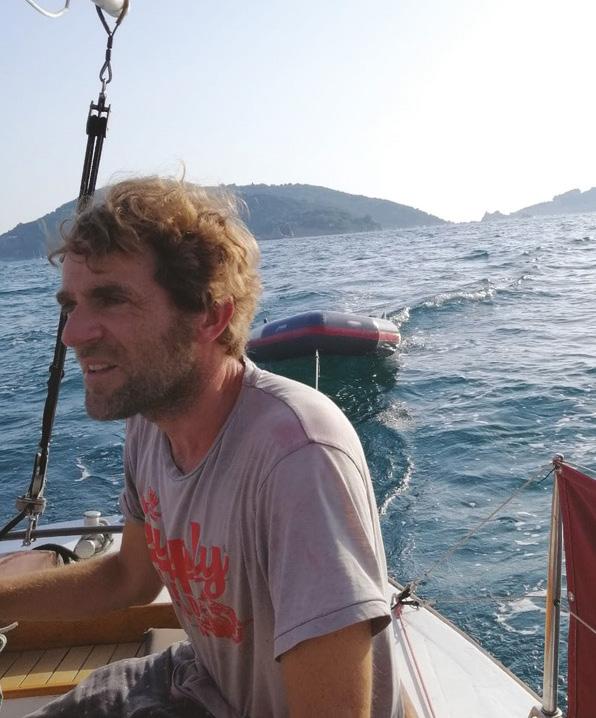
the day went on and was probably a consistent Force 4, which helped speed me along. at was until the mainsail outhaul snapped on my boom. is allowed the loose footed main to break free from the boom completely and, this in turn, fell into the water and was nearly lost. During all this drama one of my oars, which were stored on the coachroof, fell in and was lost. Much cursing later, I had the boat back in one piece. It was, of course, an easy x but everything is made complicated at sea when you are rolling about with the wind playing merry hell with the sails, and It was a ne example of how one small problem can usher in a whole world of trouble.
Capraia appeared on the beam by late a ernoon, a small island some 15sqmiles in size, fringed by jagged cli s. e island was a penal colony until 1986 since when the island’s 400 or so inhabitants have made a living from anchovy shing, producing wine and welcoming yachtsmen such as myself. e island did not, however, seem particularly welcoming as I approached. Night had come in and the wind
 BELOW Porto Vecchio, Capraia features a small marina
BELOW Porto Vecchio, Capraia features a small marina
thoughtfully piped up a notch. I was sailing blind toward a bleak, rocky islet. e lights of the main port were visible so I headed in cautiously. My main problem was the blasted ga mainsail as I wanted at water to drop it. ankfully the port was in the lee so it was just a question of holding my nerve and sailing until the high cli s shut out the wind. It took a long time and I was well into the narrow bay, surrounded by twinkling anchor lights, before the wind cut out and I could breathe easy. I found a berth in the Porto Vecchio and tumbled into my own berth.
e magic of arriving late at night is the discovery the following morning of an unknown port, freshly minted. Capraia didn’t disappoint in the dawn light. A tranquil settlement set on both sides of a steep ravine with a great fort glowering down from a headland just to the south, and the remains of the penal colony in the hills above. I took a stroll around the town in the cool of the morning and found a town split in two, with the lower port catering for tourists and the upper, slightly more shabby with a nice church and a few further shops and bars. Out to sea, the anchorage was
extensive and well sheltered so I decided to move my boat out there and spend the day swimming and repairing the many faults that had manifested – though not before I had bought a new oar for my boat for a princely sum. In the evening I returned ashore and decided to go and explore the penal colony, a three mile hike up in the hills. It was a nice trek and I got to see a beautiful sunset, though it made me feel a bit lonely. Down in the town, I grabbed a beer and a resident told me that there was ‘nothing to do on Capraia and London was better’. is, I felt was an unusual comparison but I was so tired a er my walk I was disinclined to argue the point.
e following day I opted to head to Corsica, as Cap Corse was only 15nm distant and therefore it seemed rude not to go. e forecast was for zero wind but, halfway across, this piped up to 20kts, which seemed a long way from zero and, like Shelley before me, I was caught somewhat on the hop. At this point, my dinghy became detached due to a poorly tied knot and I had the pleasure of seeing it cartwheeling across the waves into oblivion. I realised I was going to be pretty well screwed at anchorages without a dinghy so I
(le ) Forte San Giorgio at the entrance to Capraia; (centre) the anchorage o Porto Vecchio, Capraia; (right) Buildings in Capraia town
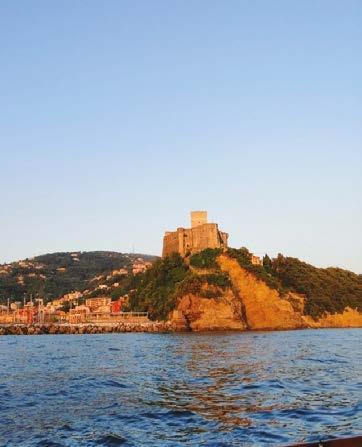
Anchored o Macinaggio, Cap Corse. Author's boat is furthest to the right
A serene anchorage o Elba

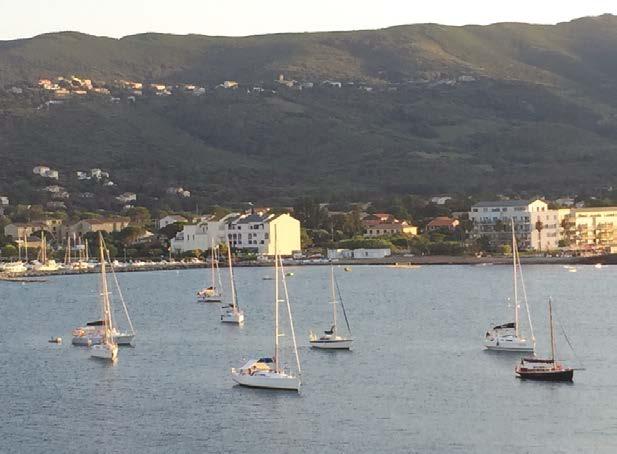

turned back and chased it down. is was as well, because when I nally arrived in Corsica, the marina at Macinaggio was very expensive and the anchorage was very free. It was also very hot, but the scenery was magni cent; verdant hills, clad with grape vines tumbling down to the sea’s edge. I headed ashore and spent a very sweaty day in the ‘o ce’ trying to put this magazine together.
Following this I returned to Capraia and work obligations meant I was obliged to leave the boat there for three weeks, paying the exorbitant sum of 600 Euros for the pleasure. Anyway, on my return I was joined by a friend and we spent a few days exploring Elba. is is a beautiful and rugged island that is perhaps best remembered as being the spot where Napoleon was placed in exile following his defeat at the hands of the British in 1814. Rather generously, he was granted sovereignty of the isle and spent a very enjoyable year introducing a number of social and economic reforms (doubtless involving a lot of paperwork) that were extremely successful and well received. He was reportedly also very happy during

this year and his enjoyable sojourn was ended when he returned to the mainland in 1815 to have a second crack at conquering Europe. is didn’t end well for him and it is a salutary lesson to all of us to understand our limits and, even if we are feeling restless, shy away from launching a land war in Europe. Just ask Vladimir Putin.
As an interesting aside, Shelley and his friends were notably pro the French Revolution and had to some extent misguidedly seen the fall of Napoleon as signalling the end of a dream in Europe of a more egalitarian existence. Despite coming from privileged stock, both Shelley and his friend Byron would fall very much into the hipster/ snow ake category in today’s terms. Indeed, it was Shelley’s disgust at the Massacre of Peterloo, when British cavalry charged at a group of 60,000 protestors, demonstrating for parliamentary reform, leaving 400 dead that prompted his famous poem e Mask of Anarchy, featuring the o repeated verse: Rise like Lions a er slumber
In unvanquishable number-Shake your chains to earth like dew Which in sleep had fallen on you-Ye are many -- they are few.’
is incitement to demonstrate would not go down any better with Suella Braverman than it did with politicians of the time, methinks. But times have changed and I doubt anyone would end up being massacred thankfully.
Returning to Elba – one of the notable things was that we were told not to drink tap water. Apparently it was ok for the locals but contained a bacteria that made visitors ill. We decided this was rank nonsense aimed at ripping o tourists, and drank a great deal of it. e result was that by the time we le my crew was quite unwell.
Anyway, we headed back to the mainland and sailed in a leisurely manner up the coast to Viareggio. Here I dropped o my vomiting crew and continued alone. e port has signi cance in my tale as it was on the long, pine fringed beaches nearby that Shelley’s body was washed up several days a er the accident. He was 29 years old. e decision was taken to burn his body there on the beach and there is a very famous painting of the rather ghoulish ceremony. Shelley’s body had been preserved in quick lime prior to the funeral and this meant his body burnt with a weird greenish
ABOVE LEFT A painting by Louis Edouard Fournier depicting Shelley's funeral on the beach near Viareggio
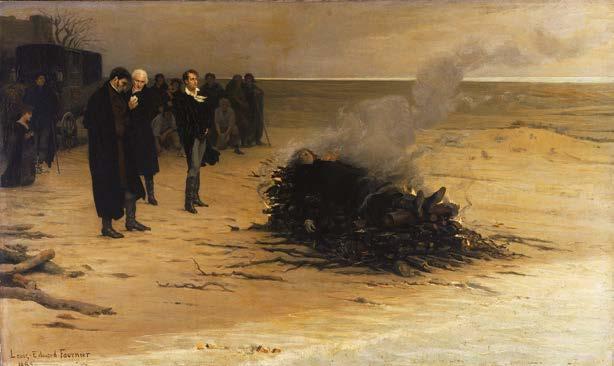
ABOVE RIGHT Sunset over the Bay of Poets, looking towards La Spezia

glow. Byron was so disgusted he wandered o and went for a swim.
Shelley’s heart refused to burn and was taken from the embers and kept by his wife, Mary.
I wandered along the beach, which it has to be said had a bleak moody feel, and pondered on life, death, creative genius and where I was going to nd my next pizza. It was time to head home and boat and skipper had a long road ahead. e following day I made the rst leg from Viareggio to San Terenzo. It was late summer and the weather was moody with great thunder clouds shrouding the mountains. As so o en happens on a solo sail, fatigue meant I started to hallucinate on the last leg of the journey. In the cool night air I sailed through a long, deep wooded channel that, with a jolt, I suddenly realised existed only in my head. All was dreamy and strange. Dropping the anchor in the Bay of Poets, the air was still, the sea like glass and the ghosts of the past felt close at hand. I was put in mind of the epitaph on Shelley’s grave in Rome:
Nothing of him that doth fade But doth su er a sea-change Into something rich and strange

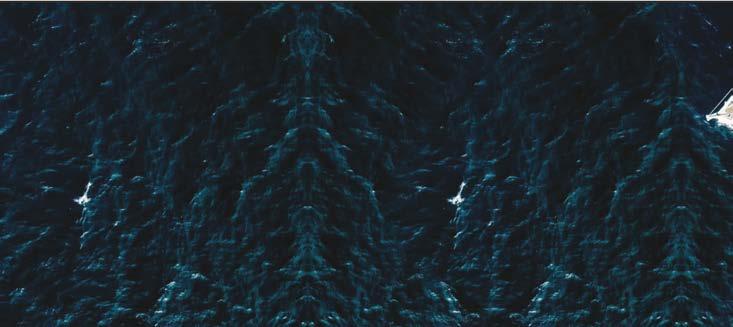
 PHOTOS: ISTOCK/SAM JEFFERSON/COMMONS
PHOTOS: ISTOCK/SAM JEFFERSON/COMMONS
The Sailors Blu ng Bible sits firmly in that niche of silly books for sailors and is absolutely tailor made for relatives of keen nautical types who don’t know what to buy them for Christmas. Author Tim Davidson, a veteran of the sailing scene, having raced and cruised successfully and also written many, many books on the subject, throws himself into the task at hand with gusto. Leaning heavily on his own experience, he outlines how to win friends and influence people at any sailor’s watering hole. The book is illustrated by well known nautical cartoonist John Quirk and the whole thing adds up to precisely the sort of stocking filler you’d expect to receive this Christmas.
fernhurstbooks.com £12.99

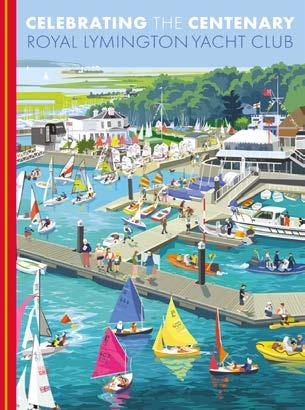

John Quirk makes a second appearance on the book reviews page, this time having ditched Tim Davison and decided to go it alone. The result is another book that sits firmly in the stocking filler bracket but with a strongly di erent theme this time. Quirk has drawn on his pove of history to recount a number of quirky nautical incidents through the ages. I was initially a bit disgusted that he seemed to have based the concept of an entire book around his own surname but I got over this and knuckled down to reading about events ranging from Henry V’s invasion of France in 1415, consisting mainly of chartered French ships and paid for partially by Dick Whittington, to episodes in the Second World War, like the Somali Camel Corps capturing a German U-boat. It’s all mildly diverting and helped by Quirk’s own illustrations which make for an easy read.
fernhurstbooks.com








The title of this book rather spells out that this is something of a niche publication. I think it’s fair to say that ideally you need to have at least some interest in this area if you are going to get thoroughly absorbed in the subject matter. The price is also pretty hefty for the casual reader. If, on the other hand, you do have some interest in Lymington Yacht Club or its environs then this is a fine celebration of a landmark, the club having risen from small beginnings after the First World War to become one of the UK’s leading sports clubs. Indeed, the club has nurtured a number of top racing talents thanks to its UK-wide recognised sailing programme for local youngsters, resulting in many of them winning Olympics medals. unicornpublishing.org £50
after the First World War to


Ah yes, the magic of Maurice Gri ths! A man who knew the east coast like the back of his hand and spent more nights hunkered down in some snug anchorage in the Wallet or elsewhere than I have had hot breakfasts. Before I get started, I’m going to let you into a secret; as someone who has never sailed the east coast, save to fleetingly pass by enroute to Scotland, I’ve always been slightly irritated by the dewy eyed reminisces of its muddy delights from modern day proponents such as Dick Durham and the like. Anyway, despite these misgivings, it’s impossible not to enjoy Maurice Gri ths meanderings on these waters narrated both in this tome and also Swatchways and Little Ships.
I can also identify readily with Gri ths as he was the editor for many years of Yachting Monthly and his life seemed to be a constant battle with time, tide and deadlines as he tried to fit in a full time job alongside his passion for sailing. The book is far more than just a soggy sentimental eulogy on the beauty of the mudflats, it’s a lively, vivacious look at the joy of sailing that also explores the fundamentals of yacht design as Gri ths skips from one boat to another in his quest for the perfect yacht. It makes for a thoroughly enjoyable read.
Eagle eyed readers may have noted that Stuart Fisher is an occasional contributor to Sailing Today with Yachts and Yachting, providing forensic guides to various undiscovered corners of the UK which he generally explores by canoe. His new book showcases 50 of the most popular, interesting and beautiful lochs around Scotland. Packed with maps and information on local facilities, this book is a really useful guide for boaters, walkers, and anyone wanting to know more about these iconic and breathtaking locations. Each chapter is beautifully illustrated and contains detailed information about the landscape, wildlife and history.

Bloomsbury.com £18.99



This new Royal Cruising Club Pilotage Foundation title is the successor to Brian Navin’s cruising guide to the area, covering the exposed North Sea coasts and the more protected Baltic Sea coasts of both Germany and Denmark. Coverage has been updated and expanded from specific routes to a comprehensive sequence of ports and anchorages along each area of coast, with introductory information about places of interest to visit ashore.
Author Nicholas Hill cruised the region extensively for many years and has enriched the text with new photographs throughout. Plans include up to date hydrographic data for both German and Danish waters.
This cruising guide is an ideal companion for those who plan to explore the more challenging, shifting coastline of the North Sea and the comparatively gentle and intricate indentations and archipelagos in the entrance to the Baltic. It is also a useful resource for anyone on a more direct passage through to the Baltic Sea proper.
Imray.com £37.50
More Lives than a Ship’s Cat recounts the adventures and close calls of G A (Mick) Stoke, a Midshipman who served in. the Royal Navy during WWII. Having trained in 1940, he was invalided out in 1947 and between times survived several torpedo attacks and sinkings in numerous vessels including HMS Glasgow and Queen Elizabeth. Lowlights include surviving the sinking of the HMS Hardy while escorting a convoy to Murmansk in Russia.

The book is written by his son, Jeremy Stoke, who, understandably, had excellent access to first hand documents and sources. As such, the narrative is both authoritative and warm in its narration, leaning heavily into letters written by Stoke senior. All of this makes it a valuable historical document in its own right, not to mention a ripping yarn.
penandswordbooks.com £25










Ian Nicholson has been involved in yacht design since he started an apprenticeship at Alfred Mylne’s yard back in the 1940s. as such, he is in a good position to write a guide explaining the principles of design to the layman. He does this in a straightforward and understandable manner, allowing the reader to be aware of the elements and processes involved while ensuring that most of the complex maths has been replaced with simple rules of thumb.
Thev book is therefore aimed at the enthusiastic boat owner who wants to understand a bit more about their boat and the principles behind its design. It will also be useful for those looking to buy a boat, as it will give them a better grasp of how di erent hull forms perform in di erent weather and which one is best suited to their needs.
fernhurstboooks.com £15.99



marina has three harbours –

(East

On a dark stormy night in the Channel, in headwinds and a building sea, there are few places that o er such a welcome retreat as Royal Harbour marina at Ramsgate. is Four Gold Anchor Award complex, located just to north of Dover at the mouth of the English Channel, Ramsgate is not only the ideal base in which to take shelter from poor conditions around the south-east tip of the UK but also, it’s on the ‘doorstep’ to the continent and a popular haven for visiting European cruisers and racing vessels.
e harbour was built in 1749 and served as an important site for eets of sailing ships including King George IV’s Royal Squadron, which set sail to Hanover from Ramsgate Harbour in 1820. His Majesty the King was so taken with the Ramsgate and its harbour that he decreed Ramsgate should be a Royal harbour. To this day, it is the only harbour in the UK that bears the Royal title. e town was also much frequented and admired by Queen Victoria, the history of which is evident in the Victorian architecture detail that dominates the waterfront. Royal Temple Yacht Club that overlooks the harbour is a ne example.
A total of 650 nger moorings all serviced by rst-class amenities and 24-hour security – manning and CCTV – makes Royal Harbour marina one of the most desirable places to berth a yacht or pay a visit to. ere are 150 dedicated visitor berths located in the East and West
Outer Marinas, all of which o er 24hour access, and use of the hospitable Royal Temple Yacht Club for the bar, restaurant and accommodation, with its eight serviced bedroom. For visitors planning a trip to Ramsgate therefore, a good time to go is for Euromarine Ramsgate Week, which next year (2023), runs from 7-11 August, just a er Cowes Week.
Priding itself with its highly rated customer service, ample space, and top class facilities, it’s not surprising Ramsgate Royal Harbour is a popular location for boating rallies, with eets of vessels from the ames, Crouch and Blackwater, as well as France, Belgium and e Netherlands, making Ramsgate an annual pilgrimage.
As well as the Royal Temple Yacht Club other facilities at the Harbour include fuel barge (for all grades of petrol and diesel) open 365 days a year, fresh water, electricity, 40 tonne boat hoist, storage, equipment hire such as a cherry picker or forkli , hire of tug master, chandlery, sail lo , slipway, boat park, and boat
sales. e harbour at Ramsgate is also home to one of the oldest RNLI lifeboat stations in the British Isles. During its lifesaving history, the crews have been presented with over 50 awards for gallantry.


ose wishing to give thanks don’t need to travel far either because the Sailors’ Church and Harbour Mission, which dates from the 1750s is located at the western most point in the inner harbour. Today services are held at 1700 on Sundays from June to end of September.
Whichever direction you approach the harbour from, you must at some point join the dredged entry channel, which runs east-west and is used by cross-Channel ferries, fast pilot boats, and other commercial cra . Visitors should use the Recommended Yacht Track that lies parallel to the south side of the channel.
As with most marinas, it is advisable to communicate with the marina or local harbour
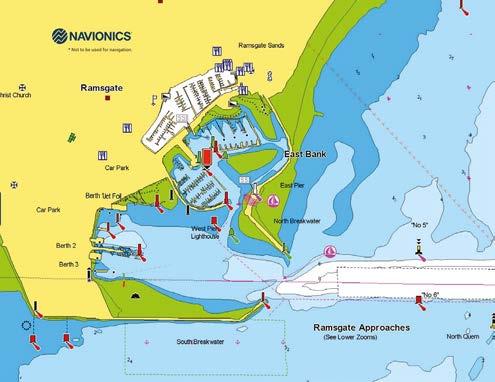
authority before arriving or leaving. On arrival, call up Ramsgate Port Control (Ch14) and await instructions on whether to proceed straight into the harbour, or head to the small cra holding area south of the outer breakwater.
On the approach it’s worth remembering the north section of the Goodwin Sands lies only four miles from the harbour entrance and any passage past this area, heading east or west, must be undertaken with extreme caution, particularly on the ood tide, which sweeps southwesterly onto the sands. Shallows lie south of the harbour entrance, the Quern Bank being closest, and the Cross Ledge further south. To the north, the shallows shelve gently with no uncharted hazards, but stand well o the North Foreland in strong eastly winds, because confused seas build up inshore.
Ramsgate’s outer breakwaters are low lying, built of rocks and can be di cult to spot from the east. e north pier head has a green beacon (Q.G 5M); the south has a red
ABOVENo shortage of places to dine with restaurants positioned all round the marina
beacon (VQ.R 5M). e tide sweeps across the entrance, roughly northeast/south-west, at up to 2kts.
Once inside the breakwater swing round to starboard, to a seasonal red buoy (F1.R.2s). Don’t be tempted to cut the corner on an ebbing tide as there is o en little water in that area.
When you are given the go ahead to enter, you will see tra c lights on the East Pier to lead your through into Royal Marina. From here on in, switch over to VHF Ch 80 for the Harbour
O ce for berthing instructions. You’ll nd that length of stay will determine where you’ll be berthed (see information panel right).
Given its location at the southeastern tip of the UK, there is plenty of scope for cruising locally to places like Sandwich, and Dover to the south, or further a eld to the north such as the River ames and Medway, and other popular east coast destinations up the River Crouch, and Blackwater. Its ‘jewel in the crown’ however, is its proximity to the continent, which means it’s possible to head to place like France, Belgium or even e Netherlands for a long weekend. ere are plenty of interesting places to visit, far too many to mention, but if you end up in Ostend harbour don’t miss a hearty meal at Taverne De Koekoek, which has just one thing on the menu –whole/half chicken straight from the spit, with bread and butter or French fries. No knives and forks, but that’s all part of the fun of it!
Harbour o ce: VHF Ch 80
Call sign: Ramsgate Marina

Ramsgate Port Control: Ch 14 Contact: +44 (0) 1843 572100
Harbourmaster email: harbouradmin@thanet.gov.uk
Dockmaster email: dockmaster@ thanet.gov.uk Postcode: CT11 9LQ
Berthing is divided into three main sections – Outer West Marina, Outer East Marina, and Inner Basin (East and West) – plus the outer harbour for manoeuvring and dropping sails on the final approach. Short stay visitors are generally berthed in the Outer West Marina accessible at all states of the tide. For longer stays however, it is sometimes possible to obtain a berth in the Inner Basin, when arranged via the Duty Dockmasters. This is accessible via a ‘flap bridge’ and lifting bridge, and open two hours either side of high water. The marina o ce is on the port-hand side at the Inner Harbour gate/bridge, and berthing facilities such as showers and WCs are in all three marinas. There are two launderettes (East and West Crosswall), and the fuel barge is positioned on the port-hand side on the approach to the Inner Harbour gate/bridge
Prices – Minimum charge length – 6m: Summer (April to September) Daily: £3.33 per metre (includes electricity – one lead only) Winter (October to March) Daily: £2.74 per metre (includes electricity – one lead only)
Annual: Per metre from £310.08
Local services and attractions
Royal Temple YC. Contact: +44 (0)1843 591766
Restaurants, pubs and bars: For every taste and budget, and the Belgian’s passion for a plethora of super beers

Chandlers: Marlec Marine. Contact: +44 (0)1843 852452
Maritime Museum. Contact: +44(0)1843 570622

Euromarine Ramsgate Week (7-11 August, 2023)
Euro Regatta – Ascension Day race from Ostend to Ramsgate (18 May, 2023)
EAORA Round the Goodwins Race (date TBC)
Royal Temple Yacht Club o ers a warm welcome to visitorsoat show season means that manufacturers are busy launching the new gear they’ve been busy developing and testing on the water this season. With Cannes and then Southampton in quick succession, then the blockbusting Marine Equipment Trade Show set for November in Amsterdam, there’s plenty of new stu just in. We walked the pontoons, aisles and marquees to pick out the best Heatrub ultimate baselayer £55

Japanese performance clothing brand Zero t has launched its products into the sailing world, with a range of insulating base layers that are ideal for winter sailors. Zero t claims its baselayer is ve times warmer than a standard garment, and has tested it with scientists in Osaka by way of proof. Where a normal garment might retain 10-14 per cent of your body heat, the Heatrub gear achieves a rate of 78 per cent. It is built from ve di erent yarns, mainly acrylic, nylon and wool, combined in a so , loose- tting fabric that nevertheless
stretches easily. e key to the garment’s extraordinary warmth is its double loop fabric which both insulates and very gently brushes the skin to generate warmth. It doesn’t rely on compression, which makes for greater freedom of movement. O ers optimum comfort between -10 and +10 degrees C. Available in a range of primary colours, plus black, white and grey, in sizes from small to XXXL. Zero t also o ers matching leggings at £55. zero t.co.uk

Antenna-maker Shakespeare has developed a low-pro le VHF antenna that draws on lessons learned in automotive design. e 5912-Dorsal does away with the familiar springy wire aerial and replaces it with a sleek dorsal n, which entirely conceals the receiver. is approach has the advantage of protecting the antenna better, while the low pro le cuts the likelihood of snagging. Obviously well adapted for the motorboat market, this unit could also prove attractive for those with coastal sailing boats up to 15m. Range is naturally less
impressive than a masthead unit, but at 25W of power, it achieved a 10-mile range, with four miles at standard power of 1W. Measures 100 x 60 x 65mm and mounts using a single M14 bolt, hollow drilled to run the cable. Available in black or white, and also as an AM/FM aerial. smgeurope.com
Daniamant W4/M4 alkaline lifejacket light £19.32
Recognising that lithium is expensive, destructive to extract and harder to transport, Denmark’s Daniamant has developed a lifejacket light that relies on simple alkaline batteries. It still meets all the requirements of Solas regulations, and burns for 60 hours at the required 0.75 candela once triggered. at is a third less burn time than the lithium equivalent but frankly, if you’re still in the water a er 60 hours then you have bigger problems. You must replace the unit every ve years – you can’t replace the batteries yourself. But that, combined with its miniature 3 x 6cm size and 42g weight make it easy to t and forget. It is also more than £10 cheaper than the lithium alternative. oceansafety.com
Boat show season is a time for new launches – not just of boats but also kit. Sam Fortescue takes a look at the latest new gear on show
Known in their native Australia for decades, Sarca anchors are now available direct from a UK stockist for the rst time, courtesy of Jimmy Green. ere are several models of Sarca manufactured by Anchor Right in Oz, and the original idea was they would provide superior holding in sand and reef conditions. e latest iteration is called the Excel, and it is broadly a new generation anchor without the cumbersome roll bar, which gets in the way on some pulpit designs. As ever with anchors, the list of claims and counterclaims is lengthy, but the bottom line is that it is independently certi ed as super high holding power, with convex ukes that don’t come up full of mud. e anchor rights itself and also performs well in weed. Jimmy Green has sizes from 7.5kg to 50kg in stock, with up to 160kg available on request. e 16kg number 4 holds boats up to 7t and costs £560, while the 22kg anchor costs £670. Designed with a stainless-steel cutting toe that can be sharpened, and a hot-dip galvanised nish. jimmygreen.com

Designed with high latitudes in mind, Helly Hansen’s Arctic Parka amounts to more than just a name. It has been re ned and tested with input from polar explorer Mats Grimsaeth with a host of technical features. ese include Helly’s proprietary Performance membrane, with waterproo ng up to 20,000mm and high breathability that allows up to 20,000g of water vapour per sqm per day to escape. Strategically shaped and positioned insulation panels on the inside combine with zip openings at the top of the garment to harness the chimney e ect, where hot, damp air rises and is ventilated.
e parka also features Primalo insulation and a so-called heat skirt, which ts snugly around the waist to seal warm air inside. Graphene has been woven into the fabric in key areas to conduct heat – the material also helps to neutralise
odour and static. Otherwise, there is a retractable hood, a waterproof zip-up pocket, further hand and cargo pockets, double cu s and a high collar to keep your face warm. What is more, Helly sources at least half of the jacket by weight from recycled sources, including ghost shing gear recovered from the sea by Ocean Bound. e lo ing is 80 per cent recycled, and the whole garment is nished with a plant-based durable waterproo ng treatment.
hellyhansen.com
If you’re planning a winter sun sailing trip, the latest long-sleeved top from Aussie apparel brand Zhik will be of interest. So and cool, it wicks moisture and yet manages to provide the top level of UV protection, with SPF50+. Designed to be worn next to the skin, the Eco Spandex top stretches in all directions to accommodate motion. Flatlock stitching and strategically located seams will stop the garment from itching and rubbing, so it makes an ideal rash vest or swimming top. Better still, the entire Eco Spandex range is largely made from recycled Repreve nylon, reclaimed from post-consumer packaging. A limited-edition pink version of the top, designed for women, is also available with part of the price supporting Breast Cancer Awareness. zhik.com

B&G has launched a new blackbox processing unit which can

do the thinking for its Triton and Nemesis displays, or boost the power of its Zeus and Vulcan chartplotters. Triton Edge will provide better data across the board, with more accurate start line calculations, wind correction for heel and trim; and more accurate calibration of boat speed and true wind data. What’s more, having obtained this data and fed it into the NMEA2000 network for display around the boat, it can also share it over wi . at means that anyone with a smart device, from a watch to a laptop, can bene t. It also integrates seamlessly with the B&G Companion App, which allows you to upload the data to the cloud for analysis or sharing with friends. It runs on 12V and 24V systems, and is pitched at sailors engaged in high-end cruising or cruiser-racing. bandg.com
Starting from a blank sheet of paper, French outboard maker Temo developed a radical new look for its debut 450W electric motor. Resembling an oar with a propeller on the end, the battery, motor and electronics were all cleverly tted inside a lightweight aluminium tube that was very easy to carry.
To make the step up to a more powerful 1000W electric outboard, this simple, practical design has had to change, but the result is still e cient, smart and exceedingly portable. It weighs in at 15kg, including the removable 5kg battery pack, which slides out in seconds for easier carrying, or in order to drop in a freshly charged one.

Performance is decent, with a static thrust of 28kg - equivalent to a 3hp petrol motor, according to Temo. at’s enough for a small 8m sailing boat and certainly for a heavily laden 6-person tender. As ever with electric propulsion, the torque is optimal over the whole range of running speeds, giving smoother handling.
A standard transom mount is included, which enables you to t the motor inboard, then swivel it round
ABOVE LEFT Helly Hansen's Arctic Parka ABOVE RIGHT Zhik's Eco xpandex topinto the water, with a quick release to remove. e tiller stows in the main motor housing and a twist controls speed and forward/reverse. You get at least 60 minutes of runtime per charge, which takes ve and a half hours on mains power, or 12 hours at 12V. e 740Wh battery capacity should be enough to get you over 10 miles at low running speed. marinecomponents.co.uk
c£1,232 (€1,379)
Monitor your boat when you’re shorebound and get intelligent alerts and analysis regarding the boat’s performance when under way, with the suite of products from Belgian start-up Sailsense. e product is a mixture of hardware and arti cial intelligence – a meticulously honed algorithm that can predict behaviour and anticipate problems. e heart of the system is the Hub, which collects data from around the boat and communicates it to the dedicated app via the web. e Hub connects to the NMEA 2000 instrument network, monitors one or two battery banks and up to three analogue wired sensors – from a tank sender to a bilge pump. Expand the system with Pods (€659), each able to monitor a further three inputs and communicate the data wirelessly back to the Hub. Both are designed to work with Zigbee sensors, which run to temperature and pressure, intruder alarms, smoke and gas and many more. Lastly, the PowerRail (€2,520) adds a broad digital switching capability to the Hub, with 24 outputs up to 16A, including dimming, 8 digital or analogue sender inputs and battery voltage monitoring for up to three banks. Via the app or your networked chartplotter, you can then switch boat systems on and o at the stab of a touchscreen. sailsense.io
Wichard has been busy trying to bring the ease of electric furling to downwind cruising sails, and it has hit gold with the really well designed Facnor NXE 4500. e trick is to make it as light and as compact as possible, so that cruising sailors aren’t dissuaded from lugging it onto the foredeck and rigging it to the gennaker. Facnor’s approach was to use two small 200W motors instead of one big one, keeping weight to just 4kg with a comparable size to a manual endless-tape furler.
It is quick to attach, with a snap shackle for the tack point, and a quick release pin that locks into the eye in the sail’s anti-torsion cable. e system is compatible with better performing top-down furlers and structured lu sails, and also ts the vast majority of conventional gennakers up to a maximum 140 square metres.

It is reasonably e cient, drawing 20-25A at 12V, with a furl taking less than a minute. It requires a junction box and circuit breaker, just like an electric windlass, which is supplied in a watertight box for mounting below deck in the anchor locker. Simply plug in the motor unit using the waterproof plug provided.
e other big boon of this system is that it is supplied with a remote
 ABOVE L-R e Sailsense Hub; Facnor's NXE 4500; Spinnaker Hass watch BELOW e RebelCell Outdoorbox
ABOVE L-R e Sailsense Hub; Facnor's NXE 4500; Spinnaker Hass watch BELOW e RebelCell Outdoorbox
control that has a range of 10-12m, so you can y and furl the sail from the helm. Ideal for short-handed sailing, then. Designed for boats in the 38-52 range, and available via UK distributor Eurospars. eurospars.com
£375
Newly launched by Spinnaker watches as a tribute to the documentary lmmaker and biologist Hans Hass, this watch is built to resist depth up to 300m. Milled from marine grade 316L stainless steel, it features a scratchresistant, anti-re ective Sapphire lens and glow-in-the-dark hands. True to its diving roots, it has a dual register countdown and time elapsed bezel. e movement is Japanese and comes with a two-year guarantee. e stainless steel band is 22mm wide and the bezel is around 50mm in diameter. v/arious di erent colour combinations are available for the bezel and face, including some limited-edition versions with a simpler bezel and 350m water resistance, priced at £600. spinnaker-watches.co.uk

£630-£1,070
Lithium batteries made in the US by RebelCell are available in the UK for the rst time. Distributed over here by SMG, the batteries o er deep cycling, quick charging and longer life spans than cheaper lead-acid batteries. And because the batteries can be fully discharged without damage, a 50Ah unit does the job of a 100Ah lead-acid equivalent.
Particularly interesting is the Outdoorbox line of batteries which come in a rugged, waterproof case that makes them ideal for powering electric outboards in the tender. A

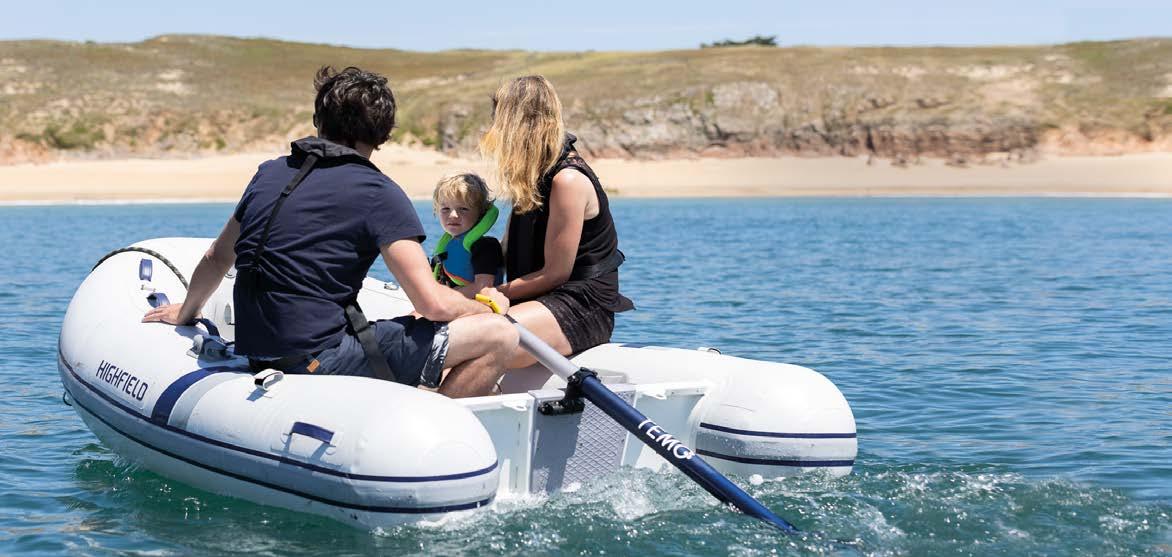






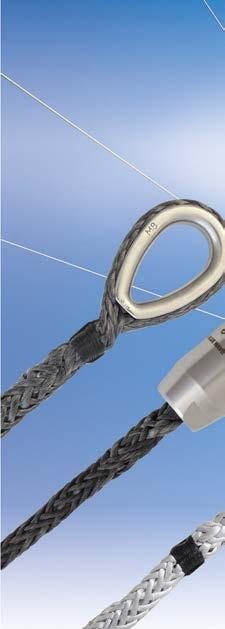
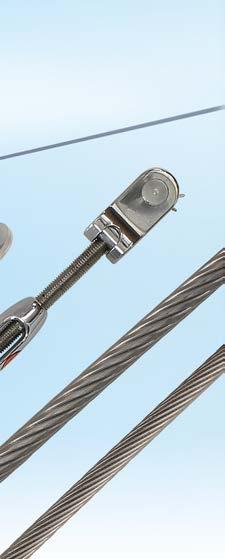
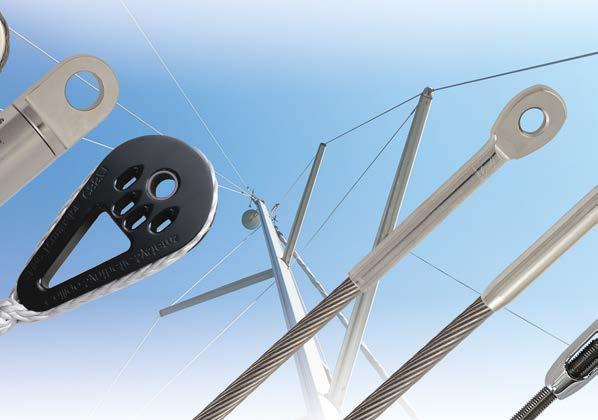
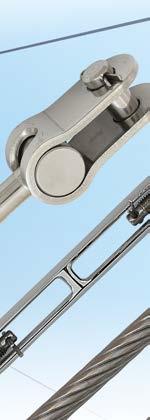






















































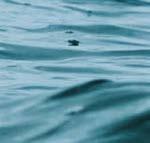




















built-in display shows voltage and state of charge, while a waterproof ANEN connector provides the power. ere’s also a 12V cigarettestyle lighter socket with a twin USB adapter included. All rated at 12V, the range runs from 3570 Ah capacities. e 35Ah unit costs £630 and weighs just 3.7kg. rebel-cell.co.uk

Although the InReach mini 2 has been available previously via Garmin’s website, it is the rst time the brand has o ered a marinespeci c bundle, with a 12V charger, marine mount and oatation lanyard. e device is an incredibly compact 100g, measuring 10 x 5cm, making it easy to wear in a sailing jacket. It is designed to keep you in touch with loved ones via location tracking and two-way messaging that works anywhere on the world’s oceans, using the Iridium satellite network. Use it as a standalone safety tool, or pair it with Garmin chartplotters or the Quatix 7 watch to send messages or set an SOS alert. When paired with a smartphone running the Garmin Explore Mobile app, you can share tracks, download maps, check weather and send messages.
Position tracking is via regular updates at 10- to 30-minute intervals, and the frequency has a big impact on battery life. If it res o coordinates every 10 minutes, the battery lasts for 14 days, but at 30 minutes you get more than twice that. e InReach mini also stores up your position reports, allowing you to track back through them if you get lost – handy if you’re exploring wild terrain ashore (or returning late from the pub). And you can pay $1 a go to receive marine weather data tailored to your position.
Subscription costs are additional, and run from $11.95 to $49.95 per month for an annual plan. garmin.com
Growing Chinese electric propulsion specialist ePropulsion has launched a new 10kW saildrove pod at the Southampton Boat
Show. Better known for its small electric outboards, the company is expanding rapidly into the inboard market, targeting OEM sales. Its claims for the new motor are impressive, likening its 10kW output to the performance of a 30hp (22kW) diesel. is would make it suitable for propelling boats up to around 10t displacement or 35 in length, using its 13” x 11.3” threeblade aluminium prop. ere is some debate about exactly how to compare the output of electric vs diesel, although everyone concedes that electric motors have much better torque across most of their speed range, and lose far less power as noise and heat. Most electric motor makers say their products are equivalent to a diesel engine rated at 2-3 times the wattage.
Either way, ePropulsion’s new pod weighs just 39kg and comes with excellent connectivity. It is tted alongside a remote 4.3in touchscreen display that provides range and power information, and networks into an NMEA2000 system. e company also manufactures a remote monitoring system which allows this data to be easily shared beyond the boat. Lithium battery banks will be custom designed according to the boatbuilder’s spec. epropulsion.com
Calypso wind instrument £424.95
Calypso is no newcomer to the marine scene, with a well-developed suite of wireless anemometers. But they are new to the UK, having struck a distribution deal with Force 4. With neither power nor signal wires to run through the mast, the kit is beautifully simple

InReach mini 2
ABOVE RIGHT
ePropulsion 10kw Pod
BELOW e GN Espace Levante 2
to install. It relies on its own tiny solar panel (on the cover) and a built-in rechargeable battery with the capacity for up to 60 days runtime. Four ultrasonic sensors measure the wind to an accuracy of 1 per cent at 20 knots. Direction is even more accurate. Measurements are taken once a second, which makes the unit less sensitive than the latest high-end o ering from B&G. But it should be more than enough for most cruising and racing sailors.
You can receive data direct from the sensor on your phone using the free Calypso app and a Bluetooth connection. Or install a dedicated NMEA gateway unit (£169.95) below to feed the wind data into your instrument network. marinecomponents.co.uk
If you went aboard the Cornish Crabber on display at the recent Southampton Boat Show, you might have spotted the latest electric oven on o er from GN Espace. e Levante 2E combines a twin induction hob with an electric grill and fan assisted oven – all within the standard 45cm width of a marine cooker.
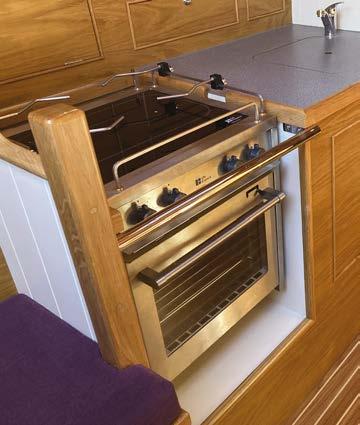
Nominal power consumption is pretty meaty – 1.85kW for each hob, 1.8kW grill and 1.8kW for the oven. So it is a considerable piece of equipment. ere are anti-tip shelves that don’t deposit your food on the oor when you open the cooker door. e grill has a standard and a hot-air mode, and the oven can defrost food as well.
It may be e cient, allowing you to operate the boat without explosive gas aboard, but it does require a fair amount of juice to run. It can boil a litre of water in under three minutes and roast a chicken an hour and a quarter, this latter feat requiring just over 1 kWh of energy, or roughly 85Ah on a 12V system. is would make it suitable for a boat with a big battery bank or for a lithium retro t project. Gn-espace.com
Nick and Jenny Coghlan narrate a voyage to Ascension and Fernando de Noronha, a pair of o en overlooked islands in the South Atlantic
 Ascension and Fernando de Noronha
Ascension and Fernando de Noronha
efore HMS Beagle le St Helena for Ascension Island in 1836, near the end of her ve-year circumnavigation of the world, the locals warned Charles Darwin:
“We know we live on a rock, but the poor people of Ascension live on a cinder.”
And while similarly remote Juan Fernández in the Paci c inspired a classic of world literature – e Life and Strange Surprizing Adventures of Robinson Crusoe – Ascension’s contribution is Sodomy Punish’d, derived from the diary of a Dutch sailor who was cast ashore here for the said crime in 1725.
So, when we were on our rst crossing of the South Atlantic in the late 80s, it was with low expectations that, a er a warm trade-wind sail of a week in the Beagle’s track, we dropped anchor in the uncomfortably open roadstead that is Clarence Bay. We introduced ourselves by VHF to the Port Captain. He spoke with

a noticeable American accent; the conversation was terse, but we had our lines rehearsed:
“What is the nature of your distress, captain?”
“Good morning to you as well. We have an issue with our rawwater pump sir, which I need to work on, and we’d like to take on some fresh water if we may. I believe we are entitled to a 72hour stay, is that correct?”
ere was a long pause. en reluctant acquiescence and noti cation that our clock was now running; we were asked to note the exact time in our log.
Ascension has no indigenous inhabitants. Instead, it has NASA, the European Space Agency, a BBC World Service relay station, a set of hush-hush listening antennae jointly run (or so it is said) by unnamed British and American intelligence out ts, sundry military, and a surprisingly long airstrip and related infrastructure, called Wideawake Field (named a er an endemic tern). Casual visitors are neither expected nor very welcome.
O Pico, Fernando de Noronha
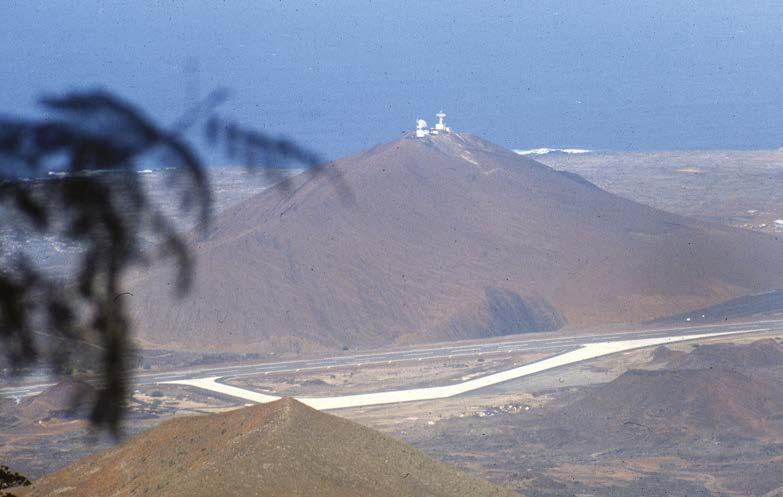
Evening in the South Atlantic, approaching Ascension,

Landing the dinghy at the pier head, Ascension
BELOW LEFT Wideawake Field, from Green Mountain
BELOW RIGHT Communications dome, Ascension

e same American o cer who had spoken to us on the radio observed us impassively as we struggled to manhandle our rubber dinghy up a steep ight of 20 steps cut into the pier head – the swell was such that there was no question of leaving it tied up. But he did thaw a little to tell us, a er extracting fees for landing and for medical insurance, that the US-run canteen at e Base was currently open. We had better take advantage of it now, as we were required to be back on board every evening by dusk.
A cheeseburger and a Bud, in a ercely air-conditioned, gloomy and smoke- lled bar, where American football was showing on TV, made for an odd welcome to this British outpost. Outside, at sea level, the island was as advertised: a huge pile of red and black ash and cinders where the equatorial heat made the landscape shimmer and, as far as we could see, drove everyone indoors. e large golf-ball domes of clandestine purpose and the
prefabricated nature of most of the buildings contributed to the feeling that we were on Mars.
But over at the little white church, you could have been at any of the old staging posts of the British Empire. ere was, for example, a marble memorial to Oliver T. Lang Esq, RN who, while in command of HMS Lee in 1865 ‘was killed by a fall from the bridge while coming to an anchor o this island.’ A stained-glass window reminded us of a more recent imperial episode: the Falklands con ict of 1982.
Ascension was a vital staging post for the eet steaming into the South Atlantic, and it was from Wideawake that Operation Black Buck was launched – a Vulcan bombing raid on Stanley that, at 6,600 miles return, was at the time the most ambitious such attack ever launched.
In front of a stately cream building that once served as the Marine barracks, was a cricket square, possibly the only ash pitch in the world. We wondered if the evidently large American contingent had ever been persuaded to put an Eleven together.


Our water pump could wait; we had not lied to the Port Captain, but it had been dripping for two years
now. So for our second day ashore we trudged inland in stultifying heat to Two Boats. On either side of the road into this tiny settlement stood a wooden whaleboat on its transom. ey were placed here by Marines in the 19th century, to provide shade for travellers. Passing more whitepainted prefabs, (still nobody to be seen) the road wound its way high into the cloud that sits permanently on Green Mountain. e landscape changed, and the temperature dropped quickly. We noticed green hillsides, clad oddly in cracking concrete slabs. It was a long-disused water catchment system. A wellengineered path – Elliot’s Pass – circled the top of the mountain neatly, with tunnels and cuttings. e path was built in the 1840s to allow sentries to scan the surrounding ocean for approaching ships.
ere was a farm up there, where the pigs greeted us enthusiastically and we contemplated the lettuces lustfully. But there was nothing for sale to visitors. We were even more disappointed when the old building known as the Red Lion turned out not be a pub serving a hoped-for pint of English bitter, but another Victorian-era Marine barracks. At the very peak of Green Mountain,
Jenny practices her batting stance on the cricket square, Ascension
At the farm, Green Mountain, Ascension; the lettuces are tempting

Raising our homemade Q and Brazilian courtesy ags, approaching Fernando
where you might expect to nd a crater, was a bamboo thicket and a dew pond some 5m in diameter. To commemorate our ascent, we le our names in the log-book provided.
When it came time to leave, and a er stocking up on Marmite, Sugar Pu s and tinned sponge pudding at the NAAFI (British military) store, the Port Captain came to see us o again. Or, at least, he stood at the pier head again, ostentatiously looking at his watch every few minutes as we struggled to launch the dinghy. When I looked back an hour later through the binoculars, the anchor up and our sails set for running, he was still there, watching.
Fernando de Noronha is another 1,100 miles to the west and, at four degrees south, closer still to the equator.
Jenny spent much of her time on this downwind passage rummaging through the bag of coloured spinnaker scraps that we had begged from a sailmaker in South Africa, so as to make a Brazilian courtesy ag. e ag in question has a blue disk with 27 stars on a yellow diamond, with an encircling band reading 'Ordem e Progresso' (Order and Progress). While we are punctilious in hoisting such ags (along with the
 Ascension and Fernando de Noronha
Ascension and Fernando de Noronha
yellow for Q) in advance of arriving in a new country, obtaining them in advance can be challenging.
Fernando is distinguished by a massive thumb-shaped mountain, on top of which sits a rotating aerobeacon; this is so high and powerful that we could see it from 30 miles away. Our arrival in the Baía de Santo Antônio, at the east end of the main island, was a relaxed a air in contrast to Ascension. e police came out to visit us in their launch, bade us a warm welcome and warned that the immigration o cer was currently taking his siesta. is should not stop us going ashore, they said. ey rattled o a list of suggested things for us to do, of which (speaking Spanish but no Portuguese) we understood a fraction.
One recommendation – this had been rubbed in with much gesticulation and many thumbs up – was to climb O Pico, which sounded straightforward enough. We understood there was a ladder all the way up. It began at the foot of a limestone cli , past a sign that said 'Military Zone – No Access'.

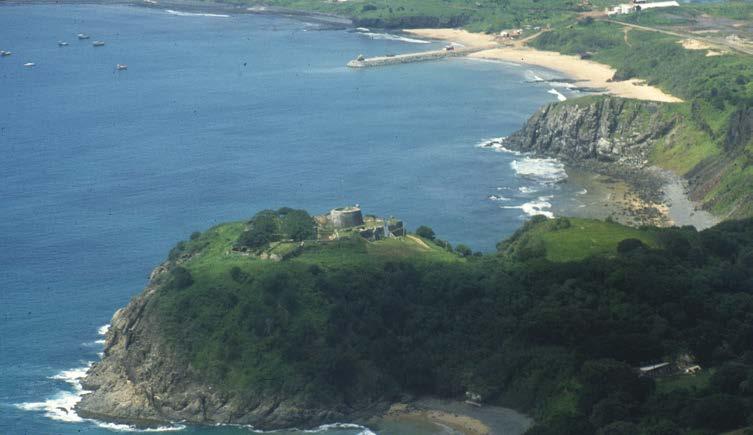
A total of 13 steel ights bolted to the largely vertical face, with
ABOVE LEFT Climbing O Pico
ABOVE RIGHT Views of Fernando from O Pico, looking east
BELOW LEFT Jenny and the aero-beacon, on the summit of O Pico

BELOW RIGHT e anchorage at Fernando, seen from the summit of O Pico

occasional rungs missing, then took us up no less than 1,056 (according to our chart). About half-way up the ladder, the crew – a few rungs below the captain – was heard uttering mutinous remarks but was persuaded that it was easier to keep going up (we were younger then, and more rash). ere were, of course, stupendous views as we sat huddled atop the pinnacle against the searchlight of the aero-beacon, which happily did not rotate in the daytime. Tropicbirds and noddies uttered all around us, apparently amazed to see anyone here, while large iguanas eyed us more stolidly. e descent, as we had supposed, was indeed worse than the climb up.
Fernando was a little tropical paradise. ere were deserted sand beaches – one reached via a less challenging ladder climb down through a pothole – where dolphins came to swim with us, and a small village where you could buy exotic fruits for next to nothing. We made a friend called Ziza who daily ransacked his garden for us, plying us with armfuls of starfruit, spring onions, peppers and, most wonderful of all, maracujá (passionfruit).
We were sad to leave, a er a week. Checking in at the posh Iate Club de Fortaleza a er a four-day sail to the mainland of Brazil was salutary. e tie-wearing duty o cer at reception was friendly enough. But a er handing us a form that told us we may not use the ‘swimming poll’ he pointed out a section that read ‘several times thives have stolen all he can’. We were assigned a security guard: “ is is Heitor. He will remain on your vessel when you are on shore. And we recommend that he stay on board at night as well. Of course, you will need to feed him. But…” (this said in English and in a low voice) “you should not supply him with any alcohol.”
Heitor saluted us sharply and seriously with one hand, a shotgun in the other. We tried to look as though this was a normal practise and smiled in welcome to our new friend. He mumbled something interrogative under his breath to the sailing club o cial, who turned back to us in order to add:
“Ah yes. Heitor would just like to remind you that if he needs to use any ammunition, that will be on your account.” ankfully, none was used.


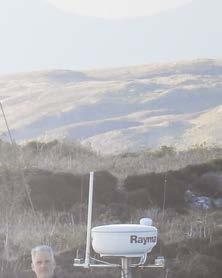












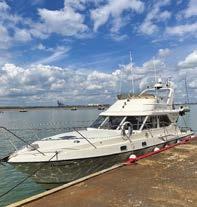
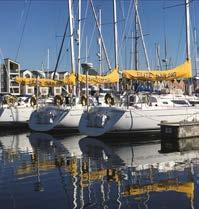





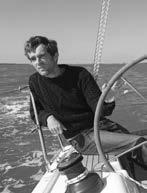
- Drama at the Etchells Worlds


Olympic gold medalist Eilidh McIntyre explains how to pull o a textbook rounding

Coming into the windward mark can be a hugely busy time and can sometimes feel like utter carnage. It depends what leg you’re going onto, but always plan ahead early. Look for the next mark: if it’s a reach, is it low or is it high? Are we tight behind? will we be planning? This will dictate your next decision. If it’s a run discuss the gain that beat, long tack, so what’s long gybe. What was the winning route up that beat? Is it tight behind and will you need to defend or can you sail your own race straight away? Is there pressure to considered?
There’s a lot going on. For me as a crew, quite often it’s about me having the presence of mind to think about all these questions and plan ahead for the next leg. But choosing when to voice the facts is tricky, and the earlier you do it the better. This allows the helm to nail the entry to the mark and form the decision for the next leg.
For Hannah (Mills) and I, our boat handling routines are fixed depending on wind strength and the type of manoeuvre. I think actually allows for more flexibility rather than less; if we
need to stop to defend we know exactly what to do when we return to the hoist. The order we do things is almost always the same, which allows us to be quick and e cient and cuts the thinking time; it’s just automatic.
Training for this starts with knowing the routines you’re going to do, and then knowing the routines for each type of manoeuvre. The hoist is more straightforward than the drops which has a few more variables, especially with a symmetric kite. Start by just going round one windward mark and practising hoists and a leeward mark practising drops, before you attempt to put it into action on a race course.
The best way to ensure a perfect hoist is routine. Analyse video if you’re not quite nailing it. A hoist can be a good opportunity to gain, but a good outcome is also to be in a position to nail your bigger picture plan. Sometimes, overall positioning is more important than how quickly the kite pops.Follow Eilidh McIntyre’s campaign for Paris 2024 via Twitter, Facebook and Instagram @mcintyreeilidh
I'm relieved that so far this expert's forum has not featured a single anchoring masterclass. I have read many, many column inches devoted to this 'dark art' and i have to say that I have always been left ba ed. As far as I'm concerned, the art of anchoring involves picking a spot with adequate space to sing about and dropping the anchor slowly while moving gently backwards, leting out roughly three times the length of chain compared to depth. There you go; an anchoring masterclass in one sentence. I realise this level of complacency means I am definitely riding for a fall in the shape of my boat turning up on a beach but there it is. I think this level of (possibly misplaced) confidence comes from the first boat I owned which I regularly left swinging to an anchor for weeks on end without batting an eyelid. I was pretty green back then and was definitely under the impression that sailing was an easy game. The anchor was a lightweight Fortress brand and was clearly a hugely e ective bit of kit which helped. This was underlined by the fact that, towards the end of my period of owning the boat, I was rummaging in one of the lockers and unearthed a much larger anchor. I had, in fact, spent a summer on the kedge. My boat survived to tell the tale.
Clean and green: not many of us enjoy daubing antifouling paint onto the underside of the hull of our boats. Not only is it a highly unpleasant task but it also bad for the environment. On p91 we interview Phil Horton, who works for the RYA's Green Blue environmental initiative, and he hints at new, cleaner products in the pipeline for sailors...

regatta day: we’ve been allowed out of the rib and back into a dinghy for the day. It’s light and patchy: we’ve been out-started by our old rival and are chasing them hard.
We’ve a good fleet of RS200’s in the medium handicap fleet at Mudhopper’s Sailing Club, but also some well sailed 2000’s, Finns, and plenty of other slower boats to worry about on handicap.

It is great at the front to have the 200’s pushing each other on but it’s a very reachy course with few clear passing opportunities. Though we feel faster than the leader, it is pretty obvious that they are going to defend any obvious attack.
So how do we give ourselves a chance to get past without us both losing time on the fleet? It’s the classic handicap dilemma.
At MSC, the strategic priorities are usually clear: keep to the shallow water when sailing against the tide, look for the strongest pressure when sailing with the tide, and tack or gybe on the shifts,
sailing the long leg, when the wind is o the land. The boat ahead knows this: simply splitting tacks upwind or downwind will most likely put us further behind, and if they shadow our choices, lose us both handicap time. So, we stay patient, and save the bold moves until a realistic opportunity arrives.
On the upwind legs that might mean a quick double tack into a clear lane on the long or lifted tack, while keeping alert for the next real passing opportunity: that may be a patch of pressure or shift that the leader has missed. Meanwhile we concentrate on the small gains, sailing high in the small headers, fast, free, and flat in the lifts and in the pressure patches, accumulating the small gains until there is a definite gain worth splitting for.
In high mode, the jib is sheeted hard for the conditions, and the mainsheet pulled to minimise twist and just stall the top tell-tale. The boat is dead upright. In fast forward mode, the jib is eased a fraction, the boom stays on the centreline but the main is twisted so that the tell tales are
flowing all the time. A little windward heel helps by reducing the weather helm.
On the downwind legs, we line up for the pressure patches, sliding the boat to leeward to stay with them for as long as possible, even gybing before reaching the edge of the pressure if necessary.
The trimmer communicates the “pressure” they feel in the sheet all the time: “good pressure” is the cue to roll the boat upright and soak a little more. If possible, we take any opportunity to work toward the “inside side” of the leader: that’s the side that could give us an overlap at the zone for the next mark.
On the run, if we can do this while shepherding the opposition to the “outside side” of the course, that overlap is even more likely when they turn toward the mark.
It’s a handicap race. There is no point making an attacking move if the most likely outcome is that the leader will defend and slow us both down. We must play the long game again, looking for the
small gains to narrow the gap while being alert to any big changes. Sailing high in the lulls keeps the boatspeed up and sets us up for the next pu . Sailing low, below the line to the mark in the pressure keeps us in them longer and gives the opportunity to sail high in the next lull. If the leader defends, they will be out of phase, and we’ll steadily wind them in.
Eventually there may be an opportunity: the leeward pass is preferred as there is no risk of a handicap loss through a defensive lu , and if we don’t break through, we’ll slot back in directly behind the leader ready to take the next opportunity.
We wait until the leader is in light pressure and lifted: they will be slow, sailing high to keep speed on, or both. If, at the same time, a promising looking gust comes our way, that is the cue to attack. Once up to speed we sail super low to maximise our leeward separation. If we can separate more than two hull lengths before gaining a leeward overlap, that may help later. In the middle of the gust, we’re sailing parallel to the leader, driving forward to pop through their wind shadow. If we’ve achieved that as the gust begins to subside, we can converge courses to keep speed high: we now need to be bow forward before the next gust arrives.
Assuming that we are both on starboard tack, if the next mark is a port rounding mark our job is done: sailing high in the lulls and low in the pressure will keep us ahead. If the next mark is a starboard rounding, we need to break the overlap before the zone.

Rule 17 prevents us from sailing above our proper course if the overlap was created from clear astern within two hull lengths. Our proper course is the course we’d choose if the leader was not there. That’s why it was important to separate by more than two lengths before gaining the overlap! So long as we achieved this, we can choose the right lull to gently sail the windward boat above the line to the mark, then bear o to swing the transom and break the overlap before reaching the 3-hull length zone.
It’s an easy port fetch to the final port hand turning mark: we’ve been waiting for our chance all day and we are still stuck two boat lengths behind the leader. It is really tempting to tack away



for clear wind: but we are above the layline: we’ll just end up sailing extra distance and losing handicap time. Again, it is going to be easy for the leader to defend from the windward pass: all they need to do is sail high and let the leebow do its job.


We must wait for the right moment. Once again, sailing high mode in the headers to keep the lane clear, low, and fast in the lifts to stay in touch. `We are watching the leader’s jib for the biggest lull we can find on the leg. As he sails into the lull, his apparent wind will go forward, he’ll slow and bear away. We make our move while we still have the pressure, easing sheets and reaching away from the lull, and their wind shadow. Ignoring the “velocity header” (if there is no wind, the apparent wind is on the nose whichever way you point!), we sheet in and allow the boats to converge. Now we work to make the leebow stick: bringing the boat upright, or if we can cope with it, above upright, to get our rigs as close
as possible. If all fails, give the leader a cheer. You’ve had a great race, and given yourself the best possible chance to come second on handicap!




Last month, while looking at close crossing options we discussed the concept of the “wave through”, when a starboard tack boat waves a port tacker past with a “carry on” call and a wave of the hand. Though it is not covered in the rule book, this is a common call when the cross is marginal and the starboard tack boat is keen to avoid a leebow from the port boat. An incident at the recent Etchells world champs highlighted a potential danger in this tactic when the cross is less than marginal.





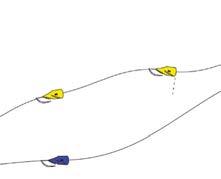

Green, on starboard tack, invited Red on port to cross. That’s what both intended, but Green misjudged their duck, and hit Red close to the transom. The collision caused damage, and both retired as a result. A hugely apologetic Green o ered to witness, in a protest, that they intended to pass behind Red but made a mistake. Red protested Green for breaking rule 14 (avoiding collisions), which is a rule of Part 2. As Green had retired, there was no further penalty. As their score was made worse by damage through an action of a boat that was breaking a rule of Part 2, Red requested redress. (Rule 62), One of the conditions of this rule is that the score is made worse “through no fault of her own”. The jury found that Red had some fault, because they were keep clear boat, so no redress was granted. The results stood. Port tackers beware!
//box out at the very end//Keeping out of trouble at the committee boat
All four starting strategies are potential race winners. Minimise last minute hiccups by practising the approach and getting a good feel for the e ect of tide and windage at slow speed. If approaching on starboard tack, try several dry runs, and pick up a land transit through the stern of the committee boat to nail that approach layline. And always keep rule 15 (acquiring right of way) and rule 16 (right of way boat changing course) in mind when manoeuvring closely against the other boats.
Winter sailing is a great opportunity to refine your skills, as cruising expert Clive Loughlin reveals…
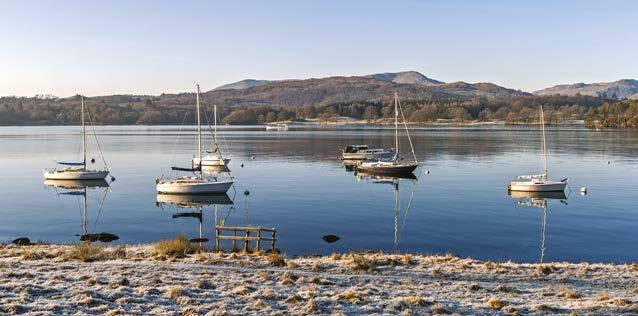
As the nights draw in and temperatures cool, you may be forgiven for thinking that it is perhaps time to hang up the oilies and lock up the boat at the end of another season.
Think again! – this can actually be the best time of the year to go sailing.
I love this time of year - the crowds have gone home, marinas have a choice of easy berths and the ‘hotspots’ of summer can now be appreciated in all their glory for the truly beautiful places they really are.
But how does the season a ect what we do on the water?
Average wind speed is F4 (moderate breeze) in November as opposed to F3 (gentle breeze) in July and August.
F4 is something I can really enjoy – the sails are nicely filled and the boat can make good progress on its allotted mission. Whereas in the cruising yachts I teach on I always find F3 a bit frustrating, and with reduced learning opportunities. Throw in a good chance of an F5 and I am in sailing heaven - and the crew still have smiles on their faces.
I also love night sailing and find this is often a highlight of the week. Being on the water in daylight is something most crew will be pretty familiar with, and in summer most boats are safely tucked up in a marina and the crew in the showers before it gets dark.
At this time of year it gets dark early and I like to hole up somewhere for a rest and tea and crumpets, then
head out for a few hours of night sailing before settling down for a very cozy dinner on board.
Sailing at night is not just sailing in the dark – instead you are transported to di erent world. It can be a bit scary at first, but crew are very soon revelling in the new challenges, and just how ‘di erent’ everything seems.
Distances are hard to judge, and that north cardinal you have been heading towards for seemingly ages, is suddenly just meters o the port bow. Big container vessels that are visible for miles in daylight are suddenly reduced to pin pricks of green and red lights that are no di erent to those carried by cruising yachts a tiny fraction of their size.
Nature also comes to the fore, with the Moon, stars and planets that hardly feature in our light-polluted lives at home, suddenly taking centre stage.
Even well trod channels in the approach to our home berths demand greater respect – you notice things more as your senses become heightened by the challenges ahead.
For sure it’s getting colder, but these days of multi-layered clothing are more than a match for it. Start o wearing more layers than you think you really need, with a neck mu and woolly hat to smother you in cozy self-kindness; a good collection of gloves to suit the current activity –oh – and don’t get cold feet.
Susan Koning has several years of experience living on board and exploring exotic destinations. As such, she knows that the most valuable thing a blue water sailor can have is experience. Here she o ers some vital tips to increase confidence and comfort of living aboard. This month, storms…

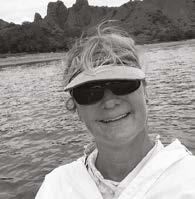
Storms are inevitable. Today’s technology allows for much better weather predictions and that is all it is - a prediction. The number one rule is to ‘wait for weather’, i.e. wait for favourable winds to take you to your next destination. Don’t be pressured to leave on account of someone else’s timeframe.

It’s always good practice to secure anything that could fly o the tables or shelves prior to departure; you never know what the sea state is until you’re in it and then it’s usually too late.
The old saying holds true; if you’re thinking about reefing it’s probably too late. Reef your sails early in anticipation of bad weather. Consider reefing before nightfall so you don’t have to clamber onto a wet deck in the dark to adjust your sails. Always keep one hand for the boat and move in calm and calculated movements as you support yourself in rough seas and stabilise yourself from the jostling shifts of the boat.
In the event of a lightning storm; my advice is to be prepared to stow your most vital electronics (phones, tablets, handheld GPS, etc) in the stove.
This is a good time to find a secure place in the cockpit (tethering yourself to a secure place) or tucked into a berth with a lee cloth.
Always have your emergency grab bag handy should you need to abandon ship: EPIRB, flares, water and passports are just a few of the things you’ll want to always have ready in a waterproof bag. Knowing that you and your crew have a good understanding of your emergency equipment and MOB manoeuvers will help alleviate anxiety.
Rest assured storms don’t last forever; with good preparation and a little prudence you will get through it with have an adventurous story to tell at the next watering hole. Follow Susan’s adventures via sailingshenemere.com








We start the season with Barbados Sailing Week in the middle of January, then across to Grenada for their event. Next up is the Caribbean 600 with a new format, including three one day races, before the main event on the 20th February.



The season continues with the Heineken St Maarten, St Thomas, the 50th running of the BVI Spring Regatta, then Les Voiles de St Barts, finishing with Antigua Sailing Week in May. 9th May 2023 sees the return of the Antigua to Bermuda offshore race.

We have individual, small group and whole boat charters available - all levels of experience are welcome.





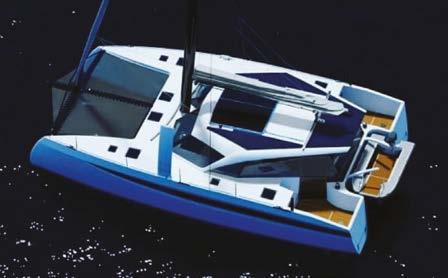
For more information or to book your place, go to www.ondecksailing.com Email: peter@ondecksailing.com WhatsApp: +1268 720 5313

Two years ago, at the age of 15, Tim Long sailed solo around Britain. This year, Tim began a new chapter of his career, gaining experience in the highly competitive French Figaro class; which has bred all but one of the Vendée Globe winners. His long term aim is to pursue a career in professional solo o shore racing. Here he shares his tips for cruisers and racers alike…

When it comes to adapting your boat set-up for solo sailing, the key is to optimise the boat to how you sail because everybody sails di erently! If you look at the Figaro fleet lined up before a race, despite the boats having exactly the same specification, each skipper has set it up in their own way.

Think about modifications to prevent trips out of the cockpit; for example, halyards and reefing lines often get kinks in the blocks at the mast foot. A loop around the mast, with plastic rings whipped (attached) to it, can stop this: by passing each halyard through the rings they de-tangle before reaching the blocks.
Bungee cord is your new best friend! It can be used in so many places; for example, attached to a tackline to retrieve it from the end of a bowsprit. 3M Dual Lock Velcro is very handy too, use it to secure anything that might go flying, e.g. portable VHF, hand-bearing compass, etc.
Finally, martin breaker systems on spinnaker tacklines are great for racing and a good safety feature for cruising boats. A simple internet search will explain how to make one.
A huge part of solo sailing is about looking after yourself, because it is so easy to prioritise the boat.
Cockpit bags near the helming position allow you to keep water and food within arm’s reach. Added to this, don’t have one water bottle, have four –that way there will be a chance that one of them will always be full!
When I was sailing around Britain, I knew that sleeping in busy coastal waters was a risk. A bean
time to get his grab bag before the boat sank. Also, it is critical that you have safety knives to hand, one attached to the tiller and one in the companionway - you never know when you might need them!
When it comes to boat-handling during manoeuvres while solo, it’s crucial to slow it down and think in advance (which is something I really struggle with as an impatient teenager!)
When I was sailing around Britain, I found it so important to take the stress and strain out of manoeuvres in any way possible. For example, letterbox dropping a spinnaker, or taking up the mainsheet with the traveller down, and then pulling the traveller back up.
bag is really useful. They can be ‘moulded’ into any part of the boat, which allows you to monitor progress by the nav table or companionway whilst cat napping.
Safety wise, what I have learnt this year is the importance of where safety kit is kept. In the previous Vendée Globe, Kevin Esco er didn’t have

When manoeuvring solo, you often have at least five things to do at once! A particular technique I was taught was not to focus on finishing each job before moving onto the next; this helps you to get back to top speed faster. For example, when you tack, only partially wind in the jib, then grind on the new backstay and trim the main, alternating between them until fully trimmed. Sailing single-handed forces you to focus like nothing else. From preparation to seamanship it tests everything to the limit, but the rewards and satisfaction are huge. Enjoy! Follow Tim via Facebook & Instagram @timothylongsailing and at timothylongsailing.co.uk
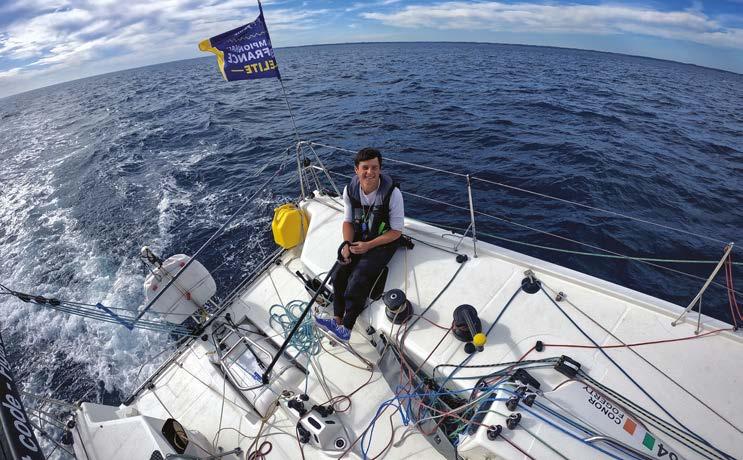
Ante Razmilovic explains how key decisions in a nail-biting final race saw him become Etchells World Champion…..
Hosted by the Royal Yacht Squadron, the Etchells World Championship saw 42 boats from nine nations compete in a closely fought nine-race series that was dominated by high pressure and strong tides.

From their opening score of 35th in race one, Ante Razmilovic’s Swedish Blue (GBR 1438) seemed an unlikely winner, despite having previously been in close contention for the Worlds title. But with the shifty winds and an extremely high calibre of talent in this competitive one-design fleet, made for a high scoring regatta, and by the final race a tenth place was enough to secure for Ante and crew - Noel ‘Nitro’ Drennan and Brian Hammersley - to secure the title.
But it was no easy ride. With two races earlier that day in 12-14 knots, the shifty northerly had dropped to just 5-6 knots for the start of the final race, with a building cross tide. Ante knew they needed to finish within nine places of Anatole Masfen’s New Order (NZL 1499), but frustratingly they lost touch with their rivals just before the start, finding themselves atp at opposite ends of the line.
Ante takes up the tale: “It wasn’t a good start. We started towards the committee, but the guys underneath us were black flagged. We took the right hand side of the course and were looking like we were either in the top three or in the last five. At windward mark, the Kiwis were third, but we were no better than 20th so not in good shape. But the fleet was compressed and so there wasn’t a lot of distance between the lead five boats and where we were.”
Next came a couple of key decisions that ultimately put them where they needed to be, as Ante explains: “We elected to gybe at the spreader mark, mainly to get away from the pack in front of us; there was a little bit more pressure on our side as we gybed over and we worked our way up to about seventh or eighth pretty quickly. It was pretty tight down the first run on points and fortunately we were pretty rapid downhill. So we just hung on, didn’t do anything too fancy, and made sure we had a clean rounding at the bottom gate where we took another three or four boats.”
That was crucial. Now, heading upwind within touching distance of their rivals, the Kiwis came back in from the left and still just held the advantage on the cross. But by the finish, Ante and his team had overhauled them to win in style. Delighted, Ante expressed his relief at victory in a class where he says, “the margins are really thin”.
“Overall, it was a really tricky week. We started with a 35th and people like Lawrie Smith (GBR), Peter Duncan (USA), and Stephen Benjamin (USA), everybody scored pretty big points, so it was tricky tactically in all of the races, particularly some of the lighter air races, but in keelboat racing, boat speed is always king.”
Go green this winter and give your boat some TLC that benefits the environment too. We find out how from Phil Horton, RYA Environment and Sustainability Manager as The Green Blue Boating Pledge launches - a new initiative helping sailors navigate a more sustainable approach...
A thorough wash down is top of the list when preparing your boat for winter. How can boat owners ensure they are washing down responsibly?
The best option is to find a ‘bunded’ washdown facility. These trap any waste and filter out any chemicals (and invasive species!) before clean water is returned to the sea. Marinas and boatyards with bunded washdowns can be found via The Green Blue facilities map: thegreenblue.org.uk
What sorts of products would you recommend using to protect your boat? Are there any precautions you should take?

Traditional biocidal coatings that wear away through the year are the most damaging to the environment. Multi-year coatings that either have low rates of loss, such as CopperCoat, or are slippery rather than poisonous, such as Hempel Silic One, are far better for the environment and require less maintenance. However, the up-front costs are higher, as professional application is most e ective, and you may need to spend time and money preparing the boat prior to application. New products are coming to the market in the
All new boats have to have holding tanks fitted to prevent blackwater discharge. Should owners consider retro-fitting one?
Ideally boaters should use a holding tank. Most of us don’t get far enough o shore during a weekend to safely pump out at sea, and we should in any case be minimising pollution. The real challenge is finding a pump out facility. The Green Blue lists these on its facilities map (link above).
What else should sailors think about now that will help ensure a more sustainable approach to sailing in 2023?

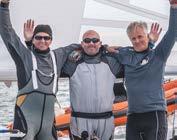
Research your planned destinations and check if there are any changes such as voluntary no anchor zones that are being put in place to protect remaining seagrass and other sensitive habitats. Service your engine to make sure it is running at its most e cient. Make sure that your water tank is cleaned and any filters replaced to make sure you are happy to use it when on board, rather than taking plastic bottles of water with you.
When cleaning ready for the season, use eco-friendly cleaning products. There are special boat cleaners on The Green Blue Business Directory, thegreenblue. org.uk/green-blue-business-directory/products/, or you can use normal household eco-products such as Ecover and Bio-D.
There are plenty more steps that sailors can take! Find out more and sign up for The Green Blue Pledge via thegreenblue.org.uk























































It was your first Transatlantic – did it live up to expectation?
Yes, it exceeded them! I enjoyed every second I had onboard, even the less pleasurable moments. We had fantastic weather for aTransatlantic; it was a really good trip.
Sharing my watch with Simon Fisher (who will be our team’s navigator in The Ocean Race next year and hero of mine since I was little) and with Justine Mettraux (sailor for us in The Ocean Race next year and soon to be competing in the Route du Rhum on her own IMOCA). Being able to learn and quiz them both on ocean sailing in that context was really unique.
Just having that length of time onboard sailing and learning from everyone and getting to know the boat was also a highlight. As Shore Crew we spend a lot of time on shore and less time on the water and I really enjoyed seeing everything in action.
Having time away from the ‘normal world’ being o shore was almost themost relaxed and serene I’ve ever felt,which is strange when you think about it.
We had really good conditions, so that part wasn’t so testing which it really easily could have been; we know the Bay of Biscay can be notorious and we

were lucky to stay ahead of a severe front that chased us home.
One of the biggest challenges I felt was just looking after yourself, even just small yard work scrapes and cuts can get infected so easily so that was a good lesson and one to remember.
interesting. Also, experiencing the Trade Winds and the constant transformation in the weather around us I found fascinating.
How did you ensure the trip adhered to the team’s sustainability principles?


As a team we hold our sustainability principles at the heart of everything we do. It’s the small but consistent actions that matter. We try to eliminate single-use plastic, and we also arrived into Concarneau with everything we started with and our waste from the trip was weighed and then sorted and disposed of accordingly. As a team we also calculate and o set our Carbon Footprinteverything, absolutely everything we do is rigorously scrutinised and we hold ourselves to high standards both on shore and o shore.
Was there anything in particular that you learnt? Weather interpretation really stood out to me throughout the trip - the comparison from what you see from the boat to the GRIB files and forecasting we download onboard was really
Send it, enjoy it, stay safe, and drink lots of water!
Follow 11th Hour Racing Team’s campaigns via 11thhourracingteam.org

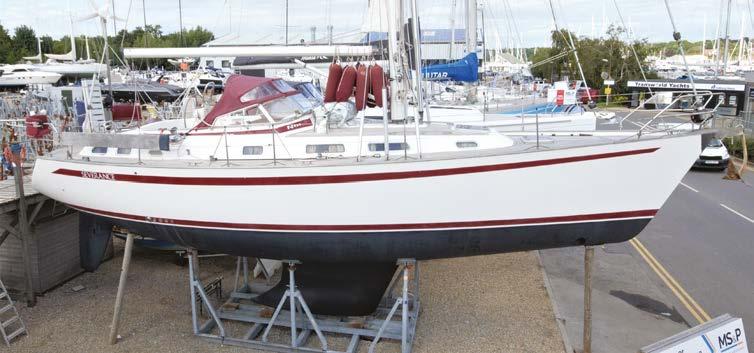
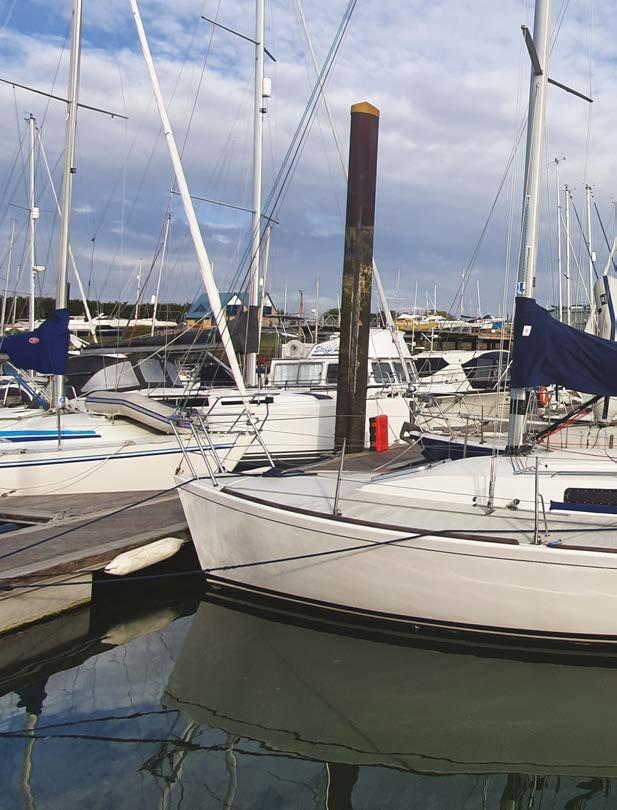
This fine example of a 2001-built Najad benefits from only one owner. Severance has the standard configuration. Down below she has a double berth in the forward cabin, and large double island berth in the aft cabin, both with adjacent heads. The best way to capture the essence and appreciate the opulence of the Najad 400 below, is to recline in one of the comfortable armchairs in the saloon, relax and gaze around at the mellow tones of the beautifully finished unstained mahogany joinery. The attention to detail is what you would expect from this trusted Swedish brand, with features such as lights inside each hanging locker, and red night lights at foot level. She has an extensive sail wardrobe including a 2019 Kemp in-mast furling mainsail, 2018 Kemp roller furling genoa, gennaker, staysail, storm sail, emergency mainsail (2003 – never used), riding sail, and squeezer for spinnaker and cruising spinnaker. Additional extras include a Quicksilver Air deck 3m dinghy complete with a Suzuki 2.4 hp outboard.
The J/92 is a fantastically fast and fun cruiser/racer that combines the best of racer and cruiser without the drawbacks of either. It combines essential overnight capability and privacy below, comfortable, large cockpit and simplified sailing system of the cruiser, with the response and acceleration of a finely tuned racer. J-Boats has proved itself in both shorthanded and fully crewed racing. In her current ownership since early 2019, Jackal has been raced on the River Crouch, and has been very successful, winning the prestigious Burnham Week Town Cup in 2019, Burnham Week mid-week points in both 2019 and 2021, and Burnham Sailing Club season’s points in 2021. She had a new set of rudder bearings in 2021, and has been racing o an IRC handicap 0.964 in 2022. A great way to get in to either coastal or o shore IRC racing.
Year: 2000
Length: 9.15m (30’)
Beam: 3.50m (10’)
Draft: 1.52m (5’ 11”)
Displacement: 2,495kg
Hull: Glassfibre
Engine: Volvo 10hp MD2010 SailDrive
Designer: Rod Johnstone
Accommodation: 6 berths in 2 cabins
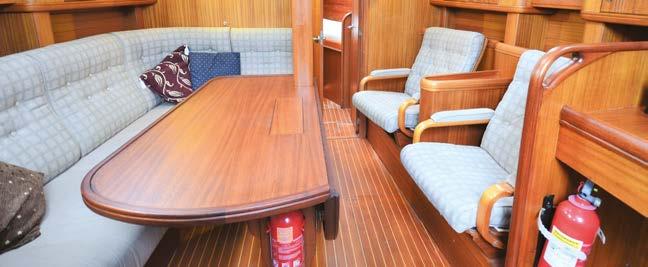
Location: Burnham-on-Crouch, Essex
Contact: clarkeandcarter.co.uk craftinsure quote : £660.80
Special Solaris 72 Deck Saloon from Doug Peterson, built to circumnavigate the globe for the legendary sailor, Enrico Tettamanti. Together they completed a five-year circumnavigation, cruising the Arctic together with a transit of the Northwest Passage from west to east. Plum was designed to sail her crew in comfort and safety, both in high latitude and in the tropics. She comes with berths for 11, and a protected deck house. Now refitted, Plum is the perfect mile muncher for epic adventures.
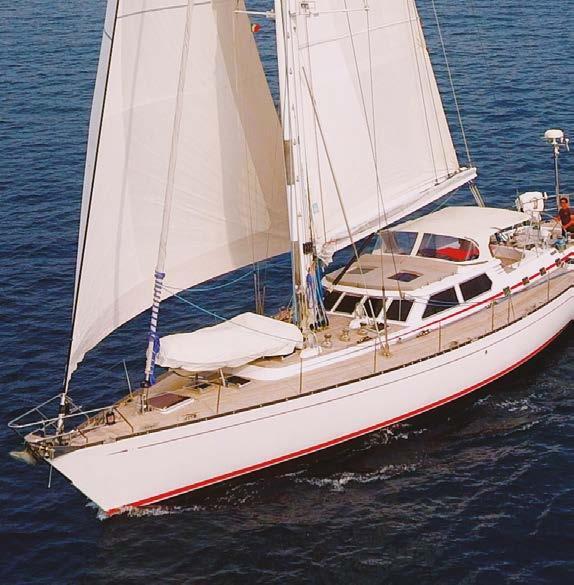

Year: 2002
Length: 21.55m (70’8”)
Beam: 5.63m (18’5”) Draft: 2.90m (9’6”)
Displacement:43,000kg (94,798lb)
Hull: Glassfibre
Engine: 1 x Volvo Penta TAM 63D
Designer: Doug Peterson
Accommodation: 11 berths in 6 cabins

Location: Near Trieste, Italy Contact: berthoninternational.com craftinsure quote£POA
Insure your yacht with Craftinsure - boat insurance at the touch of a button. Get a quote online or call today: craftinsure.com; 0345 2607 888


ALBACORE 8212. Excellent lightly-sailed FRP Ovington with ‘Oxford’ blue hull, Superspars boom, M2 mast and flyaway pole, fully adjustable rig, P&B sails with less than 20 hours use, Milanes foils, padded rudder bag, top cover, cocoon trailing cover, trolley, minimum weight with correctors, measurement certificate - ready to win. £7500 Tel 01993 772966 / (OXFORD)


outboard. Full recent survey - yard trolley available. Must be seen. £5500 Tel 07765 900259 / (CARDIFF)




MUSTO SKIFF 601. Complete & ready to sail. Brand new sails plus Bluewave lower shrouds, launch trolley, top/ bottom cover & foil bag. TRADE. £9000 Tel 0191 2576011 / (WEYMOUTH)

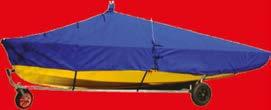
RS800. Well maintained boat.



2018. 1 set racing sails,black square top main and jib in photo plus kite. 1 suit training sails and kite. Recent new trolley. Foils with bags. Lots new ropes/ continuous control lines. Top cover. Carbon tiller. Trailer road base/u cover optional extras. £2250 Tel 07853 971336 / (EMSWORTH )
TOPPER TOPAZ UNO. Topper Topaz Uno Race X s/n 4413 Main sail, Jib Sail, Spinnaker, Training sail. £1000 Tel 07967 813579 / 01749 671456 (CHEDDAR)

LASER 209059. New 2015. Sailed four times in last three years. Selling for health reasons. Full rig plus Radial. Sail bags and foil bag. Two rudders. Two carbon tillers and two carbon extensions. All Harken. Combi trailer has done less than 100 miles. Banks cover and under cover. . £3850 Tel 07788



















Blue water cruising can be hectic but it also o ers long periods of peace to enjoy the finer things in life - such as cloudspotting
Living on a boat bestows upon you an extraordinary relationship with the sky. e sheer expanse of it, greeting you each morning, makes your relationship with its uctuating moods and rhythms both intimate and extensive. You have to engage with the sky in the same way that you have to engage with the water; a er all, it makes up half of your backdrop when living at anchor.
And in the same way the sea’s ever-changing temperament and colours have always fascinated me, so too do the patterns and shapes, textures and light of the clouds captivate and absorb my attention as another layer of patina that guides our boat experience.

I like to start each day with popping up on deck, just to assess what the world looks like today. Even when we’ve been in the same spot for a long time this is in constant ux and sets the pace for what our plans will be. Today the sky is a bright, saturated azure blue, ecked with eecy patterns of white shimmering clouds. is painterly, dappled e ect, gives the morning light a magical quality and I decide to sit and linger on deck, sipping my tea. Sure, the scienti c side of my brain could be thinking about the rippling layer of cirrocumulus and the potential warm front and chance of rain later that they may herald, but today I’m drawn to the more romantic notion of the name ‘mackerel sky’. So-called because of the lines of clouds resembling sh scales, or even sh shoals some say. And my sleepy brain is playing with the comforting and charming concept of sh both above and below us.
On our most recent sail, a half day trip down to a nearby island anchorage, the sails were set nicely and I stood at the helm gazing upward, assessing the sky. is time it was a pale cerulean (and yes, I’m very particular about my colour hues) marked with high-up cirrus clouds. I like that these are the clouds that can indicate change, and marvel for a moment that we interpret clouds well enough to know that, when my eldest daughter comes to join me in the cockpit. She asks what I’m looking at and I explain about these lines and wispy strands, how they’re actually made up of ice crystals, how the strong winds blow them into these streaks and streamers, that swoop like aeroplane trails. en I
tell her that they are sometimes called ‘mares tails’. “Maybe they’re the tails of the white horses on the waves, mama?” She says simply, connecting yet another animal weather metaphor for me, and then skipping back down below, leaving me pondering all sorts of horses. en there are days when we are greeted by a blanket of cloud. It smothers almost the entire sky, di using any light from the sun, and paints our surroundings dove grey. is deepens and darkens to slate, and the water below goes steely, re ecting back the gloomy mood of the clouds. ese are the nimbostratus, an undulating layer of murkiness with no pattern or shape, just a heavy mass draped overhead, now choking any glimmer of sunshine. e blanket of this cloud layer brings out the blankets from our cabins as we declare that it’s time to hunker down, close the hatches, and maybe build a den to snuggle up in instead of heading outside for a while. e inevitable rain from this giant sprawling cloud layer is steady and set-in, clearly planning to stick around for hours yet. e monsoon rain season produces even more impressive downpours from the huge boss of the clouds: the cumulonimbus. ese start o as oversized big billowy white cumulus clouds, which bunch up more and more, stacking higher and higher until they are gargantuan, towering forms, forbidding and ominous, growling with angry thunder rumbles. e bottom may be totally at or ragged, glowering a dark grey, and the sky behind this edge may take on a strange orangey brown hue, a Yorkshire tea colour. We watch the dark plumes of rain streak down from various points along this monster and jump at the blinding sudden lightning ashes and forks that hit the water underneath.
And I mustn’t forget our most common sight, the pu y, friendly-looking fairweather cumulus, that my husband calls ‘Simpsons’ clouds. ese roam about the baby blue sky like so ly grazing sheep – yet more animals to include in my cloud menagerie.
I’m most fond of these creatures when the sun begins to dip and their cotton wool anks become tinged with hot pink, orange and gold, their tops tinted purple as another cloud-spotting day draws to a close.
‘Today the sky is a bright, saturated azure blue, flecked with fleecy patterns of white shimmering clouds’




